



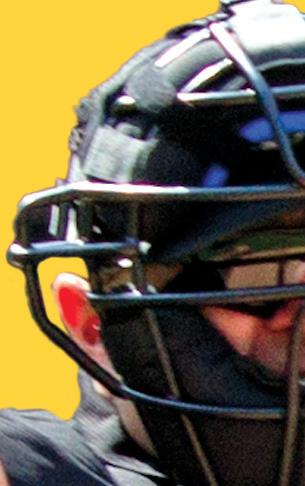
















HIRING Always your voice since 1976 $6.95 member edition TRUTH BE TOLD GAME AIN’T OVER BASKETBALL THICK SKINNING ALL SPORTS HEAR WE GO SOCCER DO WHAT BETWEEN PITCHES? SOFTBALL MULTIPLICATION TABLE FOOTBALL NFHS NEW RULES VOLLEYBALL SAFE SPORTS FRONT & CENTER
STRIKETHREE! BASEBALL P.44 P.76 P.24 P.36 MAY 2024 // REFEREE.COM
YOU READY FOR THE NBA?

FEATURES
24 PIPELINE TO THE NBA
Officials eager to work at the highest level have access to tools and training like never before.
36 ALWAYS HIRING Too Few of Us, But No Easy Solutions.
48 SAFER SPORTS
Keeping athletes safe from abuse is the aim of the U.S. Center for SafeSport — and officials play a role.
76 12 TIMELESS TRUTHS
Our list of “timeless truths” are nuggets of wisdom for all sports officials. Enjoy.
ON THE COVER
Alex Sanchez Echo Park, Calif.
Age: 28
Occupation: Personal trainer
Officiating experience: High school baseball umpire for 10 years. Also umpires college baseball (up to D-II level). Umpired the California Community College Baseball Regional in 2018.




SPORTS
COLUMNS
7
Father-Daughter Duo Make Officiating History; Balancing Act; Tullamore Tribute
82 FOR THE RECORD
MLB Spring Training Umpires; UFL Roster
84 LAW
Ignore Liability Matters at Your Own Risk; What’s Worth Saving?
85 CLASSIFIEDS
Camps/Clinics/Schools; Equipment/Apparel; Leadership Resources; Training Resources
86 LAST CALL
Good Cop, Bad Cop: “When it comes to players, approachability along with a sense of compassion can go a long way toward parents thinking twice before complaining about your work.”
BASKETBALL HIGHLIGHT THIS MONTH



Find Referee Magazine on Facebook and follow RefereeMag on X Volume 49, No. 5 Issue 571 MAY 2024
CONTENTS
16 BASEBALL Caught ... or Consequences: Dropped Third Strikes Raise the Stakes; Partner Down, Now What?; They’re Both Yours 30 BASKETBALL Crunch Time Is Clutch Time: The Plan for Endof-Game Situations; Don’t Fear the False Double Foul 42 VOLLEYBALL NFHS Adopts New Rules: Line Judge and Prematch Protocols Highlight Changes; Opining on Offseason Opportunities 52 SOFTBALL Outside the Box: An Inside Look at Illegally Batted Balls; The Time Between; Don’t Bluff 62 SOCCER Hear We Go: Communication That Connects With Today’s Coaches; Forged by Failure; About Face 68 FOOTBALL Multiplication Label: Plays That Have More Than One Aspect; Pregame on the Field; When It’s All on the Line 78 ALL SPORTS Sound Advice: Developing a Thick Skin Against Verbal Abuse; Meant to Be a Mentor?; Prep for the Unusual 4 PUBLISHER’S MEMO Walking That Fine Picket Line 10 THE GAG RULE Letters: Testing Critique; They Said It; Survey Says 12 THE NEWS PRO Locks Out MLS Referees; MLB Umpire Ed Hickox Retires; NBA Referee Jerseys Carry Emirates Patches
GETTING IT RIGHT MLB’s Military Mission; Elmira’s Elite; A Young-er Generation
60
4 PROFILES
HESTON QUAN (COVER), COURTESY OF THE NBA, DALE GARVEY (BASKETBALL)
20 In the closing minutes of a tight game, it’s good practice for the official nearest the scorer’s table to communicate with all necessary parties to ensure an accurate finish to the contest.
FOR MORE, GO TO PAGE 30

Walking That Fine Picket Line

Almost 50 years ago, I was sitting in a hotel ballroom in Tulsa, Okla., with 30 or 40 other basketball officials. We were at the preseason clinic for a D-I college conference we worked. It was, for most of us, our primary conference. That particular meeting, that particular morning, has never left me.
The commissioner had come into the room to welcome us to the upcoming season. He then asked us to introduce ourselves. One by one, we did just that. When it was my turn, I simply stated my name and the town I lived in: Franksville, Wis. Just as I finished my words, the commissioner loudly added: “And he is the publisher of Referee magazine and the president of the new National Association of Sports Officials (NASO).” I cringed, wanting to keep my personal and professional officiating lives as separated as possible. Guess I was damned naïve.
But here is what I remember most about that meeting. The supervisor of officials had received from our group, prior to the meeting, a request having to do with increasing game fees and expense reimbursements. He was a former renowned collegiate basketball and football official, so we felt we might get a sympathetic ear. Well, we guessed wrong!
After the commissioner left the room, our supervisor took the floor. He went over a number of mundane matters and then chose to address our typewritten request, which he held in his hand. The short answer to the things we requested was a resounding “No!!!” Then he looked around the room and for the second time that morning, I experienced something I still have not forgotten to this day. He looked at us and said: “If any of you don’t like it, there will be someone else sitting in your seat next season.” And that is a quote, one I obviously have never forgotten.
The end result of those “negotiations” was that we worked for
the same game fees and expenses not only for that season but for the next two seasons because our association of conference officials didn’t have the bravery and the guts to make anything else happen. That burned me and most of us. I have had a particular interest in the size and manner of our compensation ever since. I watch with intense interest anytime a group of officials withholds services or walks a picket line in hopes of improving their conditions. In my heart of hearts, I am standing with them.
The decades since have whisked by and here we are: Referee and NASO considered to be the leading advocates on behalf of sports officials. The magazine is the journal of record for officiating. NASO is a 501(c)(3) not-forprofit educational association. What it does not do is involve itself in matters of labor negotiations and employee rights. NASO cannot go there, by its charter.
There are those who believe this magazine and NASO are not doing enough to support the unions of sports officials that exist, mostly at the professional levels. They believe the magazine should never even show a single picture of a replacement official, or publish a news story or journal piece about the replacements hired. Any story in this magazine should be about the union and what it is striving for, with no reporting on what the counter-positions are by the league or conference.
Let me reiterate: The magazine is here to advocate sports officiating and to support officials within the guardrails of responsible, in-depth and balanced reporting. That means there will be those times when a story/ news item needs to vet the issues and the responses from all parties. That is our journalistic duty. Yet never forget where our hearts truly are … with those officials who are standing up for better treatment and more respect.
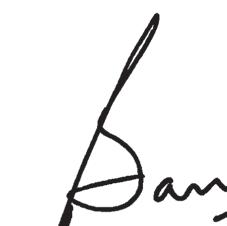


MEMO Watch the video at referee.com/pubmemo 4 | REFEREE May 2024 Chief Strategy Officer/Publisher Barry Mano Chief Operating Officer/Executive Editor Bill Topp Chief Marketing Officer Jim Arehart Chief Business Development Officer Ken Koester Editor Brent Killackey Senior Editor Jeffrey Stern Associate Editors Joe Jarosz Brad Tittrington Scott Tittrington Assistant Managing Editor Julie Sternberg Assistant Editor Brad Star Copy Editor Jean Mano Director of Design, Digital Media and Branding Ross Bray Publication Design Manager Matt Bowen Graphic Designer Dustin Brown Video Coordinator Mike Dougherty Comptroller Marylou Clayton Data Analyst/Fulfillment Manager Judy Ball Director of Administration and Sales Support Cory Ludwin Office Administrator Garrett Randall Client Services Support Specialists Lisa Burchell Trina Cotton Noelle Vaillancourt Editorial Contributors Jon Bible, Mark Bradley, George Demetriou, Alan Goldberger, Judson Howard, Peter Jackel, Dan Ronan, Tim Sloan, Steven L. Tietz, Rick Woelfel These organizations offer ongoing assistance to Referee: Collegiate Commissioners Association, MLB, MLS, NBA, NCAA, NFHS, NISOA, NFL, NHL, Minor League Baseball Umpire Development and U.S. Soccer. Their input is appreciated. Contributing Photographers Ralph Echtinaw, Dale Garvey, Carin Goodall-Gosnell, Bill Greenblatt, Jann Hendry, Keith Johnston, Jack Kapenstein, Ken Kassens, Bob Messina, Bill Nichols, Ted Oppegard, Heston Quan, Dean Reid, VIP Editorial Board Mark Baltz, Jeff Cluff, Ben Glass, Mike Graf, Reggie Greenwood, John O’Neill, George Toliver, Ellen Townsend Advertising 2017 Lathrop Ave., Racine, WI 53405 Phone: 262-632-8855 advertising@referee.com REFEREE (ISSN 0733+1436) is published monthly, $49.95 per year in U.S., $84.95 in Canada, Mexico and foreign countries, by Referee Enterprises, Inc., 2017 Lathrop Ave., Racine, WI 53405. Periodical postage paid at Racine, WI and at additional mailing offices. Postmaster: Send address changes and undeliverables to REFEREE, PO Box 319 Congers, NY 10920. Direct subscription inquiries, other mail to REFEREE, PO Box 319 Congers, NY 10920. 1-800-733-6100. © 2024 Referee Enterprises, Inc. All rights reserved. (USPS Publication #107790.) Subscribers: Send address changes to REFEREE, PO Box 319 Congers, NY 10920.
PUBLISHER’S






















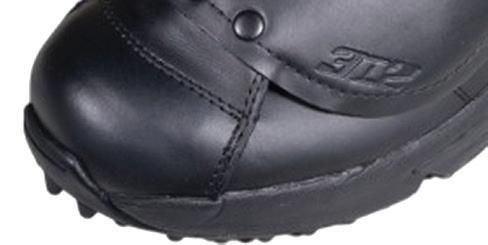




Now with 4 Brands in the Plate Shoe Lineup Find the Largest Selection, Sizes & Stock! Mizuno Pro Wave Mid-Cuts Smitty Mid-Cuts New Balance V3 Mid-Cuts (2 Color Options) 3n2 Reaction Pro Low-Cuts (3 Style Options) Find the Largest Selection, Sizes & Stock Here!

Cheers for the LMCCOA! Association Gives Time and Talents to Benefit Others
Jane Plaisted thinks it’s one of those rare high school sporting events where scores and winners are secondary.
Instead, the focus of the recent Lake Michigan Competitive Cheer Officials Association meet is what the event could do for 75 seniors who competed in the sprawling 45-team meet at Byron Center.
All proceeds from the event went to fund scholarships for seniors who opted to write essays and then competed in the annual 22-year-old, three-division meet. The competition, which was completely run by LMCCOA judges, raised $21,000 to up its fundraising total to over
$200,000 since the meet originated in 2001.
“It was a glorious day,” said Plaisted, an LMCCOA member who has participated in 15 of the competitions. “The girls are happy, we’re happy to give our time and it’s such a positive day. We love being a part of it.”
The event drew teams from as far away as St. Johns, DeWitt, Kalamazoo and Howard City Tri County. The chance to earn scholarship money was open to all 190 seniors who competed, and 75 chose to write an essay about “talking to their younger self and determining how competitive cheer has helped the athlete,” said
Stacy Smith, the president of the Michigan Cheer Judges Association. Smith said much of the event’s dual goal is to promote competitive cheer while helping senior athletes wherever there is a financial need.
The meet started with just five teams and a few hundred dollars in scholarships in 2001, but has blossomed into one of the largest single-day high school sports fundraisers in the state. The meet, which has been held at Byron Center three times as well as schools such as Caledonia and East Kentwood, reached a peak of raising $25,000 a year ago.
What makes the day particularly special, Smith said, is that between
6 | REFEREE / MHSAA May 2024
C
MHSAA official Jane Plaisted takes a photo with this year’s LMCCOA Division 1 scholarship winners.
Several officials contribute to making the meet an unforgettable experience.
50 and 70 members of the LMCCOA annually show up to donate their time without knowing how their abilities will be put to use. In addition to judging the meet, members handle virtually every other aspect of the competition, from taking tickets, working the concession stand, filling water bottles, scoring, running a 50/50 raffle and whatever else organizers can find for them to do.
“Cheer athletes aren’t always recognized a lot for their work, but it’s a sport where (Michigan) colleges have gained notoriety at the national level and now offer scholarships,” Smith said. “It’s become a big deal in the state. Division I and II schools and NAIA schools all offer scholarships now. This can help.”
Seniors who choose to participate write their essay prior to the meet, and then a committee of judges pore over the writings during the meet. Winners are announced following the competition. Twenty-one seniors were awarded scholarship money.
Smith said few parents probably grasp how much detail goes into running a long, grueling Saturday event.
“I’m not sure if people realize all the hands that have to make this happen,” she said. “We’ve been doing it for 20 years, and for us it’s like riding a bike. You never forget. It’s just a wonderful day.
“I’m not surprised people want to be part of it and step up wherever they’re needed.”
Plaisted said judges sign up for jobs when they arrive at the meet. A judge can be officiating an event one minute and selling hot dogs moments later. The ‘work wherever needed’ attitude of judges, she said, is what makes the event a popular destination for participating schools.
“As officials, we emphasize young women participating,” she said. “That old concept of the dumb blonde cheerleader doesn’t exist anymore. This is an accomplished group of girls who we support. If you talk to any of

(the judges), this meet is one of the most fun things we’re going to do all season.
“It’s become so popular. We gave away like $50 the first year, and since then we’ve grown from one long day to two sessions so we could increase the number of teams. Everyone goes home with a smile on their face, which for officials doesn’t always happen.”
Paw Paw cheer coach Stefanie Miller, whose team won the Division 3 portion of the meet, said coaches look forward to taking their teams to the meet.
“Absolutely because it’s all about community,” she said. “We talk to the girls about service and giving back. It’s definitely a teachable moment, not only for the kids but for the adults, too, knowing what goes to the seniors.”
“What I like best is that it promotes the athletes and all the work they put in. It’s about giving back to them,” added Brighton coach Christina Wilson, whose team won the Division 1 competition. “So many teams want to attend, and the coaches want the players to have a chance at a scholarship.
“I’m just in awe of seeing so many people there who are willing to give their energy for the kids.”
One of Miller’s favorite parts of the meet is watching fathers do a cheer “jump off” of their own tonguein-cheek cheering skills while waiting for the final scores. She also loves volunteers making nearly 200 bows for participants to wear during the meet.
“Fathers do these cheerleadertype (routines) while there is a lull and it’s just great,” she said. “It’s fun stuff like that that makes the day so special. It’s all about giving back.”
quick tip
If you told a coach you’d check on a rule, do it. Get back to him or her as quickly as possible. Don’t gloat if your original ruling proves correct; explain the ruling as if you had nothing to do with the call. If you made the wrong call, admit it. Most coaches respect officials who admit errors, and doing so adds to your credibility. Caution: Too many errors is a problem.
REFEREE / MHSAA May 2024 | 7
Crew Glue
Teamwork,
Teamwork, Teamwork
When any game assignment arrives, all sorts of questions usually race through an official’s mind. First, who’s playing? Great teams? A rivalry game? If you’re an official for the right reason it really doesn’t matter. They’re all good.
Second, where is it being played? Is it the old crusty gym across town? The loud and raucous stadium? Again, it really doesn’t matter a whole lot.
But one question that does matter to officials is, who are my partners? The answer can either cause a sigh of relief or a pang of anxiety. The names might conjure memories of blown calls, inadvertent whistles and petty arguments over who had the better angle to make the call.
It’s best to take a deep breath and remember two key words: crew harmony. Those two words speak volumes as you strive to be successful every game, season after season. It’s no different than the harmony that’s essential in a marriage, a family unit, a work environment or a social organization. No man or woman is an island. No official can be one either.
quick tip
Hustling is working hard to get into proper position and handling penalty assessment with dispatch. Rushing is overhustling, outrunning plays for the sake of breaking a sweat or showing off. Is being correct secondary to how you look to others? Your games will flow better if you hustle but never rush. Realize that no matter what you do, some games will be smooth and uneventful. Don’t allow that to deter you from working hard to do the job.
Officiating is a people business and people must be in harmony to achieve common goals.
A crew is only as good as the crew itself. If one crewmember doesn’t perform as well as his or her crewmates, the game will be evaluated as not being well officiated. Crewmembers must be on the same page in order for the crew, and thus each individual, to be successful.
So how do you do it, especially on nights when it seems your crew is not in the same book, let alone on the same page?
Mutual respect as officials and more importantly, as human beings, is the first necessary ingredient. Support, communication and humor are other keys.
While all crewmembers must know their responsibilities to the crew and to each other, it is the crew chief in football who must take the initiative in building harmony. In basketball and soccer it’s the referee, in baseball and softball it’s the umpire-in-chief, and in volleyball the first referee.
In all sports it is usually the veteran. It is every veteran’s responsibility to help younger crewmembers without a condescending attitude. It is the crew chief’s responsibility to create the “family” atmosphere that is crucial to crew harmony.
That family atmosphere may be more easily built and maintained in football and baseball, in which set crews are common. In other sports, referees often work consecutive nights with different partners, all season long. It is extremely important to build harmony, if just for a day.
The process begins with a phone call when the games are first assigned. It may be an icebreaking introduction, a friendly reunion of paths crossing or a straightforward discussion about the game and the travel plans. If possible, traveling to a game together, be it in a car across town or on a plane across country, is a good way to begin establishing harmony.
The pregame conference is then the main forum for building the harmony that will carry the crew throughout the game. It’s the crew leader’s responsibility to make each person feel comfortable in the pregame. None of the officials should feel intimidated or overwhelmed or in the shadow of another official. If they do, they’ll be hesitant and not make the calls that need to be made. The whole idea is to elevate a new or less-experienced official, to bring him or her up to a higher level so that the whole crew works at a higher level.
One way to do that is to have the new or less-experienced crewmember begin conducting the pregame. The more you let that official participate and throw out ideas, the more comfortable he or she will feel. With a more veteran crew, egos must be put aside for the good of the unit.
When the game begins, the process of building crew harmony continues. No raised eyebrows, negative body language or outward criticism can be tolerated if the crew is to work productively as a team, and thereby earn the respect of the players, coaches and fans.
Don’t ever embarrass a crewmember and imply that you don’t agree with his or her judgment. And keep a sense of humor at all times, without affecting the flow of the game.
And what happens when it just doesn’t work? What happens when there is friction between partners or dissension among crewmembers?
The crew chief should file a report with the assigner or coordinator with an honest assessment of why it didn’t work. It’s up to the person in charge to see if there is a pattern with a particular official. Then there are further evaluations and rating systems to help deal with individual problems that can disrupt a crew.
And then move on to the next assignment, with the next partner or set of crewmembers, and with a total commitment to getting it right — together.
8 | REFEREE / MHSAA May 2024
Give and Take
The
Art of Giving and Receiving Criticism
Which of the following is defined as “the art, skill or profession of making discriminating judgments”?
a.Sports officiating.
b.Studying texts for the purpose of dating them.
c.Judging the quality of a literary or artistic work.
For all of you who instantly jumped on sports officiating, sorry. Though your heart is in the right place, we are now voting you off the island, because, according to Webster, the latter two definitions fit the word criticism, a subject near and dear to officials everywhere.
And while criticism is the topic of this column, we will not be dissecting your everyday coach-player-fan variety. No, this criticism will be brought to you by your partners. But wait! There’s more. Not only will we be addressing the criticism with which your fellow officials grace you, but we’ll look only at that criticism they offer you during the game. It has probably happened at one time or another to every official who has ever ventured into a game. You make the call and out of nowhere comes another official with his or her take on the play.
Or worse, perhaps you’ve run across strong-willed officials who are “always” right and have no qualms about letting everyone at the contest know it’s their game to call.
Many officials, particularly younger ones, encounter a dominant referee or umpire early in their careers. They want everything called the way they want it. You could call something clearly in your area of coverage and they will say, “No! That’s not the right call! No! That’s not a foul!” It gets you mad.
While officials are generally comfortable with a postgame critique from their peers, correction during a game is harder to deal with — especially when it’s done in a heavyhanded way. And the reason is simple: It’s right out there in the open — no closed doors in the locker room shielding the comments from ears for which they were never intended.
Not only does that embarrass the official being corrected, but it can also have a serious effect on that official’s ability to call the next game. The person being corrected loses credibility, and then the teams start jumping on that official on every call. It certainly makes for a long night, and that official might start to think he or she is in the wrong business.
In-game criticism comes in many forms and it’s a fairly common occurrence. But there are potential dangers if you’re the one doing the correcting. If you critique a partner in the middle of a game, you’re going to sidetrack the official’s thought process, possibly making said official jittery the rest of the game.
That’s not to say critical discussion between officials shouldn’t or doesn’t happen during games. There is a place for it if done properly. For instance, between innings you can go to a partner and say, “Hey, your head height’s a little low. Why don’t you move up? I think you’ll see that outside pitch a little bit better.”
Don’t forget that newer officials are still game officials, and they need to maintain the respect of the players and coaches as much as any other officials. If a certain amount of in-game critical discussion is necessary, make sure you do it in a discreet manner, never right after a controversial call.
At the same time you should endeavor to control your body language. Even if no one can hear what you and your partner are discussing, they can sure get an idea of it through your body language. Don’t shake your head, point at any particular spots on the field or court and don’t throw your hands up in the air.
Taking the time during a game to offer constructive criticism is probably acceptable and many times even welcomed when it involves a newer official who is still learning the officiating craft. But in the case of critiquing a true peer, an official who has been through the wars a time or two and who has an established reputation, offering criticism during the game is probably a no-no.
You have to read the official and the situation that happened and see how receptive the official might be. You can’t help, you can’t coach, you can’t teach anybody unless they’re ready to be taught. In the case of a veteran peer, you’re more likely to find open ears after the game in the locker room.
The proper way to give an in-game critique is now obvious, but how should an official accept comments from a peer during a contest?
While it won’t always be easy, officials on the butt-end of an in-game critique should do their best to accept the comments with grace. If you have to get mad, do it later, far from the confines of the field. Try to extract useful nuggets of information from the incident, things you can use to improve your skills. And for those veterans who find themselves striding toward a peer, a teachable moment in hand, it might be beneficial to remember a code to which the American armed forces subscribe: “In the military you praise in public, you discipline in private.”
quick tip
When the game ends, walk with your partner(s) off the court or field. With at least two of you together, you can look out for each other and for potential problems. Emotions often escalate after games and occasionally people will try to confront you. With two or more of you together, you have a potential peacemaker and a potential witness if anything should go awry. Always walk from the locker room to your cars as well. If riding separately, be sure everyone’s car starts; don’t leave a crewmate stranded.
REFEREE / MHSAA May 2024 | 9
THE GAG RULE
LETTERS
Testing Critique
Regarding the testing article (Testing: 1,2,3, 1/24), I had a college computer science instructor who critiqued his questions after the test:
•If everyone got it right — too easy
•If everyone got it wrong — likely a bad question.
•If many got it wrong — more emphasis needed.
But most intriguing was his definition of a trick question: One that the high scorers got wrong more often than did the low scorers.
For my football crew, each did the open book test independently, then any minority opinion was tasked with convincing the majority. Just like officiating, perfection in testing is highly elusive.
Mark Stange Shoreview, Minn.
THEY SAID IT
“In 2006 the NFL removed language in its rulebook that forbade teammates from pushing runners. Members of its competition committee have said that the impetus for the change was to remove a difficult judgment call from a referee’s responsibilities — it was often impossible to discern whether a player had sprinted forward to block or push a teammate.”
–Sports Illustrated’s Greg Bishop, in a December 2023 article titled “Making the Plunge,” about the recently more popular strategy by many NFL offenses
SURVEY SAYS
at what age did you start officiating and in what year?
The average age at which people begin officiating has steadily increased over the decades.
SOURCE: 35,813 INDIVIDUALS
THEY GET IT
“There’s a shortage of youth and high school officials. Today, the Atlanta Falcons Youth Fund announced a $50,000 grant to the @OfficialGHSA to support and increase the number of youth sports officials in our home state!”
— Post on X, formerly known as Twitter, by the @AtlantaFalcons

SAY WHAT?
“I’ll get my fine, I’m sure. I’ll get a letter of reprimand, but at this point, somebody has to start holding the officials accountable. That call was the worst call I’ve seen in my 29 years of coaching.”
— Louisville women’s basketball coach Jeff Walz during a postgame press conference tirade after a February loss to Syracuse. Walz received a public reprimand from the ACC and Louisville received an institutional fine of $20,000 from the conference.
BY NATIONAL OFFICIATING
POWERED
WHO RESPONDED TO THE NATIONAL OFFICIATING SURVEY POWERED BY REFEREE.COM EXPLORE RESULTS & DATA AT NASO.ORG/SURVEY
1950 1976 1968 1980 1972 1984 1952 1964 1988 1956 1992 2000 2008 1960 1996 2004 2012 2022 1966 1978 1970 1982 1974 1986 2016 2018 2020 1954 1990 1958 1994 2002 2010 1962 1998 2006 2014 The concentrations of officials are represented as follows: Red = 1-12 officials Orange = 13-24 officials Yellow = 25-36 officials Light green = 37-48 officials Dark green = 49-61 officials
At what age did you start officiating? 60 20 40
WHAT PEOPLE ARE SAYING 10 | REFEREE May 2024 Tell Us What You Think Send email to letters@referee.com Send letters to: Editor, Referee, 2017 Lathrop Ave. Racine, Wis. 53405 Opinions expressed in “The Gag Rule” are not necessarily those of Referee. Unless otherwise stated, letters sent to Referee are intended for publication and become the property of Referee

PRO Locks Out MLS Referees to Start Season
NEW YORK — MLS and the Professional Referee Organization (PRO) locked out MLS referees Feb. 18 after the Professional Soccer Referees Association (PSRA) overwhelmingly rejected the proposed tentative contract agreement presented by negotiators. As a result of the lockout, MLS opened its season Feb. 21 with replacement officials working games.
MLS Executive Vice President of Sporting Product and Competition Nelson Rodríguez said in a statement it was extremely disappointing the PSRA rejected the tentative agreement.
“PRO worked for months and addressed all the issues that were raised by PSRA’s bargaining unit,” the statement said. “It is also unfortunate that the PSRA rejected PRO’s offer for a mutual no strike-no lockout commitment, which would have allowed all match officials to continue working during ongoing negotiations.”
PSRA spoke out against the lockout after 95.8% of the 97.8% available PSRA referees voted Feb. 17 against ratifying PRO’s contract proposal due to the compensation and benefits PRO was offering, as well as a lack of improvements to travel, scheduling and other qualityof-life issues.
“This is their weak attempt to
THE WIRE
Pawol Umpires in Spring Training






apply economic pressure, and MLS is sacrificing the quality of the game to do that,” Peter Manikowski, president and lead negotiator for PSRA, said. “We call it like it is — and this is a foul.”
The MLS Players Association issued a statement of support for MLS referees prior to the season opening.
“On the eve of the 2024 MLS season, attention should be focused on the competition on the field,” the MLS Players Association said. “The use of replacement referees will not only negatively impact the quality and results of our matches, it may also jeopardize the health and safety of players.”
In response to the lockout, members of PSRA picketed Feb. 21 in front of MLS PRO headquarters in New York, and in front of a Dallas hotel where PRO staff was training replacement officials.
During the continued labor strife, both the PSRA and PRO have filed unfair labor practice charges. PSRA alleged PRO contacted union members directly and that Mark Geiger, PRO’s general manager, sent a letter to union members Feb. 9 stating if the agreement was approved, officials would be locked out and only have the option of a substantially inferior contract.
See “Lock Out” p.15 2007.
MLB Umpire Ed Hickox Retires

Following Jeff Nelson’s retirement earlier in the offseason, MLB found out it would be losing another
experienced member of its umpiring staff heading into 2024. Umpire Ed Hickox has hung up his mask after a 28-year career in the majors.
Replacing Hickox and Nelson on the major league staff are Clint Vondrak and Ryan Wills. Vondrak and Wills have been fill-in big league umpires since 2020. In addition, Chris Guccione was promoted to crew chief to fill the vacancy created by Nelson’s retirement.
Hickox’s career was highlighted by five postseason assignments (2007, 2010, 2012, 2019 and 2020), all of which were Division Series. He also worked the World Baseball Classic in 2006, 2009 and 2013, as well as the 2011 All-Star Game.
The DeLand, Fla., native played college baseball at St. Johns River Community College in Florida before starting his umpiring career at the Harry Wendelstedt Umpire School.
See “Hickox” p.14
IFAB to Introduce Sin-Bins


Umpire Jen Pawol became the first woman in 17 years to umpire an MLB spring training game this past February. Pawol was at third base for the Grapefruit League opener between the Houston Astros and Washington Nationals, making her the first woman to work a





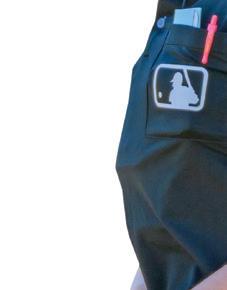


spring training game since Ria Cortesio in 2007. Originally a softball umpire, Pawol made the switch to baseball and graduated from umpire school in 2017. She has since worked in the minors and reached Triple-A in 2023, becoming the first woman in 34 years to do so.





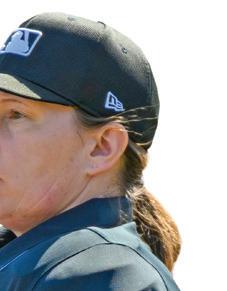






IFAB announced in February it will test “sin-bins,” giving referees the power to send players off for 10 minutes as discipline for dissent or fouls. When a referee shows a player the newly introduced “blue card,” that player is relegated to the sideline for the next 10 minutes; if the same player is
shown a second blue card, they are dismissed for the rest of the game. The Football Association is considering using sin-bins in the FA Cup and Women’s FA Cup next season, according to The Times (U.K.).
Teacher Fined for Moonlighting as Referee
A state-appointed hearing officer rejected the Manhasset (N.Y.) school district’s request to fire
THE NEWS
DOUG MURRAY/ICON SPORTSWIRE/NEWSCOM (PAWOL), BILL GREENBLATT/UPI/NEWSCOM (HICKOX) 12 | REFEREE May 2024
REFEREE May 2024














































































equipping officials for success!




























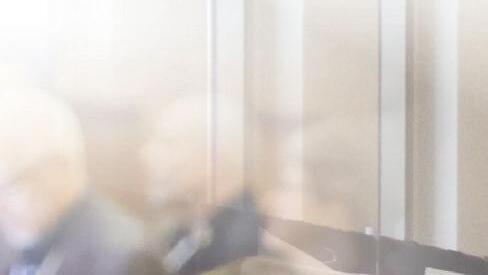











DON’T MISS OUT ON THESE GAME-CHANGING CONVERSATIONS
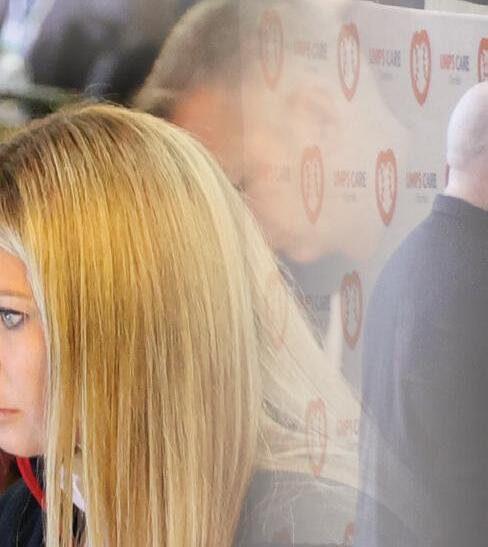







Many organizations have devoted incredible resources to the recruitment of new officials, but what happens once they’re in? How are we onboarding new officials to ensure success and longevity? This year we focus on how we can all work together, including local association efforts, training for non-traditional recruits and providing the tools and resources needed to make the officiating avocation welcoming and nurturing.

sports officiating summit .com REGISTER TODAY!
ATLANTA GEORGIA
07/28-07/30 2024
NBA Referee Jerseys Carry Emirates Patches
NEW YORK — Jerseys of NBA referees now carry paid advertisements for Emirates Airlines, the league’s global airline partner. The patches, one on the chest and one on the sleeve, began appearing Feb. 18 at the NBA All-Star Game.
G League referees will wear the same patches during the 2024-25 season and WNBA referees will wear them for the 2025 season.
Financial aspects of the deal were not disclosed.
Emirates became the global airline partner of the NBA on Feb. 8.The United Arab Emirates-based airline has become the title sponsor of the NBA’s In-Season Tournament — now known as the Emirates NBA Cup. Emirates will also be part of a co-branded logo and a co-branded international social media campaign with the league; the logo will be placed on virtual in-arena signage and be on the backboard of nationally broadcast NBA games. The airline will also be the presenting partner of the NBA Finals Legacy Project.
In addition to being visible during regular play, the jersey patches are likely to be seen when referees go the scorer’s table for video reviews.
It’s been just over six years since NBA players began wearing sponsored patches on their jerseys. And officials wearing advertising is not new. In professional sports
THE WIRE
a math teacher who officiated 2023 NCAA Tournament games when he was supposed to be in the classroom. Manhasset High School teacher Brandon Cruz instead received a fine of three months’ salary for taking three unauthorized unpaid days off to referee in the tournament after the district denied his time-off request. It’s the second time Cruz has been disciplined for time off — in 2019, he was fined by
outside of the U.S., officiating uniforms have long been fair game for league sponsorship opportunities. In the English Football League, for example, soccer referees have worn EA Sports patches on their sleeves. Rugby Australia referees have worn uniforms with prominent ads for Emirates.
The patches on Australian cricket umpire shirts ventured into new territory in 2020 with a sponsorship by underarm deodorant and antiperspirant brand Rexona. The patches were placed under the umpires’ arms in a sport where a significant signal involves raising one or both arms. Rexona’s parent company Unilever termed it “pitsvertising.”
Such advertising hit American pro sports in 2021. MLB signed a fiveyear deal with FTX, a cryptocurrency exchange. Part of the sponsorship included umpires wearing FTX patches on their uniforms.
That deal lasted one season. In December 2022, MLB announced it would no longer have its umpires wear an FTX patch on their uniforms. The decision came after FTX filed for Chapter 11 bankruptcy and FTX founder Sam Bankman-Fried was arrested for fraud. He was later found guilty of stealing billions of dollars from users of the crypto exchange.
the district for using “personal or family illness” paid-time off to moonlight as an NCAA basketball referee for several years.
YMCA Referee Assaulted During Tournament
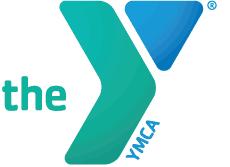
A YMCA referee was assaulted Feb. 10 during a youth
Hickox continued from p.8
Hickox completed his training there in 1983 and umpired in the minors until receiving his first big league call-up in 1990. After working regularly as a fill-in umpire for most of the 1990s, Hickox was promoted to the AL’s full-time staff in 1999.
Hickox’s career was derailed that same year, however, as he, along with many other umpires, resigned in 1999 as part of a failed union bargaining strategy. While many other umpires were not rehired in the incident’s aftermath, Hickox eventually returned to the majors in 2005 and regained his full-time position in 2007.
Aside from his postseason assignments, Hickox worked several other notable games during his career, including five no-hitters: Jim Abbott in 1993, Clay Buchholz in 2007, Matt Garza in 2010, and Jered Weaver and Homer Bailey in 2012. Hickox was also behind the plate on June 19, 2015, when Alex Rodriguez hit a home run for the 3,000th hit of his career.
Hickox is a licensed pilot and volunteers for Angel Flight in the offseason, providing free air transportation for passengers in need. He told the Daytona Beach News-Journal in 2018 that he tries to complete at least one mission per offseason.
basketball tournament in Huntington, W.Va., YMCA officials said. In the third quarter of the Huntington Buddy Basketball tournament championship game, a YMCA referee was verbally and physically assaulted. The league associated with the individuals responsible for the incident was asked not to return to the YMCA for the rest of the season, according to YMCA of Huntington Board President Sam Miller. The
assault is being investigated by law enforcement.
LL Names Director of Umpire Development
Little League International announced in February it has named Stu Hartenstein as director of umpire development and operations. In his new role, Hartenstein will oversee the administration and development of Little League’s
THE NEWS
14 | REFEREE May 2024
Seitz Joins U.S. Soccer as VP of Refereeing

CHICAGO — U.S. Soccer announced in February that longtime referee Kari Seitz has been named the federation’s first vice president of refereeing. She began her new role April 1.
Seitz will lead the federation’s referee department in an accelerated initiative to grow the number of highquality referees across all levels of the game, according to U.S. Soccer.
“Returning to the USA to lead the Federation’s Refereeing Department is a once-in-a-lifetime opportunity,” Seitz said. “I want to thank U.S. Soccer for recognizing the importance of investing in refereeing, an often overlooked and underappreciated,
yet integral, part of the game. It is an incredible responsibility to lead the growth, development and support of refereeing at all levels of the game, and I know with the support of the U.S. Soccer referee family our collective passion, experience and knowledge can take refereeing in the USA to new heights.”
Seitz joins U.S. Soccer from FIFA, where she served as head of women’s refereeing for soccer’s international governing body since 2016. During her time with FIFA, she oversaw the refereeing efforts for 15 world championship events and led the global development of women’s refereeing. Seitz remains the only American to ever work in FIFA’s refereeing department.
During her 28-year on-field career, Seitz was one of the most
PRO alleged that PSRA unlawfully threatened or coerced potential replacement officials.
Negotiation sessions with federal mediators took place Feb. 28 and March 1, but they did not result in an agreement.
During the Feb. 28 negotiation session, the PSRA gave PRO a revised offer asking for additional pay increases, compensation for image and likeness fees and retroactive
wage payments. PRO rejected the proposal and informed the PSRA on March 2 its original tentative agreement proposal was still its best offer for MLS referees.
As of press time, no agreement has been reached between PRO and the PSRA, and replacement officials — from lower division, college and youth ranks — continue to work games.
In a Feb. 29 letter to the referee community, PSRA stated, “The journey has not yet ended; a difficult road lies ahead. We must each remain
accomplished referees in the world. She officiated in a U.S.-record eight FIFA tournaments: the 1999, 2003, 2007 and 2011 Women’s World Cups; the 2004, 2008 and 2012 Olympic Games; and the 2002 U-19 Women’s World Championship. Seitz worked the third-place match between Sweden and France at the 2011 Women’s World Cup, which stood for 12 years as the highest-level World Cup game officiated by an American until Tori Penso refereed the 2023 Women’s World Cup Final.
Seitz also worked matches in MLS, the Women’s United Soccer Association, Women’s Professional Soccer and National Women’s Soccer League. She worked three league championship matches: the 2009 and 2011 WPS Finals, and the 2013 NWSL Final.
resolute in our commitment to each other, to the game, and to the goal of achieving a contract with PRO/MLS that represents a fair and balanced agreement demonstrating officials’ significant, direct, and unmistakable role in supporting the growth of the league’s onfield product.”
The last time MLS referees were locked out was 10 years ago in 2014. That lockout lasted two weeks before a five-year collective bargaining agreement was reached.
umpire program, including the development of grassroots efforts for recruiting and developing umpires at all levels. Hartenstein previously served as director of Little League’s Central Region.
Hockey Referee Under Investigation After Scrum
The Massachusetts Interscholastic Athletic Association (MIAA) is
investigating an incident involving a referee that occurred during a girls’ hockey game in February. Video of the matchup between Shrewsbury High School and Westford Academy shows a referee skating toward a scrum of players late in the game. The referee gets in the middle of the scrum and then appears to swing her left arm. The video angle cuts off part of the scrum, however, and it is
unclear why the referee swung her arm. The MIAA said it would not comment while the matter is being investigated.
NHL Official Is First to Wear Neck Guard
NHL referee Dan O’Rourke became the first NHL official to wear a cut-resistant neck guard earlier this year. He debuted the new protective gear Feb. 15 during a matchup between the
Anaheim Ducks and Montreal Canadiens. The NHL has not yet mandated neck guards for officials or players. Last December, the International Ice Hockey Federation announced neck guards would be required at all levels, but did not provide a date for when the policy would be enforced.
REFEREE May 2024 | 15 COURTESY U.S. SOCCER
SOURCES: ESPN, LITTLELEAGUE.ORG, NBA.COM, NEWSDAY, SCOUTING THE REFS, THE TIMES (U.K.), WCHSTV.COM, WCVB.COM
SOURCES: THE ATHLETIC, ESPN
Lock Out continued from p.12
BASEBALL

CAUGHT ... OR CONSEQUENCES
Dropped Third Strikes Raise the Stakes
By George Demetriou
“One, two, three strikes you’re out” as the song goes. Well, not necessarily; on a third strike, a batter is not immediately out unless
the pitch is legally caught by the catcher or first base is occupied with fewer than two outs. The reason for the latter condition is to prevent a cheap double play. Except where noted, the following material applies
equally to NFHS, NCAA and pro rules.
Play 1: With R1 on first, one out and an 0-2 count on B3, F1 inexplicably uses the windup. R1 breaks and reaches second as B3
16 | REFEREE May 2024 EDITOR: SCOTT TITTRINGTON stittrington@referee.com
RULES, MECHANICS, PHILOSOPHY DALE GARVEY

Scott Johnson, Darrington, Wash., signals a swing,
there are two outs or first base is not occupied, the batter becomes a runner and may attempt to advance. Thus, it is possible for a pitcher to record four or more strikeouts in an inning.
The number of four-strikeout frames, a total of 99 in the history of MLB, has grown exponentially in the 21st century. The earliest recorded occurrence was by Ed Crane of the New York Gothams in 1888 and the most recent by Tyler Glasnow of the Tampa Bay Rays on July 7, 2023. Only four pitchers have done it more than once.
Dropped third strikes that ultimately affect the outcome of a game are a rarity in MLB postseason play. The most memorable goes back more than 60 years. In the top of the ninth inning of Game 4 of the 1941 World Series, the Dodgers led the Yankees, 4-3, with Tommy Henrich at bat for New York. Hugh Casey threw a pitch that the bottom dropped out of (some say it was a spitter) and Henrich swung and missed for strike three, but Mickey Owen failed to catch the third strike. The Yankees went on to score four runs in the inning, won the game, 7-4, and went on to win the World Series in five games.
Dropped vs. Uncaught
THEY SAID IT
“The amount of baseball I have learned, just within two weeks, just being able to understand the rules now and being able to say, ‘Oh, now I understand why the play was called like that.’”
— Jillian Sopko, one of the 50 candidates who attended this year’s MLB Umpire Prospect Development Camp in Vero Beach, Fla.
SOURCE: MLB.COM
BY THE NUMBERS
75%
The number of video reviews that resulted in rulings of “confirmed” or “stands” during the 2023 NCAA Division I Baseball Championship. Out of 183 total reviews, 93 (51%) were confirmed and 44 (24%) stood as originally ruled. Only 46 total reviews (25%) were overturned after going to replay.
SOURCE: NCAA
DID YOU KNOW?
Expect the number of obstruction rulings in MLB to see a significant increase during the 2024 season.
swings at a pitch in the dirt for strike three. Ruling 1: B3 is out since first base was occupied at the time of the pitch. The fact R1 had already reached second when F2 got possession of the ball and a double play was no longer possible is not a factor.
When a third strike is called and the pitch is not legally caught and
This situation is often referred to as a dropped third strike, but it is not necessary for the ball to be “dropped” by the catcher. If the pitch touches the ground before it is secured by the catcher, it is “uncaught.” The batter becomes a runner and may attempt to advance (NFHS 7-4-1b, 8-1-1b; NCAA 8-2c; pro 5.05a2). Thus “uncaught third strike” is the more accurate and descriptive term. It is also not a catch if the ball lodges in the catcher’s clothing or equipment, or if it touches the umpire before going into the glove (NFHS 2-9-1; NCAA 2-16; pro 5.09a2 Cmt., Catch Definition).
Play 2: With two strikes and two outs, B3 swings at and misses a pitch that hits the ground, but is caught on one hop by F2. Ruling 2: B3 is not out since the third strike was not legally caught before touching the ground. B3 may attempt to reach first base.
Any time a third strike hits the
MLB issued a point of emphasis to its umpires in February regarding rule 6.00h, which awards bases to runners when a fielder while not in possession of the ball and not in the act of fielding the ball is ruled to have impeded a runner’s progress. The edict emphasizes the existing rule and asks umpires to call obstruction if they determine a fielder has positioned himself to impede or hinder a runner’s path to the base before receiving the ball.
The play remains nonreviewable, and the point of emphasis only applies to the bases and not plays at the plate.
The guidance was deemed necessary in light of a recent trend in which the league has observed an increase in egregious blocking of the bases, most notably by fielders dropping down a knee or leg in front of the base while receiving a throw to block the runner’s path.
SOURCE: MLB.COM
REFEREE May 2024 | 17
creating an uncaught third strike on this pitch. Now, he must remain aware of where the baseball is so he can make any additional relevant rulings on the play.
BASEBALL
TEST YOURSELF
In each question, decide which answer is correct for NFHS, NCAA or pro rules. Solutions: p.81.
1. B1 steps into the batter’s box with a bat that does not have a sticker showing it has been approved during a bat testing procedure for that game. F2 points out the bat to the umpire. No pitch has been thrown.
a. B1 is out and the bat is removed from the game.
b. The bat is removed from the game. The batter is allowed to change to a legal bat without further penalty.
c. B1 is ejected for trying to use an illegal bat.
d. A team warning is issued. If one has been issued in the game, the player and head coach are ejected.
e. Play proceeds unless the bat is otherwise illegal.
2. If team A wants to protest an umpire’s enforcement of a rule on a play that ends a game, it has until when to voice its intention to do so?
a. Until the start of team A’s next scheduled game.
b. The offended team has until all infielders have left fair territory and the catcher has cleared the dirt circle to voice its protest intentions.
c. Until the umpires have left the field.
d. Game-ending plays are not subject to protest.
3. With a runner on second and one out, B3 swings and misses the pitch for strike two. His follow-through unintentionally hits F2 attempting to throw out R2, who successfully steals third base.
a. This is interference. Both R2 and B3 are declared out.
b. This is interference and R2 is declared out and B3 remains at bat.
c. This is interference. B3 is out and R2 returns to second base.
d. There is no interference, the ball is dead, and R2 returns to second base.
e. There is no interference. The play stands.
batter, the ball is dead and the batter is out (NFHS 5-1-1a, 5.1.1E; NCAA 7-11h, 8-2d1a; pro 5.09a6).
Time Limit
When the ball hits the ground on a third strike, teammates or coaches will often yell for the batter to run. On occasion, no one, including the batter, will recognize he has become a batter-runner and is eligible to advance to first. In NFHS play, the batter may attempt to advance at any time before entering the dugout. If the uncaught third strike occurs with two out, he may attempt to advance until all infielders have left the diamond. This could result in a very convoluted basepath to first base. The “abandoning the basepath” rule does not apply in this situation.
Under NCAA and pro rules, a batter who does not realize he has become a runner and does not attempt to advance is out once he leaves the dirt circle surrounding the plate heading toward his dugout. If the batter recognizes his right to advance before he is out by rule, he is not restricted as to the path he may take to first base (NFHS 8-4-1f, 8-4-1i, 8.1.1B; NCAA 7-11u; pro 5.05a2 Cmt., 5.05a2 Cmt.).
Play 3: With two strikes and two outs, B3 swings at and misses a pitch that is dropped by F2. B3 heads for the third-base dugout. When he gets to within 10 feet of the dugout, his coach yells for him to run to first. Ruling 3: Legal in NFHS. B3 may attempt to reach first base until he enters the dugout. In NCAA and pro, B3 should be declared out once he leaves the dirt circle surrounding the plate.
Interference
After an uncaught third strike in which the ball remains live and in play, the batter must be careful not to interfere with the catcher’s fielding or throwing by stepping out of the batter’s box or making any other movement that hinders the catcher’s play (NFHS 7-3-5; NCAA 6-3b, 7-11h Note; pro 6.01a1). If, while attempting to advance to first base, the batterrunner intentionally deflects the ball, the batter-runner is declared out, the ball is dead and all runners return.
In NFHS, any unintentional deflection keeps the ball live and in play (8-4-1a). In NCAA and pro, regardless of intent, if the batterrunner clearly hinders the catcher’s attempt to field the ball, the batterrunner is out, the ball is dead and all other runners return to the bases they occupied at the time of the pitch. If a pitch that is not caught remains in the vicinity of home plate and it is inadvertently deflected by the batter or umpire, the ball is dead and the runners return to the bases they occupied at the time of the pitch (but if the pitch was strike three, the batter is out). If the pitched ball deflects off the catcher or umpire and subsequently touches the batter-runner, it is not considered interference unless, in the judgment of the umpire, the batter-runner clearly hinders the catcher’s attempt to field the ball (NCAA 7-11h Note; pro 6.01a1 Cmt.). NCAA rules further specify if there are less than two outs and a runner on third is attempting to steal, the ball is dead, the run scores and all other runners return, unless they were also stealing on the pitch (7-11s).
Play 4: With no runners, B1 swings and misses a pitch in the dirt for strike three. F2 blocks the ball, which then rolls forward. As he leaves the batter’s box, B1 kicks the ball into foul territory. B1 is safe at first. Ruling 4: In NFHS, the umpire must judge whether B1 intentionally kicked the ball. If so, B1 is out for hindering F2’s attempt to field the ball; the ball is dead. If not, the play stands. In NCAA and pro, B1 is out if he clearly hinders F2 in the attempt to field the ball.
Play 5: B1 swings and misses a pitch in the dirt for strike three. B1 takes off for first and F2 deflects the ball into him. B1 is safe at first.
Ruling 5: In NFHS, the ball is live and in play. When a batter-runner has left the batter’s box and is hit from behind by a ball deflected by the catcher, he should not be called out for interference. In NCAA and pro, even though the ball was deflected, B1 is out if in the judgment of the umpire, he clearly hinders F2 in the attempt to field the ball.
George Demetriou, Colorado Springs, Colo., is the state’s rules interpreter.
18 | REFEREE May 2024


Partner Down, Now What?
By Jon Bible
Rarely do umpires suffer an injury that forces them to leave the game. But it happens, and then the remaining crew members must quickly adjust. Going from four umpires to three, or three to two, isn’t a big deal. Everyone most likely switches between different-sized crews during the season or has worked on a smaller crew at some point, so muscle memory — instant recall of applicable mechanics — should kick in. A two-member crew going to one is another story; more on that later.
Sometimes we bring on injuries ourselves. Many umpires do not stretch before taking the field. Even young folks should do this, but it’s more essential the older we get. Much of our movement involves quick sprints, foot planting and turns. Not loosening up sets us up for a strain, pull or tear, especially if we’re overweight or don’t hit the gym regularly. When we work the plate, having to get out of our stance and bolt to third base to cover a potential play there can result in a pulled muscle, among other things. Whether I worked the plate or bases, I always spent
at least 15 minutes pregame on stretching.
Not everyone has the luxury of a dressing room large enough to get on the floor to stretch our legs, quads, etc., but we can improvise even if we dress out of the trunk of a car. I suggest consulting a physical trainer who’s knowledgeable in this area to give you a regimen suited to your needs. I’ve done that. They may know nothing about umpiring, but you can explain the kinds of movements we make and they can go from there. Back in the day, loosening up often involved jerky, even violent movements — quick toe touches,
DENNIS HUBBARD
REFEREE May 2024 | 19
When a member of an umpiring crew is injured during a game, the reduction in umpires on the field will lead to different mechanics, rotations and responsibilities. Here, plate umpire Ricky Salvato, San Angelo, Texas, follows a batter-runner toward first base.
CASEPLAYS
Fancy Feet
Play: B1 hits a foul fly near a chalked dead-ball area. F5 steps across the line with both feet and leaps, making the catch with both feet in the air. F5 lands with both feet in the dead-ball area. Ruling: No catch and simply a foul ball (NFHS 2-9, 2.9.1C Cmt. 3; NCAA 6-1d1; pro Catch Definition, Interp).
Do Over?
Play: As F1 begins his pitching motion, B1’s bat contacts F2’s mitt. Ruling: There is no penalty; the ball is immediately dead and the pitcher and batter can reset (NFHS 2-21-5, 5-1-1n, 7-3-7; NCAA 8-2e Note; pro 6.01c Cmt.).
No Excuse
Play: With R2 on second and one out, B3 singles to center. F8 throws home in an attempt to put out R2. F1 is backing up home plate. As F1 is going to get the ball R2, who has scored, gets in the way of F1, who has retrieved the ball and is attempting to retire B3 who is advancing to second. Ruling: The run scores, but B3 is out. If any runner who has just scored (or has been put out) hinders or impedes any following play being made on a runner, such runner is out for the interference by his teammate (NFHS 8-4-2f; NCAA 5-3 Pen. 2; pro 6.01a5).
Brief ‘Visit’
Play: B3 walks to load the bases. The coach yells from the dugout for F1 and F3 to trade places. Ruling: That counts as a trip. In NFHS, it is not of any significance because there are no limitations on trips in which the pitcher is removed. In NCAA and pro, replacing the pitcher constitutes one trip to that pitcher that inning, regardless of whether the manager or coach chooses to go to the mound, or whether the pitcher remains in the game at a different position on defense. That means another trip cannot be made with the same batter at bat. Another trip can be made in the same inning with a subsequent batter at bat, but the pitcher must be removed for the remainder of the game (NFHS 3-4-1; NCAA 9-4b, 9-4c; pro 5.10l).
jumping jacks — that often were more harmful than helpful, but now there are many sophisticated, sport-specific methods and devices that we’re crazy not to utilize.
Even if we’ve loosened up, things can happen that are out of our control. I once worked a game where a pitch bounced off the plate and hit the umpire in the throat. EMS had to be called to take him to the hospital. Another crew member had to don his plate gear and we went from a four- to a three-umpire crew.
This was tough on us psychologically, for we knew the umpire might be hurt badly and were concerned about him (he turned out OK). But we also knew we had no choice but to put it out of our minds for the rest of the game and get on with it. I liken this to what happens in football games when a player has to be carted off the field. The other players know they could be next but dwelling on that will impair their ability to keep the kind of clear head and focus needed for the task at hand.
The crew should have an impromptu play-coverage discussion. Even if they regularly work in crews of the new size, they ought to take a minute or two to review basic coverages. You wouldn’t (or shouldn’t) start a game without a pregame, so don’t go into your new situation without some discussion. In the game above, once the base umpire put on his plate gear, we three spent a couple of minutes on basic three-umpire coverages. I hadn’t worked crew of three in years and another guy usually worked crew of two. You can’t just wing it and hope everyone will figure things out as plays occur because disasters can happen.
Keep whatever discussion you have short. Most likely, there has already been a delay due to the injured umpire, and the players and coaches will get even antsier the longer it goes on. You don’t have the luxury of more than 2-3 minutes to cover basics. Don’t take the time to try to find some spot away from everyone; do it wherever you happen to be. Who cares if anyone hears what you’re saying?
When you’re short-handed, you must keep your head in the game
because you’ve quickly assumed coverage responsibilities that you didn’t have. I remember a spring training game when I was in pro umpire school. U3 had left for some reason so U2 moved to third. A leadoff hitter hit a rope to rightcenter field, rounded first and got to second standing up. Forgetting there was no longer a second-base umpire, neither U1 nor the new U3 budged from the foul line. I would have loved to have seen what would have happened if there had been a whacker at second base because someone would have had to make a call from 90 feet away.
What should you do if you’re part of a two-umpire crew and your partner leaves the game? This happened to me in pro ball when the plate umpire took a foul ball off of his elbow in the second game of a doubleheader. Two-umpire crews were the norm then (and still are at some levels of pro ball). I had to get behind the plate again. I got the managers together and told them to pick one player each to work first and third base. We got along fine as they didn’t have anything really close to call.
Should you do this in amateur ball? No. You’re going to need to go it alone. Because that’s a lousy option, explain to the head coaches that you expect it to be like church the rest of the day regarding plays on the bases. If you hear complaints, you may be forced into police mode. Jon Bible, Austin, Texas, worked seven NCAA Division I College World Series. In 2019, he was inducted into the National College Baseball Hall of Fame in Lubbock, Texas.
Correction:
The answer key for two baseball Test Yourself questions in the 4/24 issue contained an error. The correct answer for No. 3 is A in all three rule codes (NFHS 6-13; NCAA 9-1a; pro 5.07a2). The correct answer for No. 4 is B in all three rule codes (NFHS 2-22-1, 8-3-2; NCAA 2-55, 8-3e1 Note; pro Obstruction Definition, 6.01h).
BASEBALL
20 | REFEREE May 2024
THE ON LY OFFICIAL COLLEGE MECHANICS MANUAL
The CCA Mechanics manual is the only official source for college baseball mechanics. When you pair your rules knowledge with advanced mechanics graphics from Referee, you will confidently be in the right place at the right time to make every call.
ALL NEW FOR THE 2024 SEASON!
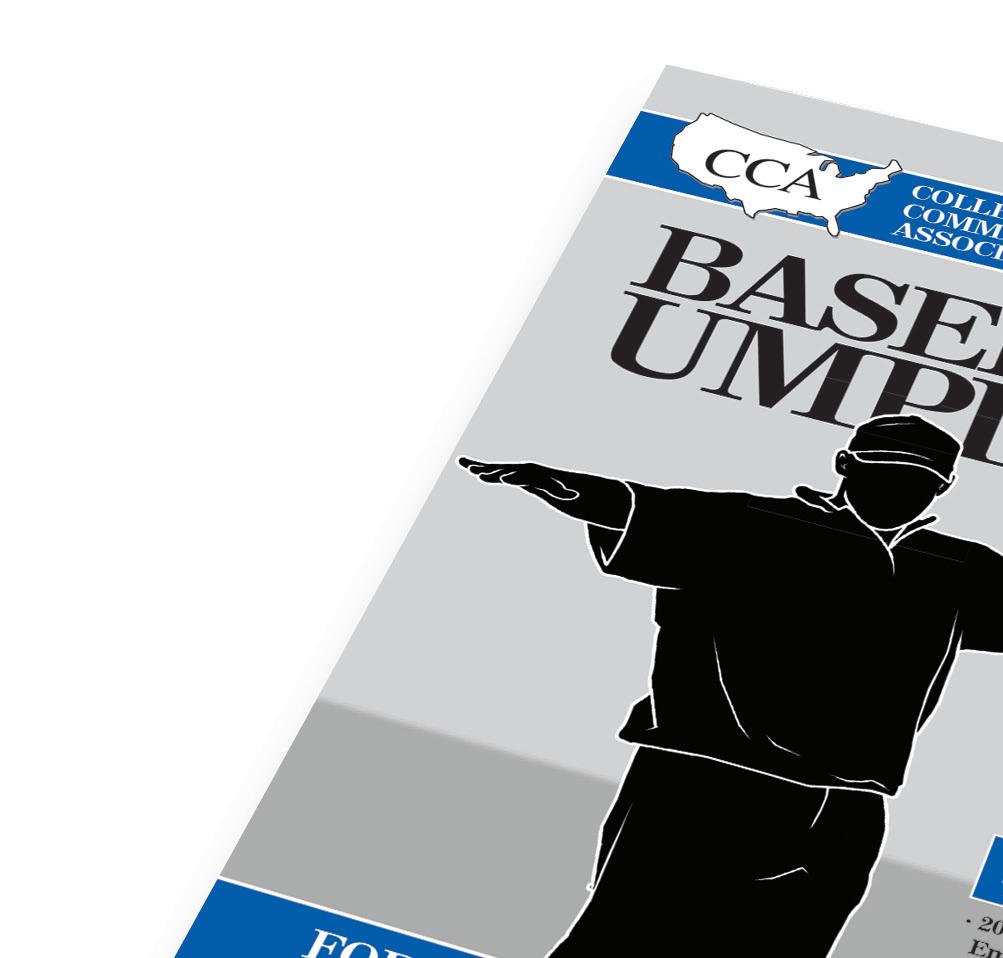



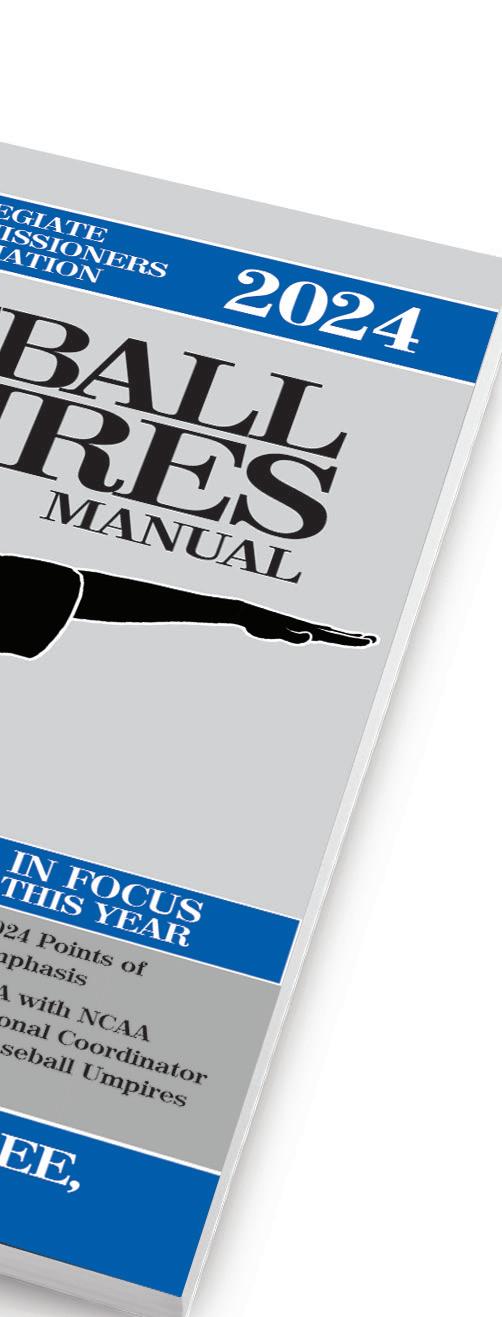
GET YOURS TODAY! // STORE.REFEREE.COM/BASEBALL
$1995 ONLY
Size: 5.5”x 8.5” Pages: 272
They’re Both Yours
There are several scenarios that occur in two-person umpiring that put one or both umpires in suboptimal positions for playcalling. Such is life when you have three bases and a plate, the possibility of four baserunners and only two arbiters to keep tabs on the action.
And then the odds get even worse when a situation develops where one umpire is required to do the heavy lifting at two vastly different spots on the field.
Case in point is shown in the MechaniGram. Here’s the situation: a runner on second base and less than two outs. The batter-runner hits a ground ball to the left side of the infield.
The base umpire, who has set up pre-pitch in the C position, has a lot on the plate as this play develops. First, U1 must keep eyes on the baseball, know whether the ball has been fielded cleanly by either the shortstop (as shown) or the third baseman, and know where the first play is going to take place. Has R2
broke for third base or is he holding his ground? Will the infielder who comes up with the ball make a play on this lead runner, or look him back and throw to first? And from a health and safety standpoint, are you going to be able to get out of the way if the throw comes zipping across the infield?
While avoiding this throw, U1 must also create an angle for making a ruling at first base and must understand this ruling always belongs to the base umpire. Yes, the plate umpire should be moving out from behind the plate to open up a look at a possible pulled foot or swipe tag by the first baseman. However, this is information the plate umpire may share during a postplay discussion, not as the primary playcaller. That responsibility belongs to U1, who can then ask for help if necessary.
However, that ruling is not the final piece of the puzzle for U1. What if R2 breaks for third base after the throw has been made across the
diamond in an attempt to retire the batter-runner? That’s right … this is also the responsibility of U1, not the plate umpire. After finding one good position in the working area to make a ruling at first base, U1 must now avoid a second throw across the infield and create yet another angle for a probable tag play at third base.
As a base umpire, don’t fall asleep and find yourself out of position to rule on the back half of this play. Your plate umpire, if doing everything correctly, is not going to be in a position to bail you out, having moved up the first-base line to keep tabs on the first play and then hustling to get back to the dirt circle and the third-base line extended should a play ultimately develop on R2 at the plate.
A base umpire will look like a million bucks and perhaps even earn a little bit of credibility from stakeholders when using solid footwork, positioning and situational awareness to be on top of both of these rulings.
GROUND
THROW THROW BR BR R2 R2 U1 22 | REFEREE May 2024 BASEBALL
BALL







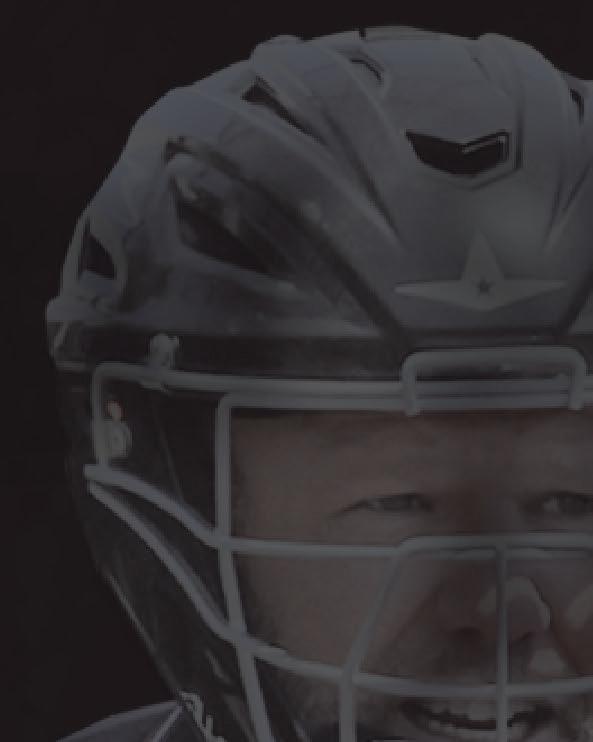








Your complete guide to the 2024 High School Baseball season. Get all this and more…

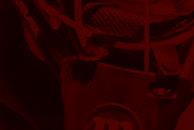







• The latest NFHS rule changes explained and simplified.
• The most up-to-date NFHS Points of Emphasis

• The most current umpiring tips & strategies







• Quiz questions & answers along with dozens of caseplays with rulings





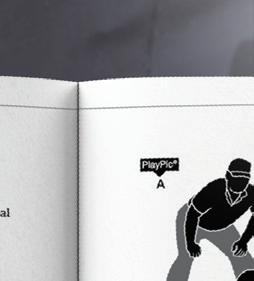



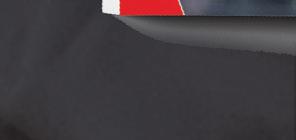





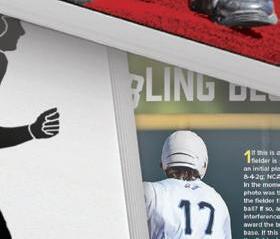






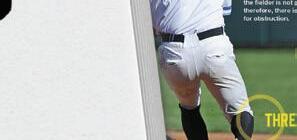






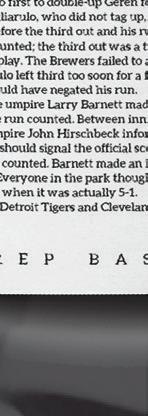


















ANNUAL EDITION
100+ Caseplays and Test Q&As Full Color Photos & Diagrams Latest NFHS Rules & Mechanics Changes HandPicked Articles learn more at STORE. /baSEball *NASO discount available. $1795 * DIGITAL PRINT $2395 COMBO $1895 * SIZE: 8”x11” PAGES: 104 NEW STAY SHARP ALL SEASON


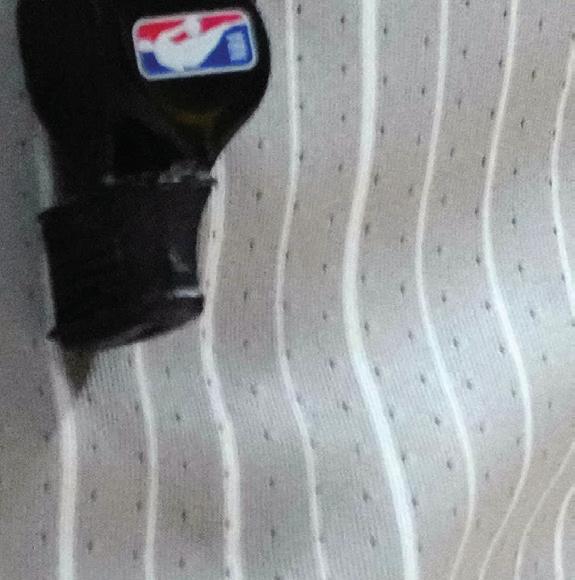









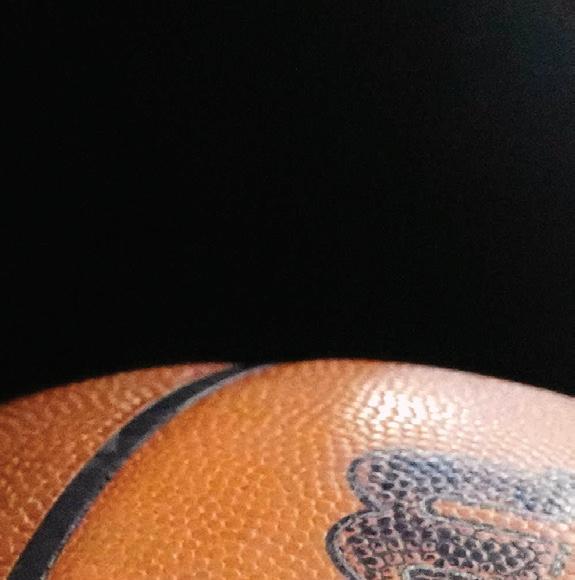




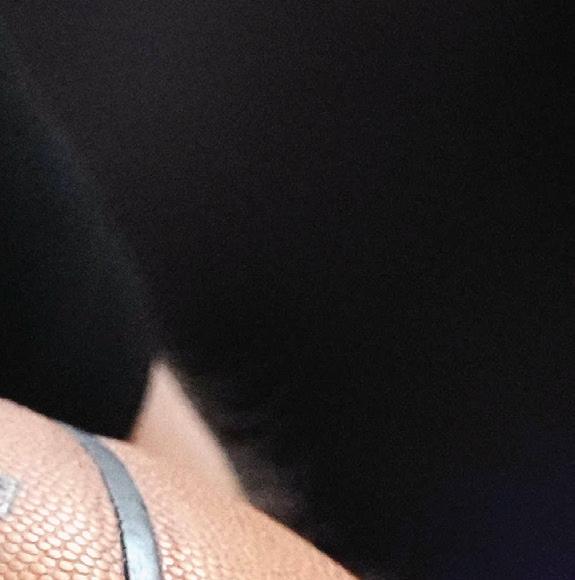
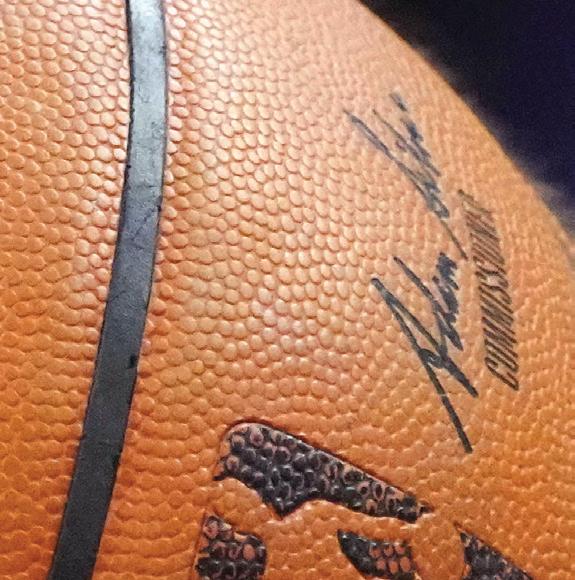

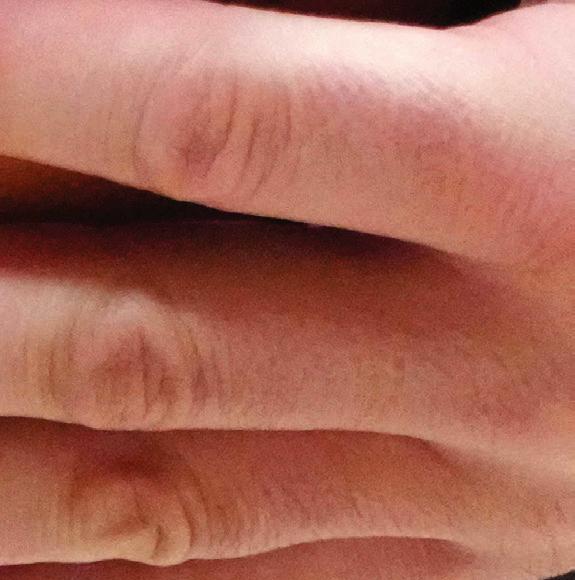


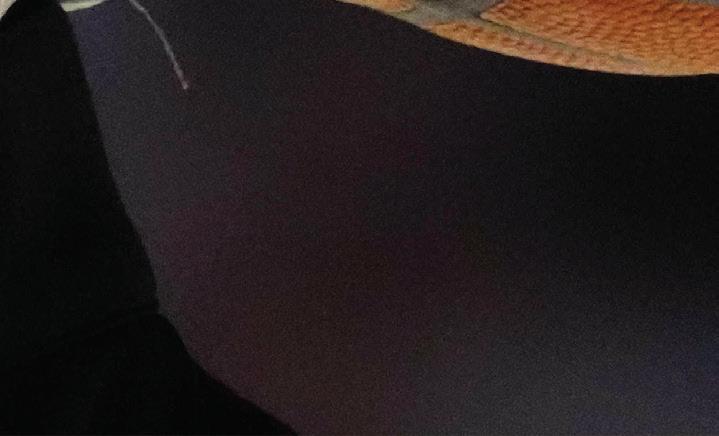



| REFEREE May 2024 © RON CHENOY-USA TODAY SPORTS







THE NBA
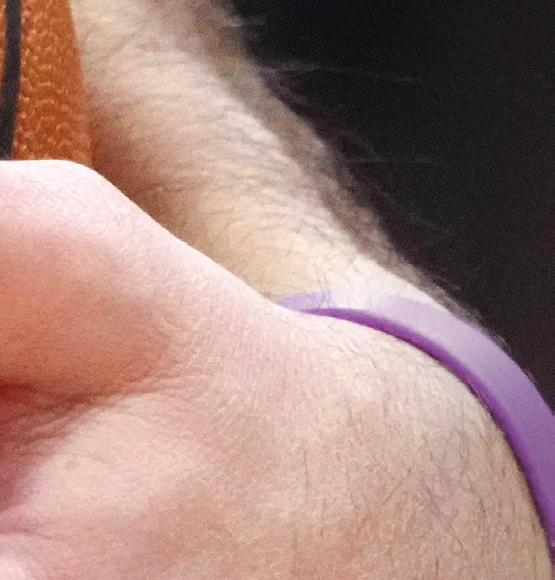




Officials eager to work at the highest level have access to tools and training like never before.
By Dan Ronan



Hundreds of prospective NBA referees are working on their games every night in a high school gymnasium or a college or NBA G League arena. They have big aspirations, and the NBA says it’s never been more transparent about the road they must follow to get there.
At any given time, the NBA has up to 3,500 referees in its hiring pipeline. It’s encouraging anyone who wears a uniform anywhere in the world to register in its online portal, nbaofficials. com, reach out to the league’s scouting staff and at the very least get professional



evaluations, instruction and feedback. The NBA says you can improve your game — making you, in the long run, a better, more confident official.
“You can sign up, put your schedule in, and put some videos in, and this allows us the opportunity to get our scouts out and see your work, and we try to see everyone who fills out a profile,” said Monty McCutchen, 57, the NBA’s senior vice president and head of referee development and training.
“We are following them as they grow, and our charge is to serve the game at the highest level. We are going to do our best to try and see you. If we see talent, we want
REFEREE May 2024 | 21
PIPELINE TO THE NBA

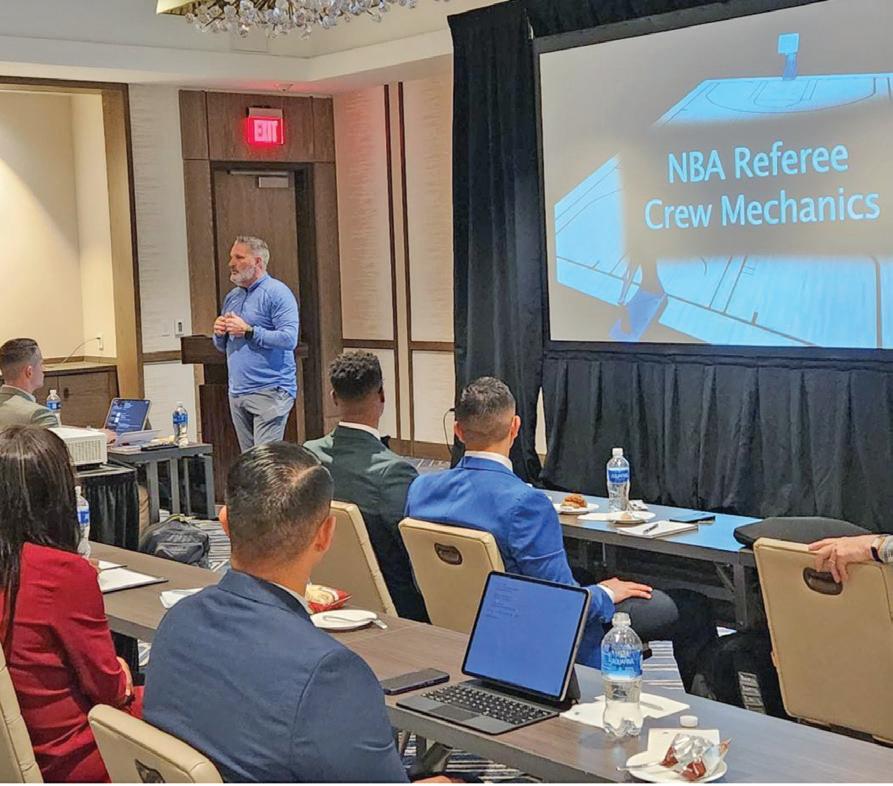
to grow it. Filling the profile out is the first step.”
And if you have talent and abundance of determination, you could make it. It is not a career path for the faint of heart, but everyone knows that most referees are uber Type A personalities, even at the lowest levels.
McCutchen moved into his current position after the 2017 season. He worked more than 20 years on the court, including 1,300-plus regular season games, 169 playoff games and 16 games in the NBA Finals.
“Part of our responsibility is to grow in concert with the game,” he said. “We’re not allowed as officials to let players continue to grow their skillset and coaches grow, and we as referees stay stuck in the mud. The growth of the
“Part of our responsibility is to grow in concert with the game, We’re not allowed as officials to let players continue to grow their skillset and coaches grow, and we as referees stay stuck in the mud.”
–monty mccutchen
players, the coaching and the overall game have pushed us as referees to grow, and we welcome this scrutiny.”
One of his most important goals continues to be spotting and developing new officials and monitoring their development with a full-time scouting department. Every official can and is encouraged to regularly upload game videos to the NBA staff, where it can be broken down, frame-by-frame.
Al Battista, who resides in Washington, D.C., is a full-time NBA Officiating Program team member. He, along with his colleagues, spends thousands of hours a year watching videos, attending games in person, calling and emailing officials, participating in development camps, and instructing officials. They have the larger goal of
improving officials’ overall performance and finding those men and women who can rise through the ranks into the college and G League ranks and then into the NBA.
“It’s my job to find good referees and improve them,” Battista said. “You must learn the rulebook and understand the rules. You never know where you will find a good referee with the tools to be a great pro prospect.”
Battista is generally recognized as one of the game’s leading experts when it comes to understanding the inner workings of all the sport’s various rulebooks, from the international federation to the NCAA and professional basketball.
The NBA’s program is highly layered, and McCutchen and Battista both say that even if officials do not ultimately make it to the G League, WNBA or NBA, they have still significantly improved their skills and will be among the best at whatever level they work, whether it’s high-level high school, AAU leagues or Division I college basketball.
The NBA’s Referee Development Program is broken down this way:
Recruitment: 3,000 to 3,500 candidates are registered and monitored by the NBA’s officiating team.
Grassroots camps: 100 referees are invited to attend an NBA camp.
Mid-level camp: 50 referees advance to the next level.
Elite camp: 30 top graduates move into the program.
G League: 4-10 are hired annually, and 65 referees are on the G League staff.
“We’ve seen everyone in our top 100,”McCutchen said. “We don’t just discard you if you’re not ready to
26 | REFEREE May 2024
Monty McCutchen, the NBA’s senior vice president and head of referee development and training, addresses Elite Camp officials in conjunction with the NBA’s 2023 Las Vegas Summer League. COURTESY OF
THE NBA
be in the top 100. We want to keep tabs on you, and we want you to keep sending in your schedule and video, and that way, we can see growth. We don’t want the first time we see someone to be the only time we see someone.”
As a referee progresses and develops to get as much work as possible, it is not uncommon for some G League officials to work in that league and have a major college schedule. This is a change from the past when officials either had to commit to a career in college or professional basketball.
“We’re looking for characteristics that translate to G League, WNBA and NBA arenas,” McCutchen said. “We’re looking for courage without arrogance. Humbleness without weakness and the proper amount of resoluteness and communication skills and the ability to be a part of a team. We know these traits, and the ones that work at this level translate well.”
McCutchen said it’s all about working with the highest-level athletes and best coaches in the most demanding arenas.
“Before these officials ever hit a G League floor, they have been vetted for many years,” McCutchen said, explaining the process. “Certainly video, Zoom calls and all the things that the teams are using, we are now using to develop officials and stay in touch with these officials that we think are going to be G League, WNBA and NBA officials.”
McCutchen explained this gives his team enough time to determine if the officials can accelerate their personal and professional growth and advance. And what he and his team are looking for goes far beyond looking athletic in a uniform and getting a fastmoving block/charge call right

all the time.
“Now, if we give you feedback for five or six years, and the feedback isn’t applied, then it’s time to move on to other candidates,” he said. “But we want to allow you to grow and get feedback. One of the great skills that is needed to be an NBA referee is to apply the training, and if we tell them something this year in 2024 and they’re not ready to be part of the top 100, we’ll monitor them and if they apply what we told them, that gets our attention because they applied the training. Then, we’re onto something here and need to pay attention to this person.”
While the process of getting into the highest tier of officiating may take several years, McCutchen said because of the advanced technology available now at all levels of training, the quality of instruction is so much better than when he started officiating nearly 35 years ago in San Angelo, Texas.
“We are light years ahead of where we were when I started. There’s no comparison,” he said. “I wrote to the NBA, and they sent me a mimeographed rulebook, which came with ink smears. I worked on my game. Criticism on social media and all of the cameras are all of the obstacles

that have developed from the great success of the league, and we had to change and improve.”
Retired NBA referee legend Joey Crawford now works in the NBA’s officiating department after 39 years on the court, with 2,561 regular season games, a record 374 playoff games and 50 NBA Finals games.
“It is night and day. It is a thousand times better, just with the technology,”

REFEREE May 2024 | 27
© DAVID RICHARD-USA TODAY SPORTS; © KIRBY LEE-USA TODAY SPORTS; COURTEY OF THE NBA
Left, NBA official Danielle Scott works a game between the South Bay Lakers and G League Ignite in November 2021 during her climb up the officiating ranks. Right, Scott works an NBA game between the Cleveland Cavaliers and the Portland Trail Blazers. Below, official Marcelyn Williams conducts a postgame video session.
PIPELINE TO THE NBA
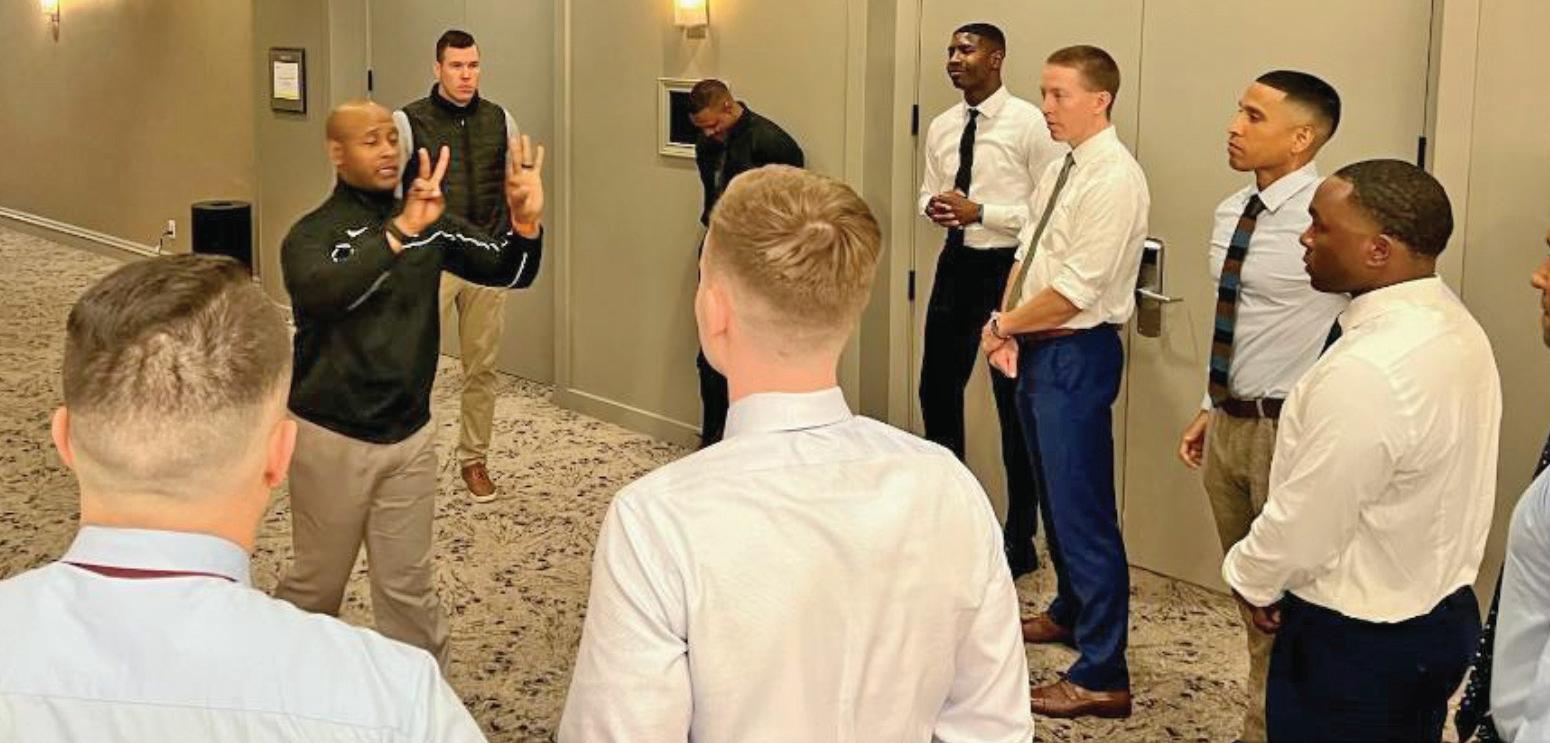
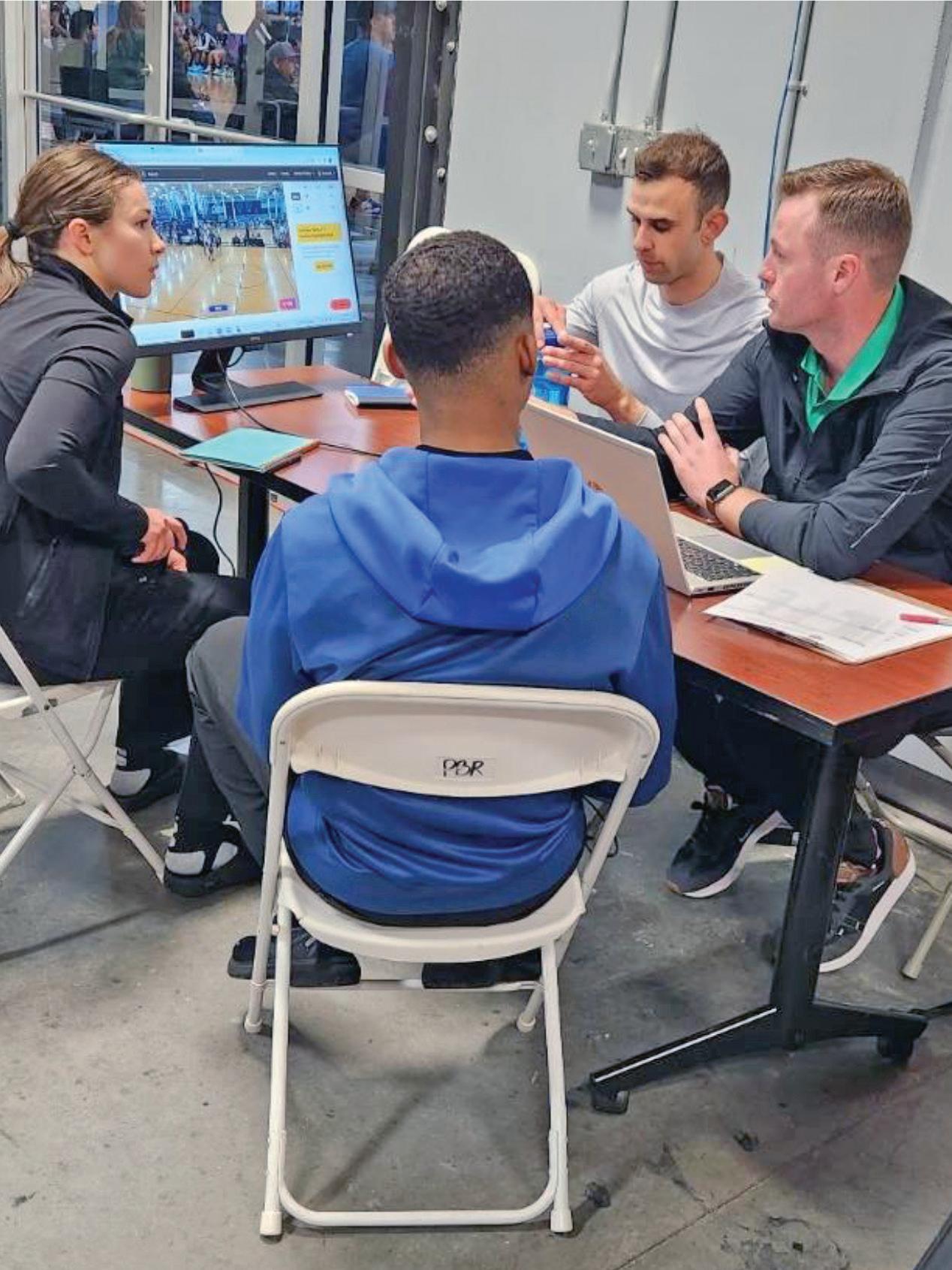
Crawford said. “Referees can apply and submit their videos. People all over the world are being seen now, and it makes it much better. We have a larger pool of officials and the training is much stronger. We can do training on Zoom calls. No one can ever say they didn’t get seen. Once you apply, you’re in the program. It’s totally different, much better.”
Crawford recounts the story of a young official he evaluated recently and was amazed at the official’s ability at age 18.
“More games are on TV — high school games. Get someone to record your game on a Smartphone or an iPad. Watch the video on your computer,” Crawford said. “Watch the NBA referees. Record the games. The so-called good old days of refereeing are not the good old days compared to today. It’s totally different from when I came in during the 1970s and it’s so much better.”
The NBA also uses video to review a referee’s progress, using the Synergy Sports platform and its automated cameras, which are becoming more prevalent in arenas and gymnasiums around the world.
McCutchen said the NBA program has had young referees in their early teens submit schedules and begin the process, and with a much greater acceptance and need for more female referees at all levels of the game, he says the league is welcoming them with open arms.
“What I care about is your ability to adapt and apply what we talk about. I don’t care about your age,” McCutchen said. “We think we can get you into the NBA in four to six years. It’s not as long a period of, let’s say, getting to Major League Baseball as an umpire, often 10 or more years. You won’t get 65 NBA games in

your first year, but if you’re working both G League and high-level college basketball, you can do it. Much of it is based on the number of dates you can give us.”
McCutchen said as part of the collective bargaining agreement, the referees in the program give as many days per month as they are available for G League games, often having to take into consideration their college schedule and if they have a full-time job.
“We will take as many dates as they can give us. We are looking for successful people to develop and grow,” he said. “Successful people find a way to be successful while doing this.”
McCutchen said more than 40% of the officials now working at the G League level are women, which is fast-tracking their acceptance for potential promotions to the full-time NBA or WNBA staff.
“I don’t have to hire women. I am charged with hiring the best officials, and even though cynics will not believe me, I know the truth,” McCutchen said. “I am charged with serving the
28 | REFEREE May 2024
Top left, WNBA official Charles Watson and NBA official Matt Kallio work with officiating candidates on signals. Top right, NBA official Che Flores provides courtside feedback. Bottom, WNBA official Kevin Fahy conducts a postgame video review. COURTESY OF THE NBA
NBA at the highest level, and why would we cut ourselves from half of the general population’s talent and skill set? Why would you eliminate 50% of the population to go and find the best? It makes no sense to me. If I hire the best, some of them will be women.
“All the qualities we look for are not gender-based. Those that rise to the top of this have truly earned their spot. You can be courageous in any package. I just need to know that you can do the job.”
“If you are trying to pursue the NBA as a referee and are interested in this profession, all you have to do is apply and work at it,” Crawford said.
In addition to the G League, the NBA has its Referee Development Program. Six officials who work games at the G League level spend several days a week in the league’s New York officiating office reviewing video and discussing rules, mechanics and game management techniques.
McCutchen made it clear he has been charged with vetting and evaluating referees on merit, and the days of using political connections to advance have ended.
“I have no say in who is in the top 100 and who gets invited. The scouting department does this,” he said with emphasis. “We’re not running a good-old-boy system here. Knowing someone and relationships like that, we do not do nonsense. You are going to be vetted, and there is a process. I am not going to run a system that is based on favoritism or knowing someone. That does not serve the G League, the WNBA or the NBA. I refuse to be a part of anything like that. I want officials who are so good that we must take them. If I am here, that’s how it will be.”
The odds of making it to

the WNBA or NBA as a fulltime referee are long. Of the referees that make it to the toplevel of program, it’s estimated less than one in five advances to work in the WNBA or NBA.
But Battista, Crawford and McCutchen say while the NBA team is tasked with developing the best officials in the world, they have expanded their goals to use the training, technology and career development program to raise the level of officiating at all levels.
“We revel in the fact when someone comes out of our program and ends up in Division I. That’s a success,” Crawford said. “We have good people who know how to train referees. When a high school official works a three-person crew, they do the same thing as an NBA referee. The game is better off when it comes to improving the quality of officiating.”
“We’re looking for people with great attitudes, workers, people who want to get better,” Battista said. “You must put in the time and the effort and become a student of the game. Can you work hard enough to run and manage the game? That’s the key.”

Officials who are part of the NBA’s Pipeline Training and Development program have access to monthly virtual sessions and video quizzes.
“We need more referees. We need great referees at all levels. We share what we have developed, and it’s available for everyone,” McCutchen said. “Officiating is not a job for the faint of heart. To be a good official, you must be able to understand and process plays, and have the courage to fight through the noise of a loud arena and the criticism on social media and a management team that is trying to improve an already high-end performance and get better, and we talk a lot about your mistakes and how to improve. If you can do that, we want you.”
Dan Ronan is a Washington, D.C.-based journalist. He is a retired NCAA baseball umpire and small college and high school basketball referee.
REFEREE May 2024 | 29
© DAVID RICHARD-USA TODAY SPORTS; © KIRBY LEE-USA TODAY SPORTS; COURTEY OF THE NBA

CRUNCH TIME IS CLUTCH TIME
The Plan for End-of-Game Situations
By Joe Maurer
Few moments are as intense and crucial as those that unfold when the end of a basketball game approaches. As the clock winds down, the officials’ decisions become of the utmost importance. During the last four minutes of the game, officials should be in high-alert mode. This
means they should be aware of bonus situations, clocks and call accuracy. The officials should remind each other of game-ending procedures to prevent potential issues.
It’s a good idea the items listed below are covered:
Crew
Late-game timeouts will often provide
the best opportunities to have brief crew meetings to ensure there is an awareness of how the next few minutes of the game will be played.
These brief “check-ins” should not be elaborate discussions but should serve as reminders about what has already happened and some of the strategies that may be applied by both teams in the closing minutes. These DALE GARVEY
BASKETBALL RULES, MECHANICS, PHILOSOPHY 30 | REFEREE May 2024 EDITOR: SCOTT TITTRINGTON stittrington@referee.com
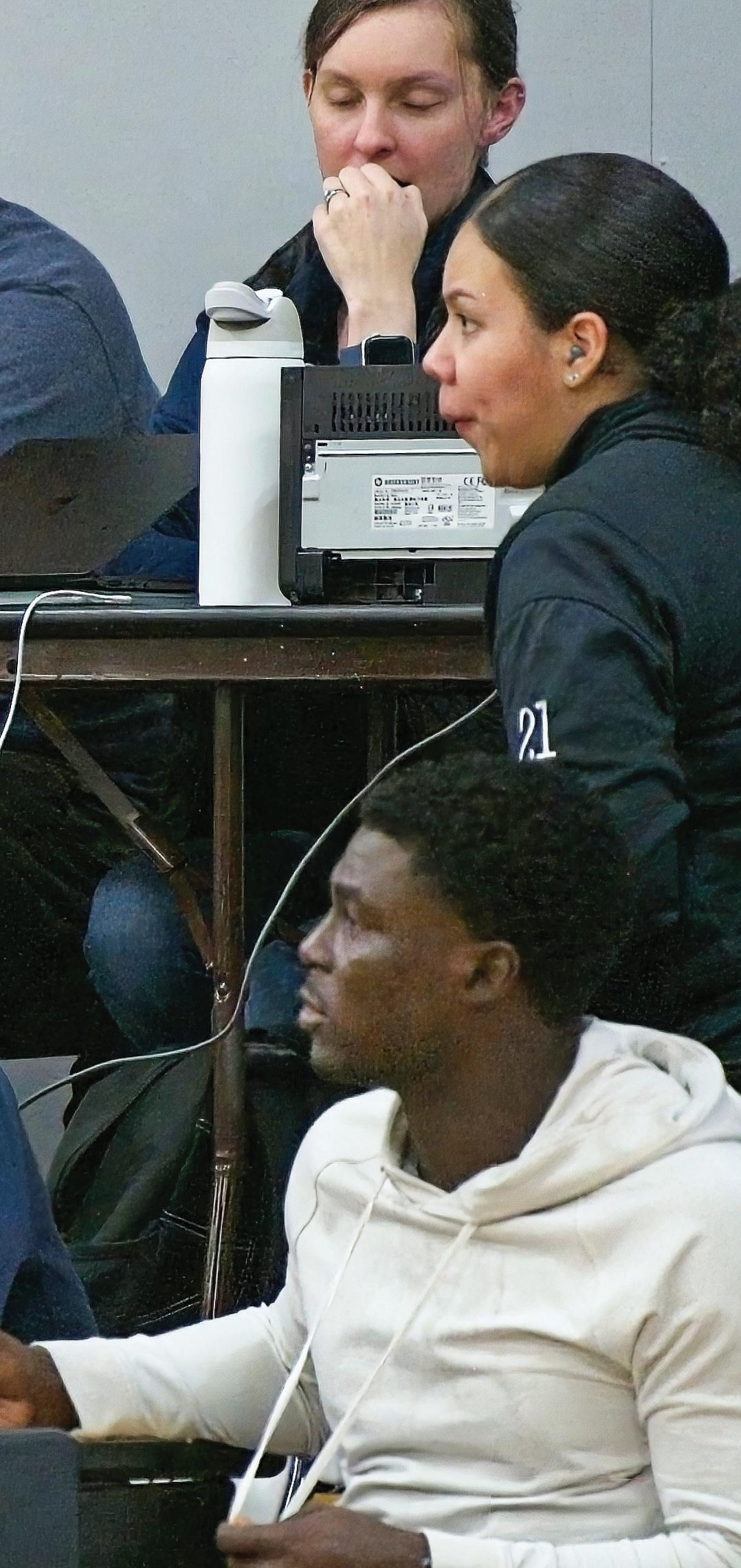
In the closing minutes of a tight game, it’s good practice for the official nearest the scorer’s table to communicate with all necessary parties during a timeout to ensure a clean, accurate finish to the contest. Geoff Weatherbie, Bothell, Wash.
can typically be conducted in about 10 seconds and can be done as soon as the timeout clock has started.
The crew can discuss bonus and timeout situations for each team, as well as which team the possession arrow favors. During games in which a team is trying to stop the clock, it is important to remind one another about making sure the first foul is called.
Also, officials can review lastsecond shot responsibilities and remind
each other that a try for goal involving a catch and shoot cannot occur with three-tenths of a second or less remaining — it must be a tap. Finally, if a foul occurs as the game-ending horn sounds and the score can be tied or the game won by the ensuing free throws, officials must administer the free throws. If the free throws will not change the outcome, the free throws will not be attempted in NFHS, but will still occur in NCAAM/W.
The official administering the throw-in following the timeout should always stand at the new throw-in location. The other official(s) should go to that official for the conference. By standing at this location, it will be clear to both teams where play will resume.
While the officials should be in sync at this time, it is also important to engage with the other “crew members” of the game.
Official scorer
The official closest to the scorer’s table can verify with the official scorer on the accuracy of the scorebook. Hopefully any questions the scorer has had earlier in the contest were already addressed. It doesn’t hurt to have another checkin about the score and to confirm the number of timeouts each team has remaining. Remember, it is not the ultimate decision of the officiating crew to grant a timeout if a team doesn’t have any remaining. There may be a specific reason a coach is trying to stop the clock, even if it results in a technical foul. It is, however, good to have an idea of the strategy the team may employ if there is a situation where a timeout may fit.
Also, it is pertinent to double check the team fouls and the impact on the bonus. As noted earlier, the officials should be aware of the attempt to stop the clock by taking a foul, making sure it is a legitimate attempt to make a play on tbe ball.
Official timer
While at the scorer’s table, the official can also remind the official timer of end-of-game responsibilities. Officials are trained to constantly check the game clocks so errors can be addressed when they happen. At the end of the game, timing is of utmost importance. It is a
BY THE NUMBERS
6
The number of times the NBA has upheld a protest in league history. The last occurrence was following a December 2007 game in which Miami Heat center Shaquille O’Neal was erroneously disqualified from a game against the Atlanta Hawks with six fouls when he had actually only committed five. The game was resumed in March 2008, prior to the team’s next matchup, with 51.9 seconds remaining. However, O’Neal didn’t play — he was traded to the Phoenix Suns between the two meetings.
SURVEY SAYS …
According to the 2023 National Officiating Survey powered by Referee.com, basketball officials overwhelmingly believe the biggest sportsmanship issues are taking place on the competitive youth travel basketball circuit, with 54.32% of respondents singling out that level of play. High school basketball is next on the list at 16.79%, followed by adult recreational (13.60%), youth recreational (11.79%), professional (2.15%) and college (1.36%).
THEY SAID IT

“My role as the crew chief is to come out and do my best to put the crew in a position to succeed. … A lot of this is about the relationships out there on the court. And over time, you build sort of a rapport with them where, they understand that sometimes you make mistakes but it’s not a habit that you get things wrong. And that creates that sense of respect and it gives you some sort of leeway or it provides you some grace. And then my job really is to have that grace extended over to my partners, and in the event that doesn’t happen, it’s my job to discipline the game.”
— NBA official Tony Brothers
REFEREE May 2024 | 31
SOURCE: TWITTER.COM (@OFFICIALNBAREFS)
NATIONAL OFFICIATING
TEST YOURSELF
In each of the following, decide which answer or answers are correct for NFHS, NCAA men’s and NCAA women’s rules, which might vary. Solutions: p. 81.
1. When setting a screen on a stationary opponent outside the opponent’s visual field, how much time and distance shall the screener provide prior to contact?
a. No time and distance necessary.
b. One normal step.
c. One stride.
d. Two normal steps.
e. Two strides.
2. When setting a screen on a stationary opponent within the opponent’s visual field, how much time and distance shall the screener provide prior to contact?
a. No time and distance necessary.
b. One normal step.
c. One stride.
d. Two normal steps.
e. Two strides.
3. When setting a screen on a moving opponent outside the opponent’s visual field, how much time and distance shall the screener provide prior to contact?
a. No time and distance necessary.
b. No more than one step regardless the speed of the moving opponent.
c. No more than one stride regardless the speed of the moving opponent.
d. One to two normal steps or strides.
e. Usually one to two strides.
4. When setting a screen on a moving opponent within the opponent’s visual field, how much time and distance shall the screener provide prior to contact?
a. No time and distance necessary.
b. No more than one step regardless the speed of the moving opponent.
c. No more than one stride regardless the speed of the moving opponent.
d. One to two normal steps or strides.
e. Usually one to two strides.
5. At what point is a try deemed successful?
a. The ball enters from above and passes entirely through the ring.
b. The ball enters from above and passes entirely through the net.
c. The ball enters from above and remains stuck in the net.
d. Both a and c.
e. Both b and c.
the crew should exit the building together and along with game management or security for safety.
good idea to insert a reminder to watch the officials for the clock-start and clockstop signals, especially if the gym is loud and whistles may be difficult to hear. Finally, for NCAA games, prompt the timer that the clock stops on a made field goal (after the ball has passed completely through the basket) after the game clock reaches 59.9 seconds. If there is more than one minute, such as 1:03 on the game clock when the made goal occurs, the clock does not stop at the 59.9 second mark during the countdown to the ensuing throw-in.
Game management and security
On some occasions, such as a rivalry game or an upset, it may be pertinent to identify the location of game management and security. The crew should already have had a conversation with game management regarding that topic. However, taking a quick glance in their direction can provide peace of mind if there is a buzzer-beater or storming of the court.
Overtime
If the score is tied at the end of regulation time, inform each team and the table officials of overtime procedures. This begins with the length of the overtime period and reminding everyone it is an extension of the fourth quarter (or second half for NCAAM). Each team will get an additional 60-second timeout (NFHS), 30- or 75-second timeout depending on the media format being used (NCAAM) or 30-second timeout (NCAAW) and team fouls will remain. The possession arrow will be set after the jump ball administration to start the extra period.
After the game
Following the game-ending horn, the referee should confirm with the scorer that everything is correct, then leave the floor with his or her partner(s). In situations when the score is separated by three points or fewer, it may be
necessary to verbally confirm with the scorer. In games where the margin of victory is greater than three, a visual signal such as a “thumbs-up” will suffice. Be confident everything is correct, as the officials’ jurisdiction ends when they leave the visual confines of the playing court.
There was a time when officials sprinted off the court at the end of the game. Nowadays, it is best to connect with your crew and confidently leave the court together. There is no need to engage with coaches or teams. Remember, you will have your confirmation with the official scorer prior to the final horn. Lingering or loitering after the game is not necessary and can be misconstrued as arrogance or baiting.
A solid postgame crew conference should take place in the locker room. Discuss pros and cons of the game and talk about areas of improvement for the future. This is not the point for officials to interject things they saw but did not bring up while on the court. Those matters should have been addressed on the court before the end of the game. Also, if there is any necessary information to communicate with the assigner, it is best to discuss the facts of the event to construct the game report.
The crew should exit the building together and along with game management or security for safety. It is best to be vigilant until you make it to your car and exit the premises.
The end-of-game procedures are quite complex but should remain routine. It is more than just congratulating your partner(s) for a “good game!”
Joe Maurer, Odenton, Md., is a 25-year high school and collegiate official. He has worked the NCAA Division III tournament, the Maryland State Public Secondary School Athletic Association (MPSSAA) tournament, and is the assigner of IAABO Board 23 in Central Maryland.
BASKETBALL 32 | REFEREE May 2024
Don’t Fear the False Double Foul
By René Ferrán
One piece of advice I hear regularly during pregame discussions is, “Don’t call anything you can’t explain.”
However, ask officials to describe a false double foul, and you’re as likely to get a blank stare and an “I’m not sure” as anything else.
But guess what? You’ve probably called several false double fouls already this season and perfectly explained your decision to a coach without ever uttering those three words.
For example, you called a nonshooting foul against B1 in the frontcourt. During the ensuing inbounds play, your partner calls a team-control foul on A1 for an illegal screen before the throw-in ends.
Congratulations! You had a false double foul.
How so? Because a false double foul, by definition, involves the following:
NFHS (4-20-9): A false double foul is a situation in which there are fouls by both teams, the second of which occurs before the clock is started following the first, and such that at least one of the attributes of a double foul is absent.
NCAAM (4-15.4): A false double foul occurs when there are fouls by both teams, the second of which occurs before the game clock is started after it is stopped for the first.
So in our example, we had a foul on team B, and before the clock started on the ensuing play, we had a foul on team A. The resumption of play under both codes would be to award a throw-in to team B at the designated spot nearest where the foul occurred.
Here’s another example: B1 fouls A2 on a shot attempt that misses. As you report the foul, A2 taunts B1, and your partner calls a technical foul (Class A technical foul in NCAAM) on A2.
How would we adjudicate this situation? With the free-throw lane cleared, A2 would shoot two free throws. Then any team B player would shoot the two free throws for the technical foul (also with the lane cleared). Finally, play would resume with a throw-in for team B at the division line (NFHS) or point of interruption per Rule 7-3.2 (NCAAM).
Notice we haven’t addressed the NCAAW rule set. That’s because the NCAAW rulebook does not address these situations by that particular name or definition. However, when in these situations involving more than one foul the penalty for the second foul includes an awareded throw-in,in the majority of these situations, NCAAW adjudicates the fouls in the order in which they were committed.
So how does a false double foul differ from a double personal foul? That is defined in all three rule codes (NFHS 4-20-8.a; NCAAM 4-15.2.b; NCAAW 10-11.1) with similar language as a situation in which “two opponents commit personal fouls against each other at approximately the same time.” The resumption of play in all three rule
codes for a double personal foul is the point of interruption.
For example, post players A1 and B2 commit personal fouls against each other at approximately the same time while the ball is located in the frontcourt. You would call a double foul, with play resuming with a throw-in at the nearest of the four designated frontcourt spots to where the ball was located when the fouls occurred (NFHS and NCAAM) or nearest to the location of the ball




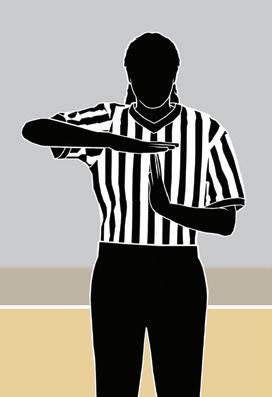
In PlayPic 1, the officials rule that Black No. 0 has committed a common foul against White No. 55. In PlayPic 2, as the officials finish reporting the foul, they assess a technical foul to the coach of the Black team for coming out of the coaching box to argue the common foul ruling. This is an example of a false double foul in NFHS and NCAAM play.
REFEREE May 2024 | 33
1
2
CASEPLAYS
Throw-in Spot After Try
Play: A1 attempts a threepoint try. After the shot has been released and (a) while the unsuccessful try is still in flight, or (b) after A1’s unsuccessful try strikes the ring, but before any player has grabbed the ball for a rebound, B2 fouls A3 near the endline about eight feet outside the lane. Team A is not in the bonus. Where shall the throwin be administered following the foul? Ruling: In NFHS and NCAAM, when the ball becomes dead due to a foul by the nonshooting team that is followed by a throw-in to a team in their frontcourt, the throw-in shall be at one of the four designated spots nearest where the foul occurred. Since the foul occurred near the endline, the throw-in spot shall be at a spot three feet outside the lane line in team A’s frontcourt (NFHS 7-5-3a, 7-5-4; NCAAM 7-3.2.a). In NCAAW, when a foul occurs by the non-shooting team where there is no team control, the throw-in spot shall be at the out-of-bounds spot nearest to where the foul occurred. Therefore, team A shall receive a throw-in on the endline about eight feet outside the lane in team A’s frontcourt (7-3.2.b).
Jumper Catches Ball
Play: A1 and B1 are the jumpers for the game’s opening jump ball. After the referee tosses the ball, A1 taps it, and prior to the ball touching the floor or any other player, B1 catches the ball in his or her half of the center circle. Ruling: It is a violation when a jumper catches the jump ball prior to the ball touching the floor, an official or a non-jumper, thus, B1 has violated. Team A shall be awarded a throw-in for B1’s violation, and the alternatingpossession arrow shall be set toward the team B basket when the ball is put at the disposal of the team A thrower-in. In NFHS and NCAAM, since B1’s violation occurred in team A’s frontcourt, the throw-in shall be at the 28-foot line on the sideline nearest the violation (NFHS 6-3-7c, 6-3-8, 6-4-1, 7-3-3a, 7-3-4, 9-6 Pen. 1; NCAAM 4-9.6.b, 6-2.2, 7-3.2.d, 9-8.1.b). In NCAAW, the throw-in shall be at the spot nearest the violation (4-8.6.b, 6-2.2, 7-3.2.a, 9-8.1.b).
(NCAAW).
The one exception is what happens if a double foul occurs when neither team is in control (e.g., a double foul during rebounding action on a shot attempt)? In this example, the point of interruption depends on if the try is successful (resume with the throw-in following a successful try) or unsuccessful (use the alternatingpossession arrow to determine resumption of play).
Now, what is “approximately the same time”? None of the rulebooks define “approximately,” so one good rule of thumb is if you haven’t blown your whistle (or were in the process of blowing it) for the first foul and the second foul occurs, that’s within the timeframe of “approximately.”
Where the rule codes differ is while NFHS (4-20-8.b) and NCAAM (4-15.3.c) define a double technical foul (when “opponents commit


technical fouls against each other at approximately the same time”), the NCAAW rulebook does not include such a definition.
Instead, the NCAAW rulebook discusses “fouls of equal gravity,” which according to Appendix VI (Basketball Fundamentals) involve “technical fouls … when the number of free throws is equal and play resumes in the same manner.”
In all three codes, the resumption of play for double technical fouls or “non-personal fouls by opposing players with penalties of equal gravity” (NCAAW 7-4.10) is the point of interruption.
Finally, here are two situations that might occur in your game that seem fairly similar, but have different outcomes based on the rule code being used.
Play 1: A1 commits an intentional foul (flagrant 1 personal in NCAAM) on B1. As the official



In this three PlayPic sequence, a shooting foul (PlayPic 1) is followed by a double technical assessed to a player of each team (PlayPic 2). In this scenario, no free throws are shot for the double technical foul. Play resumes with the two free throws awarded for the shooting foul (PlayPic 3).
BASKETBALL 34 | REFEREE May 2024
1 3 2
reports the foul, B2 commits an intentional (NCAAW), technical (NFHS) or contact dead-ball technical (NCAAM) foul against A2.
Ruling 1: In NFHS and NCAAM, this situation would result in a false double foul. In NFHS, B1 would shoot two free throws with the lane cleared, followed by any member of team A shooting two free throws with the lane cleared. In NCAAM, B1 shoots the free throws for the flagrant 1 foul, followed by any member of team A shooting the free throws for the contact dead-ball technical.
The resumption of play in both codes would be a throw-in for team B at the designated spot nearest where A1’s intentional foul occurred in the backcourt or one of the four designated spots in the frontcourt.
While NCAAW does not define a false double foul, the fouls are adjudicated in the order in which they occur, as spelled out in
rules 7-4.12 and 8-6.5. Any team B member would shoot the free throws for A1’s intentional foul with the lane cleared, followed by any team A member shooting the free throws for B2’s intentional foul with the lane cleared. The resumption of play would be a throw-in for team A at the division line opposite the table.
Play 2: A1 commits a personal foul on B1 while in the act of shooting. As the official reports the foul, B1 taunts A1 and is called for a technical foul. The team A coach argues that B1 should have been ejected from the game and also is called for a technical foul. Ruling 2: In NFHS and NCAAM, this situation is a false double foul, and each foul is penalized in the order it occurred. In NFHS, B1 would shoot two (or three) free throws for the personal foul, followed by any team A player shooting two free throws for B1’s technical, then any team B player shooting two free throws for


the team A coach’s technical. The resumption of play is a throw-in for team B at the division line.
In NCAAM, B1 would shoot the free throws for the personal foul, and team B would get a throw-in using the procedures outlined in 7-3.2. No free throws would be shot for the technical fouls.
In NCAAW, because the technical fouls occurred during the same stopped-clock period following the original foul, and each results in the same penalty (two free throws and a throwin at the division line), they are considered fouls of equal gravity, and the free throws for each shall be canceled (7-4.13.c). Play resumes with the two free throws by B1 that resulted from the shooting foul, with the lanes filled.
René Ferrán is a freelance writer and editor who lives in Portland, Ore. He officiates high school basketball and baseball, as well as youth soccer.



• MOR E PAGES • MOR E MECHANICS • MOR E INSTRUCTION AVAILABLE NOW STORE. /BASKEtBALL YOU’VE NEVER SEEN AN OFFICIALS MANUAL LIKE THIS! $2095 * DIGITAL PRINT $2595 COMBO $2195 *
THE NEW BASKETBALL OFFICIALS MANUAL

36 | REFEREE May 2024

Whether on the Pacific Coast, along the Eastern seaboard or anywhere in between, discussions about the ongoing shortage of officials are percolating throughout the industry. But as industry stakeholders continue their conversations and search for solutions, assigners are dealing with the here and now, and doing their best to cover the games for which they're responsible.
One Friday this past fall Sue Wilson, who assigns high school soccer officials for three leagues in the Philadelphia suburbs, was tasked with assigning no fewer than 31 varsity games (two officials per game) and 66 more below the varsity level (two officials, if available, for high school JV games, and one official for games at lower levels).
All told, Wilson had 161 slots to fill. She was unable to fill them all. As a result, some junior varsity and lower-level games became scrimmages with the coaches handling the officiating chores.
Brian Kammersgaard, a longtime soccer official and former coach, serves as chairperson for both boys’ and girls’ soccer in the Pennsylvania Interscholastic Athletic Association’s (PIAA) District One, which encompasses the Philadelphia suburbs.
Like Wilson, Kammersgaard still officiates himself. He notes on one weekday this past season, 104 soccer games were scheduled at various levels in the Philadelphia suburbs. Ideally, that would require 208 officials. Unfortunately, there are not that many PIAAregistered soccer officials in the Philadelphia suburbs.
“When you don’t have more than 160-odd officials registered, something’s going to give,” Kammersgaard said.
The real-time circumstances described above are not unique to soccer nor to southeastern Pennsylvania. Assigners in all locales are increasingly finding themselves with more games to cover than officials to cover them.
That circumstance creates a ripple effect.
With fewer officials in the pool, those that remain, especially veterans, may find themselves overworked. Assigners may have to cover games with less than the ideal amount of officials, perhaps assigning five officials to a varsity football game rather than six, two to a varsity basketball game rather than three or one umpire to a softball game instead of two.
Some contests may have to be postponed or canceled because officials are unavailable. And
By Rick Woelfel
REFEREE May 2024 | 37

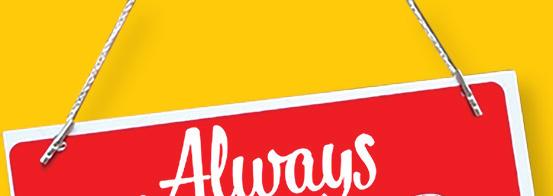


assigners may find themselves putting officials on a game despite their lack of experience or savvy to handle the assignment.
Michael Book is an assistant commissioner for the Colorado High School Activities Association (CHSAA) and oversees the organization’s officiating efforts. He also officiates junior college basketball.
Book said the pandemic exacerbated the shortage of officials in his state.
“We saw obviously a huge dip in officiating numbers during the pandemic and even the following year after The COVID-19 pandemic has only exacerbated what was already a dire shortage of officials. Ralph Alk, Monrovia, Calif.
that, and are slowly starting to recover from that, which is a good thing,” Book said during a panel entitled “Too Few of Us” at the 2023 NASO Summit in Riverside, Calif. The panel, which took place July 31, also featured NAIA director of officiating initiatives Justin Gragg; South Coast Conference Commissioner Rich Kollen; NCAA volleyball official Deanna Schneyer; Andrew Walker, director of education and training for the United States Tennis Association (USTA); and Pac-12 Conference Vice President of Officiating David Coleman.
Book, who has been in his

post as assistant commissioner for about two years, recognized the issue of burnout early on. With fewer officials available, those who remained often found themselves working heavier schedules, either by choice or from necessity.
“I’ve heard that perspective of officials working six nights a week,” he said, “and multiple times per night and burnout and that kind of thing.”
It’s not uncommon for Wilson to ask an official to pull double duty — a game in the afternoon, usually with a 3:30 p.m. start, followed by a night game at a different location starting at 7 or 7:30 p.m.
A varsity night game is generally preceded by a JV game, but Wilson avoids scheduling her officials back-toback without a break.
“If the JV game is first, the varsity game gets a tired official,” she said.
And obviously not every official working below the varsity level is truly ready to step up. But sometimes it’s necessary for them to do so.
In the dual system of soccer officiating, the two officials work as equals. If one of the pair is inexperienced, however, the senior partner must assume additional responsibility.
“It happens every day where you look over and you know your partner is a little green, and you have to cover more of the field than you normally would,” Kammersgaard said. “That’s why you sometimes have to assign a strong official with notso-strong of an official and hope that it works out and you can get through it.”
It’s not uncommon for assigners to shuffle the schedule when necessary. If a spot opens up on a game involving two elite teams, an assigner will often move a veteran over from another game, rather than drop an inexperienced
MESSINA
BOB
official into deep water and hope they remain afloat. There are occasions when an official arrives at a game site, only to be told to go elsewhere instead.
But in the end, all the shuffling still leaves an open assignment that hopefully can be filled.
In today’s world, assigners often find themselves plugging leaks in a wall while at the same time looking to strengthen its foundation by adding numbers to their pool of officials. But what’s the most effective way to replenish that pool?
One approach is “start them young.” USA Hockey technically has no minimum age for officials (subject to child labor laws in individual states); some of its officials have been as young as age 10. USA Hockey highly recommends young officials do not work games involving players their own age or older.
The West Virginia Secondary Schools Activities Commission (WVSSAC) recently introduced a policy that allows individuals as young as 16 to officiate freshman and middle school contests.
The PIAA also has a policy that allows high school-aged students to officiate freshman high school and middle school games, provided they work with a partner.
In terms of numbers, high schools and colleges are potentially fruitful sources of officiating talent. High school is when many studentathletes hit their ceiling as players. Officiating provides an opportunity for them to stay actively involved in sports.
The high school catcher who doesn’t quite have the bat speed or arm strength to succeed at higher levels of baseball may well have what it takes to be an excellent umpire. The soccer player who lacks the speed to play in college perhaps has the
game sense that makes her a good fit for refereeing.
Then there are those of high school and college age who never found success on the field as athletes but are passionate about sports. Students with those sorts of backgrounds may find officiating provides them with an opportunity to embrace their passion.
Gragg, who officiates BCSlevel football in the Mountain West in addition to his role with the NAIA, is committed to getting more college students involved in officiating.
“One of my primary goals for this year is we’ve got to get Officiating 101 on every NAIA institution campus and find a way to give back,” he said at the Summit. “We’re working with the NFHS to try to figure out how we can get that curriculum built back in. The officials that we’re going to have three years from now need to start somewhere from a lower level. And hopefully we can help fund part of that process as well as be a foundation for the learning atmosphere for those officials that are trying to get started regardless of their age. We may go after the student-athletes of today to give back to the sport that’s given so much to them.”
Gragg would like to expand that outreach effort to those of post-college age who are now engaged with job and family responsibilities.
“It’s the alumni that we’re trying to get to,” he said. “How do we get to them after life has started, after they’ve had their first job, after they’ve had their family, and now they want to get introduced to it? So that 28-year-old, the 32-year-old who’s just getting started, there’s a place for them as well.”
In Colorado, Book and his assistant, Monica Tillman, devised the “You Look Good in Stripes” program, an initiative meant to break down the barriers new officials face

With fewer officials in the pool, those that remain, especially veterans, may find themselves feeling overworked.
Kenneth Arrick II, Orange, Calif.
when entering the industry. The program reimburses new officials for the costs of equipment and dues, among other perks.
“There are two parts to You Look Good in Stripes: One, we wanted to create a pipeline of new officials and deal with barriers like the cost and challenge of getting signed up, the cost of uniforms, that kind of stuff,” Book said. “We heard over and over again that it was very difficult to figure out who to contact and how to sign up. So that became a very key factor for us. Then we went to our foundation at the CHSAA office and asked them for some funding so we could cover the dues for a new official. A lot of new officials can’t afford that, especially coming out of college and after the pandemic.”
REFEREE September 2022 | 39 HESTON
QUAN




In the first year of You Look Good in Stripes, the CHSAA registered more than 1,100 new officials.
But not all recruiting efforts produce that level of turnout. Wilson spoke about one of the PIAA’s attempts to garner interest in officiating.
“We ran a (virtual) class in the fall of 2022,” she said. “There were 15 people that signed up; the PIAA waived the registration fee. Out of those 15, 12 actually took the class, and only one stuck with it and is now working tons of games.
“We’ve reached out to colleges and gotten no response. We tried reaching out to clubs and got no response.”
Efforts to recruit officials, which have increased in recent years, have seen mixed results across the U.S. Yiyang Zhao, Redmond, Wash.
All new officials need support, but that support is especially important for officials who are of high school and college age. Dealing with abuse is never easy but for a teenager whistling one of their first games, the experience can be especially traumatic — traumatic enough for them to cast officiating aside before they have a sense of what it’s about.
A good mentor can talk a struggling young official “off the ledge.”
Walker believes mentormentee relationships are important to an official’s development and to the health of the officiating industry.
“It doesn’t matter what level you’re working,” he said at the Summit. “You can be a
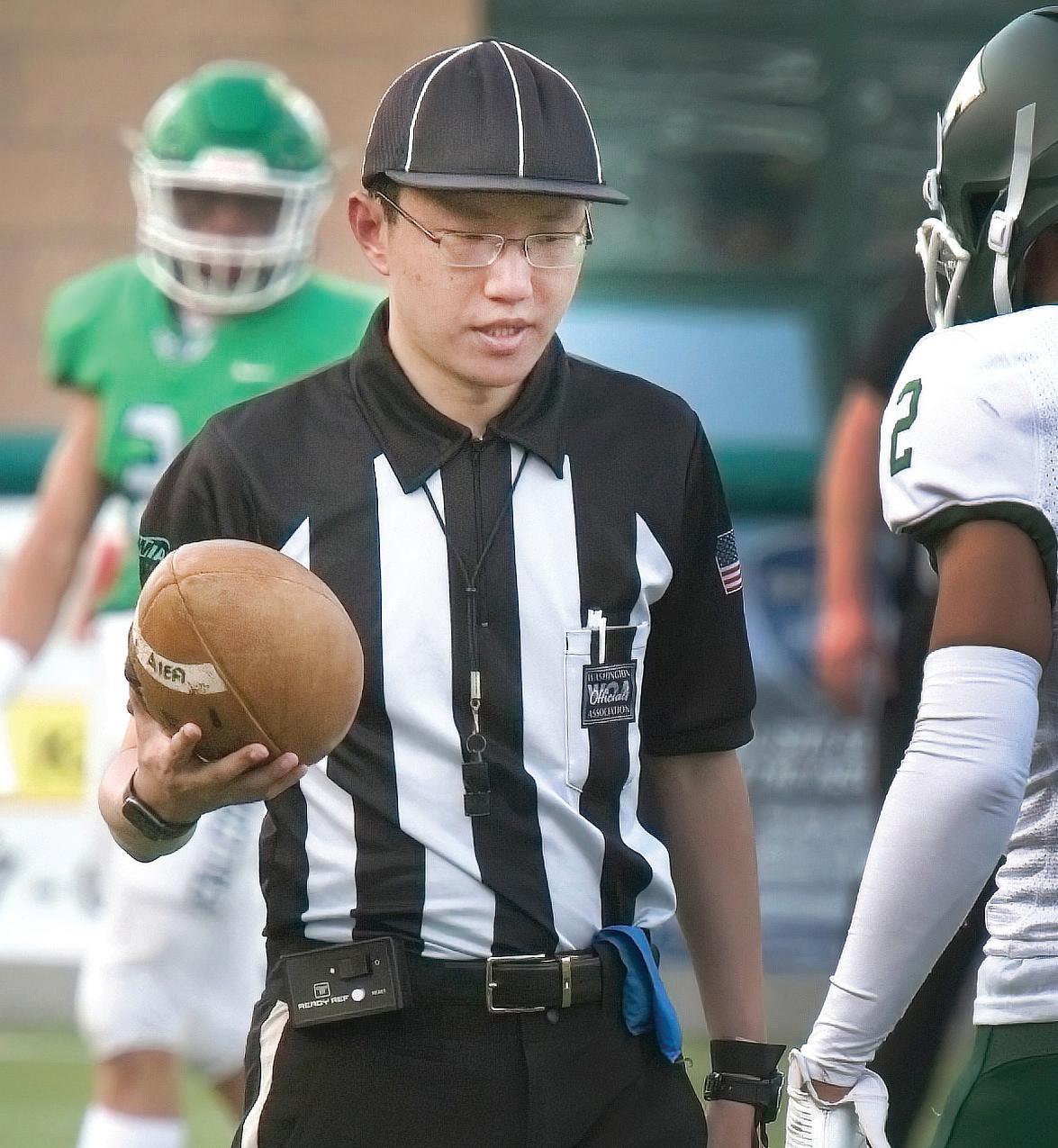
mentee and a mentor at the same time. You always have that room to grow and keep learning and even someone to bounce things off of. I think it’s really important especially to build that sense of community within your officiating family there. Because if you’ve got that connection, you start building those relationships, you really get that sense of community which is so important.”
Schneyer, who works various levels of volleyball in Southern California, noted the importance of interpersonal relationships.
“We’re either reaching up and getting that help and we’re a mentee, or we’re reaching down and pulling people along with us,” she said at the Summit. “And in this sport, in this career, we have to have those relationships. I mean in volleyball we play with six or seven people on the court. It’s a team sport.
“Now, when we officiate, we are officiating as a team. We almost always, unless it’s junior (level), have a partner. It’s a team. So in order for us to grow individually and as a cadre we have to be able to have those conversations and more importantly the relationships. Because the conversations about how we did in a match are the conversations about how we did in a match. But the relationships and the investment in the individuals, that’s where the magic is at. That’s why most of us are here is because we’ve had mentors that have helped us along the way.”
Some local officials associations have formal mentoring programs that pair new officials with a veteran in mentor-mentee relationships. Those pairings should be considered carefully. Personalities should mesh.
DALE GARVEY
Not every veteran official has a personality suited to a mentorship role. Some excel at it; others find the task daunting at best. And if the veteran is impatient with or dismissive of the novice, the newcomer may be hesitant to approach them for advice.
Whether in a formal meeting situation or elsewhere, it’s important for newcomers to be made to feel comfortable.
“We probably all have been that official who sat in the back of the room for the first time,” Gragg said. “They sit at the back, over to the side, and don’t get talked to much. They see all the veteran officials walk in the room and give each other hugs and high fives. They see that, but they’re left out. I think the ability to pull those young officials aside as a group just among themselves and talk to them would maybe help them open up. Because very few of them are going to feel comfortable raising their hand in an audience that is full of veterans.”
It may seem a simple matter to attract more people to officiating by increasing game fees. But the reality is more complex. Depending on the level of play and location, game fees might be determined by a state association office, a league or conference commissioner, or as the result of negotiations between a conference and an assigner.
As commissioner of the South Coast Conference, Kollen assigns football, basketball and softball for 12 junior colleges in Southern California. He reminded the Summit audience that at a time when school districts are watching their budgets more closely than ever, game fees at the high school level and above must keep up with costs that officials face.
“We need to make administrators aware of the
fact that, for instance, in Pop Warner football or whatever they call it now, you can go out and work three games on Saturday and make $200,” Kollen said. “And I’m asking an official to spend five or six hours to make $200 and work one community college game. It’s an uphill fight.
“We’re not boycotting. We’re not going to say we’re not providing. But if you have an opportunity, you make administrators aware of the fact that our fees are low.”
The officiating shortage isn’t likely to end any time soon and the situation is likely to become more critical as the older generation ages out.
All new officials need support, but that support is especially important for younger officials. Kacie Moorehouse, Bellevue, Wash.
Kammersgaard would like to see more soccer players pick up a whistle. He knows the future of the sport may be at stake.
“At the (U15 and U16) levels, a lot of players stop playing,” he said. “I think you might be able to grab some kids and say, ‘Here’s a way you can stay involved. You can make a good deal of money and at the same time you’re part of giving back to the game.’
“Because, as it is right now, in five years or 10 years, there are going to be no referees.” Rick Woelfel, Philadelphia, is a freelance writer and softball umpire.

ADAM LU
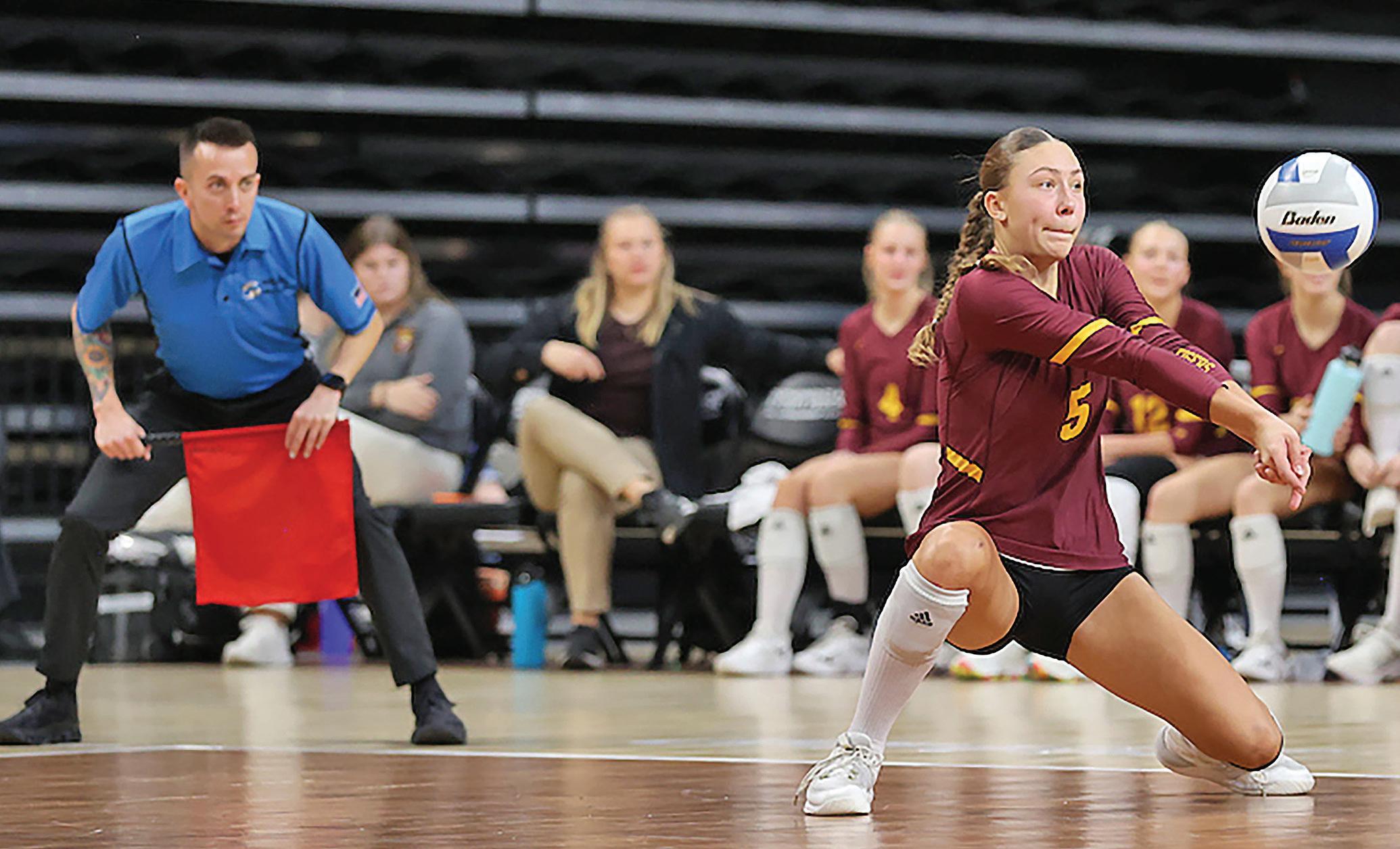
NFHS ADOPTS NEW RULES
Line Judge and Prematch Protocols Highlight Changes
By Brad Tittrington
The NFHS Volleyball Rules Committee met in January in Indianapolis and recommended four rule changes for the 2024-25 season, which were subsequently approved by the NFHS Board of Directors. The four adoptions affect uniform rules, prematch announcements, line judge protocols and injury substitutions involving a libero replacement. The committee also made several editorial changes, including adding a suggested prematch protocol.
“The committee had some great discussions about potential changes that would have a larger impact on
the game,” said Lindsey Atkinson, NFHS director of sports and liaison for volleyball. “At this time, the committee did not feel that any of those changes would necessarily improve the game and felt that the game of volleyball is in a great place from the perspectives of the student-athlete, coaches, officials and administrators. As new rules are adopted at other levels of play, the NFHS Rules Committee will continue to discuss the potential positive and negative impact that those could have on the high school game.”
Below are the rule changes, a breakdown of major editorial
changes that could impact the game, as well as a look at mechanics changes the committee amended for the upcoming season. Referee thanks Atkinson for reviewing this article.
Legal Uniform/Roster and Lineup
4-2-3 Note (New), 7-1-1 Note
The committee voted to approve adding a new note to the uniform rule (rule 4) to address when it is legal to change a player’s uniform number, aligning the language with the roster and lineup rule (rule 7). This change also expands to include a damaged uniform as a legal reason for changing a uniform number. It is now legal for a player to change the
VOLLEYBALL RULES, MECHANICS, PHILOSOPHY EDITOR: BRAD TITTRINGTON btittrington@referee.com 42 | REFEREE May 2024
PHOTO COURTESY OF SOUTH DAKOTA PUBLIC BROADCASTING. ©2023 SDPB JOSH JURGENS
The NFHS Volleyball Rules Committee adopted new language to mandate states that currently don’t have teams switch sides between sets to adopt a new rule that requires the line judges to swap sides each set. This allows teams to have both line judges on their sides during a match in the same fashion teams that do switch sides each set would face. Michael Blegan, Sioux Falls, S.D.
jersey and uniform number without penalty if the uniform is damaged or has blood on it.
Play 1: In the second set, A1 dives to play a ball and the contact with the floor causes a large rip in the jersey. Team A’s coach substitutes A2 into the game for A1. A1 leaves the court and changes into another jersey with a different number than what is listed on the roster and lineup. After a couple of points, team A’s coach requests a substitution to put A1 back in the game for A2 while wearing the new jersey. Ruling 1: Legal. The second referee should notify the scorekeeper of the number change and have the scorekeeper update the new number on the scoresheet. There is no penalty assessed to team A.
First Referee Responsibilities
5-4-3c(1)
This change allows a team to include all players on the roster, not just the starting players, in the prematch announcements by allowing the entire team to stand on its respective endline prior to the first set. State associations and/or teams may continue to limit players on the endline to just starting players and the libero. The change allows for the inclusion of all players but does not mandate teams to do so.
In the past, teams would only have starters and the libero line up and be recognized before the first referee whistled and signaled to begin the match, and all other team members would remain on the sideline or at the bench. This change allows all players to be recognized and participate in the prematch handshake.
Play 2: Prior to the first set, team A has its entire roster line up on the endline for team introductions while team B only has its six starters and the libero line up on the endline, keeping the remaining team members at its bench. Ruling 2: Legal. The rule change does not mandate all players must be on the endline; it simply allows teams to have their entire roster line up
if they choose to do so. There is no penalty if teams choose not to include the entire roster.
Line Judges Responsibilities
5-9-2b Note (New), State Association Adoption Chart
By state association adoption, teams can stay on the same side of the court throughout the match and not switch sides between sets. During the pandemic, this state adoption became a mandate in many states who adopted the NFHS pandemic guidelines. Since then, many states have continued to adopt this rule modification. Because of that adoption, line judges were always with the same team throughout the match. In order to combat this, the committee voted to mandate those states who use this rule adoption to have line judges switch sides between sets. This allows line judges to see each team, just like they would if the teams switched sides after each set.
Injury 11-4-1b
The final rule change allows teams to substitute during an injury timeout (even though a replay is called) for the libero replacement if the libero is injured or ill. This change allows for the immediate substitution of the libero replacement who may be playing out of position due to the injury to the libero. While a replay limits a team from substituting, when the replay is called due to an injury of the libero, a substitute is allowed for the libero replacement. Previously, when a libero was ill or injured during a play and a replay was called, the libero replacement had to go back into the game until the completion of a rally, and then the team could substitute for that libero replacement. The new rule allows teams to immediately substitute for that libero replacement without having to reenter for a point.
Play 3: In the second set, team A’s libero dives for a ball and rolls an ankle. The first referee immediately blows the whistle and issues a replay. The libero is unable to continue and team A’s
DID YOU KNOW?
The libero position initially was adopted in 1998 by FIVB (the international governing body of volleyball) and USAV first used the position in 1999. NCAA rules adopted the libero position for the first time in 2002. The NFHS fully incorporated the use of the libero for the 2006-07 season, becoming the last of the major governing bodies to adopt the position. USAV changed its rules in 2011 to allow two liberos and the NCAA recently adopted the same rule to take effect this upcoming season.
QUICKTIP
Check and double check the referee stand before the match to make sure it is safe and secure. Take the extra time to make sure the stand is level, attached properly, and all pins are in place and secure before climbing the ladder and placing yourself on the stand. Failure to do so can lead to severe injury. If the stand is not properly set up, have host management fix the problem before starting the match.
TOOLS
Rule and Technique Comparisons
Do you work multiple levels and for multiple organizations and struggle to quickly find the rule differences or mechanics deviations between them? PAVO’s website has two documents that can help you quickly find what you need. The first document is a rules comparison between NFHS, NCAA and USAV, and the second document is a technique comparison between NCAA and USAV. If you are an official working these levels, go to pavo.org/Rules-and-Tools/RuleComparisons. These documents should be part of your yearly rule and mechanics training as you prepare for the upcoming season to help make sure you know all the differences.

REFEREE May 2024 | 43
VOLLEYBALL
TEST YOURSELF
In each of the following you are given a situation and possible answer(s). You are to decide which answer(s) are correct for NFHS, NCAA or USAV rules, which might vary. Solutions: p. 81.
1. A live ball is in play after it was served by team A. On team B’s second contact, the ball goes high into the air and lands on the top side of a retractable batting cage that is attached to the ceiling. The ball comes to rest over team B’s playable area. What should the first referee do?
a. Blow the whistle, signal out of bounds and award a point to team A.
b. Blow the whistle and issue a replay.
c. Blow the whistle and award a point to team B.
d. Allow play to continue and wait and see if the ball will move.
e. Blow the whistle and issue an unnecessary delay/delay warning to team B.
2. Which is required for a volleyball to be considered legal for competition?
a. An NFHS Authenticating Mark.
b. The ball must be all white.
c. The ball pressure should be between 4.3 and 4.6 pounds/ square inch.
d. The ball pressure should be between 4.26 and 4.61 pounds/ square inch.
3. Team A’s libero sets a ball in front of the attack line using overhand finger action. A1 then jumps to attack the ball and contacts the ball completely above the height of the net for the team’s second contact. The ball hits the net tape (untouched by team B) and rebounds to team A’s side of the court. A2 then bumps the ball over the net. This is a legal play and play shall continue.
a. True.
b. False.
4. Which of the following lettering is allowed on the back or front of a uniform top?
a. Player’s name.
b. School’s nickname.
c. School’s name.
d. Mascot.
e. None of the above.
f. All of the above.
Sample Prematch Warm-up for Dual Matches
Timing Protocol
60 minutes before start of match
No later than 30 minutes prior to start of match
No later than 20 minutes prior to start of match
Prior to timed warm-ups
Timed warm-up begins
Minimum 4 minutes
Minimum 4 minutes
No later than 2 minutes prior to the end of timed warm-up
Timed warm-up ends
Court setup by host management and available to teams
Officials arrive on court in uniform
Assistant officials report to first referee
Prematch conference (rosters due)
Timed warm-up – shared court
Timed warm-up – home team’s court
Timed warm-up – visiting team’s court
Lineups due
Audio signal to indicate the end of timed warm-ups Announcements
(National Anthem, Introductions, etc.)
Team huddle Match begins
NOTE: Times may be adjusted to accommodate arrival times, facilities, tournaments, etc. It is recommended that each team get a minimum of 4 minutes on the court for hitting and serving.
coach does not want A1, a middle blocker, to play in the back row and immediately substitutes A2, a defensive specialist, into the game for A1. Ruling 3: Legal. The rule change allows an immediate substitution for the libero replacement.
Play 4: In the third set, team A’s libero dives for a ball and rolls an ankle. The first referee immediately blows the whistle and issues a replay. Team A’s coach wishes to substitute A2 in for A1, the libero replacement, and also wants to substitute A3 for A4 in the front row. Ruling 4: The second referee should allow A2 to substitute for A1, since it deals with an injured libero. However, since this is a replay, the substitution of A3 for
A4 should be denied and the head coach must wait until after a completed rally to make that substitution.
Suggested Prematch Protocol (New)
The rules committee added suggested prematch protocols, including warmup procedures. The committee provided a sample prematch warmup protocol (as seen above) for states to use with the timing that works best for them. It is recommended each team get a minimum of four minutes on the court for hitting and serving. It is important for referees to know what protocols are in place in the state they work.
“The rules committee has
44 | REFEREE May 2024
been concerned about the number of concussions that occur during prematch warmups — as reported by High School RIO (Reporting Information Online) — for several years, and the 2023 questionnaire results overwhelmingly supported the committee’s action of creating a set of suggested prematch protocols,” Atkinson said. “The protocols are a way for the committee to provide guidance for states and schools to lessen the risk of injury during this time while not mandating by rule how a state divides warmup time.”
Player Actions 9-5-6b
The committee made a slight change to the wording of the rule when describing the setting action of a libero that results in a completed attack above the height of the net.
The committee changed the word “overhead” to “overhand” so the rule now reads it is illegal for the libero to “set the ball using overhand finger action while on or in front of the attack line extended, resulting in a completed attack above the height of the net.”
The change in language is what was initially intended when the rule was passed several years ago and now mirrors the language in both NCAA and USAV.
Introductions and National Anthem Protocol
There has been a change to the prematch protocol when it comes
to the national anthem, unless determined otherwise by state association adoption. At the end of the timed warmup, the first referee and the line judge on that side (LJ1) will walk across the court to the first referee’s side. Those two officials should be on the left side of the net, looking from the officials table, with the first referee closest to the net post. LJ1 will place the flag on the referee stand
during the announcements and the anthem. The second referee and the line judge on that side (LJ2) will stand table side near the net post on the opposite side of the court from the first referee and LJ1 and LJ2 will leave the flag on the table. The second referee will be closer to the net post (as shown in the MechaniGram). Previously, all four officials walked across the court for the announcements and anthem and then the second referee walked back across the court while LJ2 walked around the court and into position.
Tracking Sheet Instructions
The committee amended how the libero tracking sheet should be utilized during a match. Previously, anytime the libero entered the set as a replacement, the tracker would cross off the number of the player the libero was replacing and place an “L” on the line next to that number. Now, the tracker will simply just place the “L” next to the number of the player and not slash out the player’s number. This makes the tracking sheet more legible and should prevent confusion when the tracker is trying to quickly count the number of substitutions used by a team in a given set.
Brad Tittrington is an associate editor for Referee . He referees college and high school volleyball, umpires D-I softball and officiates women’s college and high school basketball and high school football.
Opining on Offseason Opportunities
By Robert Doan
You may read the title of this article and laugh because it does not seem there is a volleyball offseason. If that fits, thank you for everything you do for our sport. We are blessed to officiate a popular sport with all age groups. With that said, everyone has an offseason, even if it is only for a few weeks. This article will explore ways to make the “offseason” productive.
Join Another Volleyball League
If you are a high school or college official, consider joining USAV or another youth travel sports organization. Many high school officials may work four to five matches a week. In youth travel events, an official could work six to eight matches in one day. The majority of people who want to improve their officiating skills mention travel sports as an opportunity to work on their “areas of weakness” because of the opportunity
to work multiple matches in a day/ weekend.
Research on player development recommends youth athletes play multiple sports. There have not been many research studies regarding officials working multiple sports, but the principle behind the reasons for multiple sports could correlate. It is found athletes’ bodies will be healthier if they train for different sports and their motivation for their favorite sport will increase when they do not train
REFEREE May 2024 | 45
OFFICIALS TABLE REFEREE STAND R2 LJ2 R1 LJ1
VOLLEYBALL
CASEPLAYS
Legal Contact?
Play: A1 attempts to retrieve a pass from a teammate near the referee stand. A1 saves the ball by holding onto the referee stand and playing the ball with an open hand back toward teammate A2, who then spikes the ball for a kill. The referee awards a point to team A. Ruling: Incorrect ruling in all codes. Because A1 gained an unfair advantage in playing the ball by holding onto the referee stand, the point should have been awarded to team B (NFHS 9-6-7b; NCAA 14.4.2.2; USAV 9.1.3).
Substitution
Play: After a timeout, the second referee whistles and returns the court to the first referee, who beckons for serve. Team B wants to make a substitution. B1 walks into the substitution zone. The second referee denies the substitution. Ruling: Correct procedure in all codes. The head coach or game captain must make the substitution request prior to the first referee beckoning for serve (NFHS 10-1-2c; NCAA 11.3.3.2.6; USAV 15.11.1.1).
Game Equipment
Play: The officiating crew arrives to the court 45 minutes before the match is scheduled to start. During the prematch check, they notice there is no padding on the referee stand. The first referee makes the decision to start the match anyway. Ruling: Incorrect procedure in all codes. The officiating crew should inform host management of the problem and check to ensure the padding meets the requirements before the match can begin (NFHS 3-1-3b and Pen.; NCAA 2.3.2.2 and Note; USAV 2.6e).
Nonplayer Interference
Play: During a rally, A1 tries to make a play on a ball near the bleachers. The ball hits the ceiling after the team’s second contact and is redirected toward the endline where the line judge is standing. As A1 adjusts, the line judge steps in the way and knocks A1 to the ground as the ball lands inbounds. The first referee calls for a replay. Ruling: Correct. A replay may be issued when an official interferes with a player’s legitimate effort to play the ball in a playable area (NFHS 9-8-1f-1; NCAA 4.2.4; USAV 17.2).
and play that sport all year. This could work in sports officiating as well. We can improve our physical skills as well as increase our officiating motivation by officiating a different sport in the offseason. An added bonus is helping other sports with their official shortages.
Study Rules and Watch Film
Many officials study the rules during the preseason. Understanding the rule code and reviewing all rules before the season starts is important. Another reason to study the rulebook before the season is many associations require the official to pass an annual rules test. At times, it feels like we are rushing for the season by studying rules, attending clinics, etc., which makes studying the rules difficult. During the offseason is a great time to slow down and really study the rules. Try to understand the purpose of the rules and how to apply them in different situations.
The same can be said about watching film. During the season, many watch films to see if they “got it right.” The offseason is an excellent time to watch the entire match or to watch films from other officials’ matches to learn what was done correctly and what might need to be called or performed differently next time.
If you are a USAV official, the offseason is also a great time to rewatch the modules provided to volleyball officials for training. Similar to PAVO members, RefSchool and iREF are great resources to use during the offseason. Attending camps and clinics provides great opportunities to improve your skills and meet other dedicated officials during the offseason. All of these resources take time, and the offseason is the perfect time to take advantage of some of the benefits offered to officials.
Manage Home and Work Life
Volleyball season can cause a strain on home and work life. Leaving early or missing meetings to make an early match time is a balance many officials try to manage during the season. Only seeing your family before work or school because you have a match after
work, or leaving on a Friday afternoon and not getting home until Sunday for a travel volleyball weekend, can be difficult. Many officials will plan family trips during the offseason with family and friends. It is important to reconnect with fellow employees as well as your family. It might also be important to work a little later some days to earn the right to leave early during the season.
Rest
Many of us do not know the meaning of rest but need to learn. Sleep in on the weekend, cook dinner at home and catch up on your favorite TV show during the week. Believe it or not, this is what many people do with their free time during the week. Most of us miss out on this because we are always running to different matches or tournaments. Use the offseason to rest your mind, body and soul. Read a book, work in the garden, exercise and get a little more sleep. Your body and mind will thank you later. The season can be a grind both mentally and physically, especially if you are working higher levels and constantly in and out of airports and hotels, not to mention the extended windshield time you may experience while driving between matches. Take time in the offseason to properly recuperate.
Summary
Although many of us have a short offseason because of the continual nature of athletics, try to use the offseason time wisely. Rest, keep your mind sharp by studying or attending clinics, and reintroduce yourself to family and friends whom you might not interact with as much as you would like. Update any house or yard projects you started and did not finish. Ensure you are in good standing at your job, not to mention with your significant other and kids Use your time wisely because the next season will be right around the corner again.
Robert Doan, Ph.D., has been a high school, college and USAV official for more than a decade. He is a resident of Charleston County, S.C.
46 | REFEREE May 2024







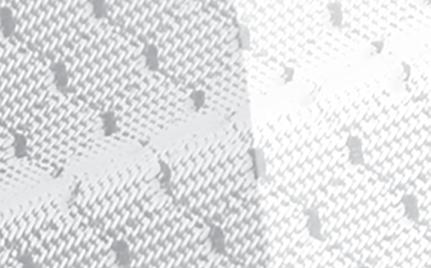




VISIONINACTION



Solutions for Sustainable Officiating

With the theme “Sustain Officials, Retain Officials” NASO is targeting retention as a key to combating officiating shortages during this summer’s annual event. In the history of the Summit themes, two events had a similar focus. In 2018, the theme was "Say Yes to Officiating", which aimed to bring more people into the industry. Similarly, in 2001, the theme was "How to Get and Keep Officials”.
The Summit will address the worrying trend of officiating shortages from youth leagues to professional arenas. Solutions and support to keep officials engaged and valued will be provided. The "Sustain Officials, Retain Officials" theme speaks to the heart of ensuring fair and enjoyable sporting experiences for all.
More officials are being recruited through public service announcements, high school curriculums, and coordinated campaigns. As a result, the question becomes how to keep these officials returning year after year. Is there a way to make these officials’ startup time and efficiency faster and more effective? What can be done to encourage associations to work “outside of the box” so they aren’t turning away quality candidates based upon timing, etc.?
Officiating sports isn’t easy, and it’s not for everybody. The judgments can be challenging, and the knowledge of the rulebook



requires constant studying. Officials are likely to face criticism for calls no matter how well they perform. The Summit will examine, brainstorm, and discuss proven retention strategies for these new officials, and more importantly how to keep veteran officials to stay in the game.
Topics for discussion during the sessions will include treatment/ recognition of officials, financial issues, creating a safe environment, incentives for officials, adding a second sport, assigner issues, mentorship, better training/ education, evaluation, succession planning, and celebration/ recognition of officials.
The annual Sports Officiating Summit is the only event of its kind addressing critical topics impacting all aspects of the officiating industry.
Leaders of state high school officiating programs, local association officers, supervisors, coordinators, assigners, conference administrators, and sports officials at all levels from around the country and the world benefit from the Sports Officiating Summit. Every year, nearly 500 leaders and decision-makers attend the summit.
Make plans now to attend the 2024 Sports Officiating Summit in Atlanta. Go to www. sportsofficiatingsummit.com or call the NASO Offices at 1-800-733-6100 to register today.

WE’RE ALL IN THIS TOGETHER!



ATTENTION REFEREE MAGAZINE SUBSCRIBERS
It’s time to join the rest of us in the National Association of Sports O cials. Not only will you continue to receive the world’s #1 o ciating publication, you’ll enjoy all of the additional benefits NASO members enjoy.
Go to naso.org/upgrade2024 to join NASO for the special introductory price of $114 and receive these two FREE books!






NATIONAL ASSOCIATION OF SPORTS OFFICIALS
FOR NASO MEMBERSHIP INFORMATION OR TO SIGN UP, GO TO NASO.ORG, CALL 262-632-5448 OR EMAIL CSERVICE@NASO.ORG
$ 114 JOIN TODAY


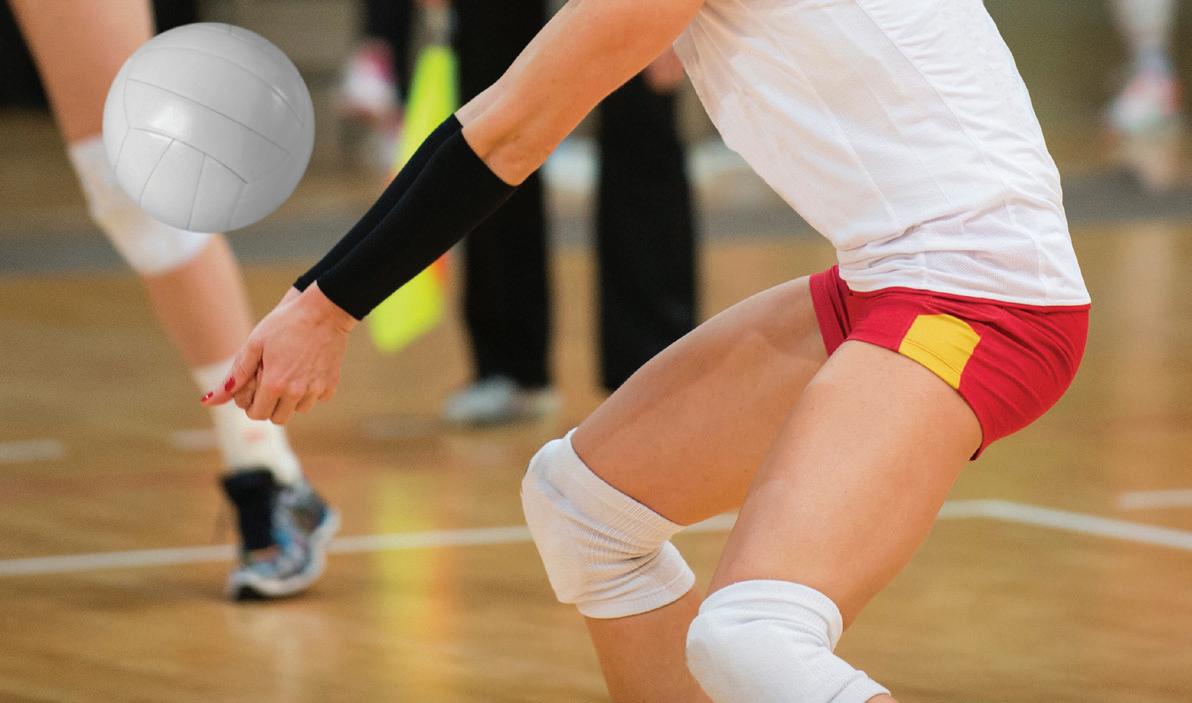
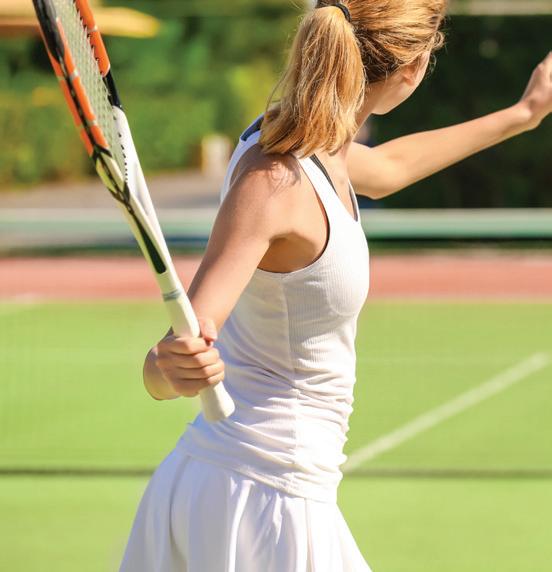
SAFER SPORTS
KEEPING ATHLETES SAFE FROM ABUSE IS THE AIM OF THE U.S. CENTER FOR SAFESPORT —
AND OFFICIALS PLAY A ROLE.
By Rick Woelfel
When the U.S. Center for SafeSport was created nearly seven years ago, it was charged with the responsibility of protecting minor athletes from physical, emotional and sexual abuse at the hands of coaches, administrators and others who are part of America’s amateur sports programs.
That mission includes training officials, coaches, parents and others to be alert to signs of possible abuse.
The Center oversees 52 Olympic/Paralympic sports. But its role extends far beyond the Olympic level.
Officials who work USA Volleyball matches, on-ice officials registered with USA Hockey and officials certified by U.S. Soccer, among others, are required to complete an online SafeSport
training course and to report any incidents of abuse they observe, whether on or off the field, court or ice.
A non-profit organization based in Denver, SafeSport was established via the Protecting Young Victims from Sexual Abuse and Safe Sport Authorization Act of 2017 , which was passed by Congress in March of that year. The organization investigates allegations of abuse by those who have regular contact with minor athletes who compete in sports that are part of the Olympic/Paralympic movement, and when necessary, imposes sanctions against individuals alleged to have engaged in such actions, including suspension and banishment.
The organization also maintains the U.S. Center for SafeSport’s Centralized Disciplinary Database, which is accessible to the public online and lists individuals who have been the subject of
disciplinary action.
Hilary Nemchik , SafeSport’s senior director for communications and media relations, said in the years before the center was founded, there were a number of high-profile cases involving allegations of athletes being abused. Most notable were those involving Dr. Larry Nassar, a former doctor with USA Gymnastics and Michigan State University who is now in federal prison for the sexual assault of minors and child pornography charges.
“The U.S. Center for SafeSport was born out of a need for reform, a need for accountability and a need for an independent authority to put athlete well-being above medals and money and other considerations,” Nemchik said. According to Nemchik, 11 million individuals are covered under SafeSport’s umbrella.
48 | REFEREE May 2024



SPORTS
“National governing bodies and Paralympic sports organizations must offer and give consistent training related to the prevention of child abuse to all adult members who are in regular contact with amateur athletes who are minors,” Nemchik said, “and subject to parental consent, to members who are minors.
“Additionally, adult participants with authority over any amateur athlete who is a minor must also complete training,” she said.
National governing bodies may determine who among their ranks must undergo training , but the trainees must include staff and board members, coaches, officials and others who may hold unique sport-specific roles within their organizations.
In 2022, the U.S. Center for SafeSport received more than 5,000 reports of abuse. As of late September 2023, the center’s disciplinary database included approximately 2,000 names.
Officials, along with coaches and other individuals who have regular contact with minors, are required to undergo training in regard to SafeSport policies and procedures.
They must complete an initial series of three 30-minute training modules that focus on sexual misconduct awareness, emotional and physical

misconduct and mandatory reporting, and must complete a refresher course each year thereafter. Every four years, they repeat the initial series of three modules.
Contest officials who are officiating under the auspices of a national governing body are considered mandatory reporters and required by law to immediately report any suspected cases of abuse they observe to the U.S. SafeSport Center — as well as law enforcement — within 24 hours of the incident.
Reporting can be done around the clock by phone or via SafeSport’s online reporting form.
Lisa Campi-Sapery has been refereeing fencing for more than 35 years and is certified by the International Fencing Federation (FIE) in all three of the sport’s weapons (saber, epee and foil). She is also a fencing instructor and a high school coach.
While some would contend noting possible cases of abuse is not part of an official’s job description, Campi-Sapery offered a unique take.
“I’m there to keep
everybody safe,” she said. “That’s one of my jobs as a referee — to make sure that the people who are in front of me are safe.”
Campi-Sapery said when she’s working a tournament she’s there to officiate. But she is expected to note inappropriate behavior.
“We’re not necessarily walking around policing a tournament,” she said. But she added officials need to be aware.
“I saw a coach grab an athlete by the arm and yank them off the fencing strip ,” she said. “That’s not OK. I have to write down who the athlete was, I have to write down who the coach is if I can find out the coach’s name. If you’re at a giant tournament, you have no idea what the coach’s name is.
“I’m not policing an area to look for this, but if it happens where I’m refereeing, then I have to say something.”
Campi-Sapery’s reporting responsibilities extend beyond coach-athlete interactions.
REFEREE May 2024 | 49
“If I see a parent yank their fencer off the strip, I’m just as likely to report that as I am a coach doing that,” she said, “because guess what? That’s still not OK.”
For officials who work multiple levels of a particular sport or sports, the question of whether they are subject to SafeSport protocols may come down to who gave them a particular assignment.
Attorney and sports law expert Alan Goldberger said more often than not, SafeSport protocols don’t apply to officials working high school and collegiate contests.
“They don’t really have an obligation regarding (SafeSport),” he said, “unless they are working in venues where they’re engaged by one of these (national) sports organizations to referee whatever the sport is and they’re subject to that sport’s rules and procedures. SafeSport would be involved if there was interstate competition.
“If you’re working for one of those governing bodies or a governing body’s affiliates or one of the regional associations or even a local association that sponsors a sport, if they travel, SafeSport would apply.”
Goldberger points out a mandatory reporter’s responsibilities extend beyond the field or court, and even beyond the competitive venue. He cites a circumstance in which an official has traveled a distance to work a tournament and might find themselves staying at the same hotel as one of the participating teams.
“If you have a reasonable suspicion that something unlawful is going on — certainly unlawful contact with a minor — you need to report that,” he said.
Longtime volleyball official , NCAA women’s volleyball secretary-rules
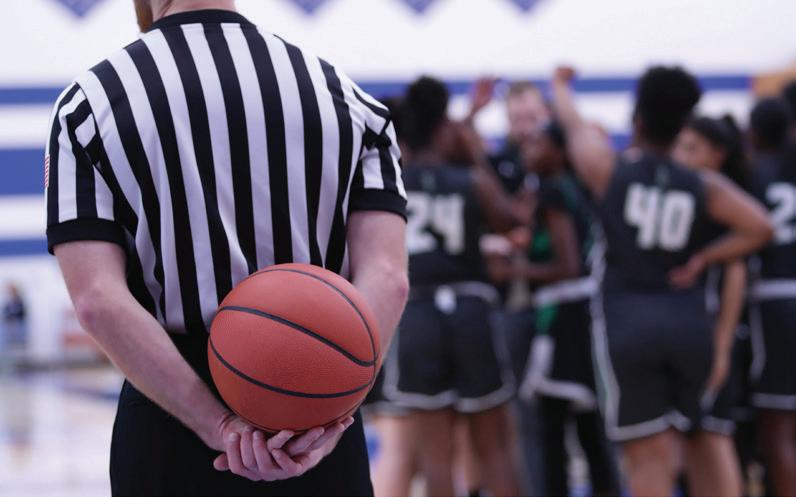
“IF OFFICIALS OBSERVE SOMETHING, THEY NOW HAVE INFORMATION ON WHAT TO DO ABOUT IT — WHICH THEY DIDN’T NECESSARILY HAVE BEFORE.”
–JULIE VOECK
editor and chair of the USA Volleyball Rule Commission
Julie Voeck, who has worked at the highest levels of the sport, including international matches, said SafeSport protocols have little to no impact on how she conducts herself on the court.
“It hasn’t changed how I officiate or how I conduct myself at USA Volleyball events at all when I’m in the capacity of a referee,” she said. “I’ve also been (at tournaments) in the capacity of a head referee or maybe an arbitrator and these issues come to you when an official reports them. But as an official, I really don’t see it changing anything I do already.”
Voeck said officials now have a place to turn if they observe behavior they deem to be inappropriate.
“If officials observe something , they now have information on what to do about it — which they didn’t necessarily have before,” she said. “From my perspective, (officials) are not the primary audience for SafeSport. It’s more the coaches’ community, but we’re in a position to observe how athletes and
coaches work together. ”
SafeSport’s impact is not limited to the Olympic movement. Any sports organization that operate s across state lines or takes part in international competition is under the auspices of SafeSport.
SafeSport training is mandatory for those involved in Little League Baseball, including volunteer umpires.
Pop Warner Football mandates one individual from each local organization must complete SafeSport training, although that person need not be a game official.
Some officials might wonder if reporting an incident of possible abuse might increase their own liability exposure, or if they might be targeted in retaliation for reporting an incident.
However, the legislation that created the U.S. Center for SafeSport includes language that indemnifies individuals who make a report in good faith, regardless of whether the incident in question is determined to be an actual instance of abuse.
Campi-Sapery said in the days before SafeSport, she might have lost officiating assignments in retaliation for reporting an abuser. But she says that’s no longer the case.
“Our culture is changing to be more inclusive from the top down,” she said. “I’m not worried that if I report somebody that something bad is going to happen to me and I won’t get refereeing assignments. That used to happen as little as 10-15 years ago. Now, that doesn’t happen. But it’s a culture shift that has to start from the top, and it’s a culture shift that has to start with behavior that’s acceptable.” Rick Woelfel, Philadelphia, is a former softball umpire.
50 | REFEREE May 2024
SAFER SPORTS
GREAT TRAINING RIGHT OUT OF THE BOX



• Pre-Built Meeting Lesson Plans
• Industry-leading Mechanics Illustrated Manuals
• Online & Traditional Testing For Every Lesson
• Updated Mechanics With the New NFHS Officials Manual


• Step-by-Step Instructor Guides
• Video Breakdowns With Voice-Over & Graphic Enhancements
Your entire association training program all in one box
STORE.
SPECIAL PRICE
AVAILABLE FOR
$ 750
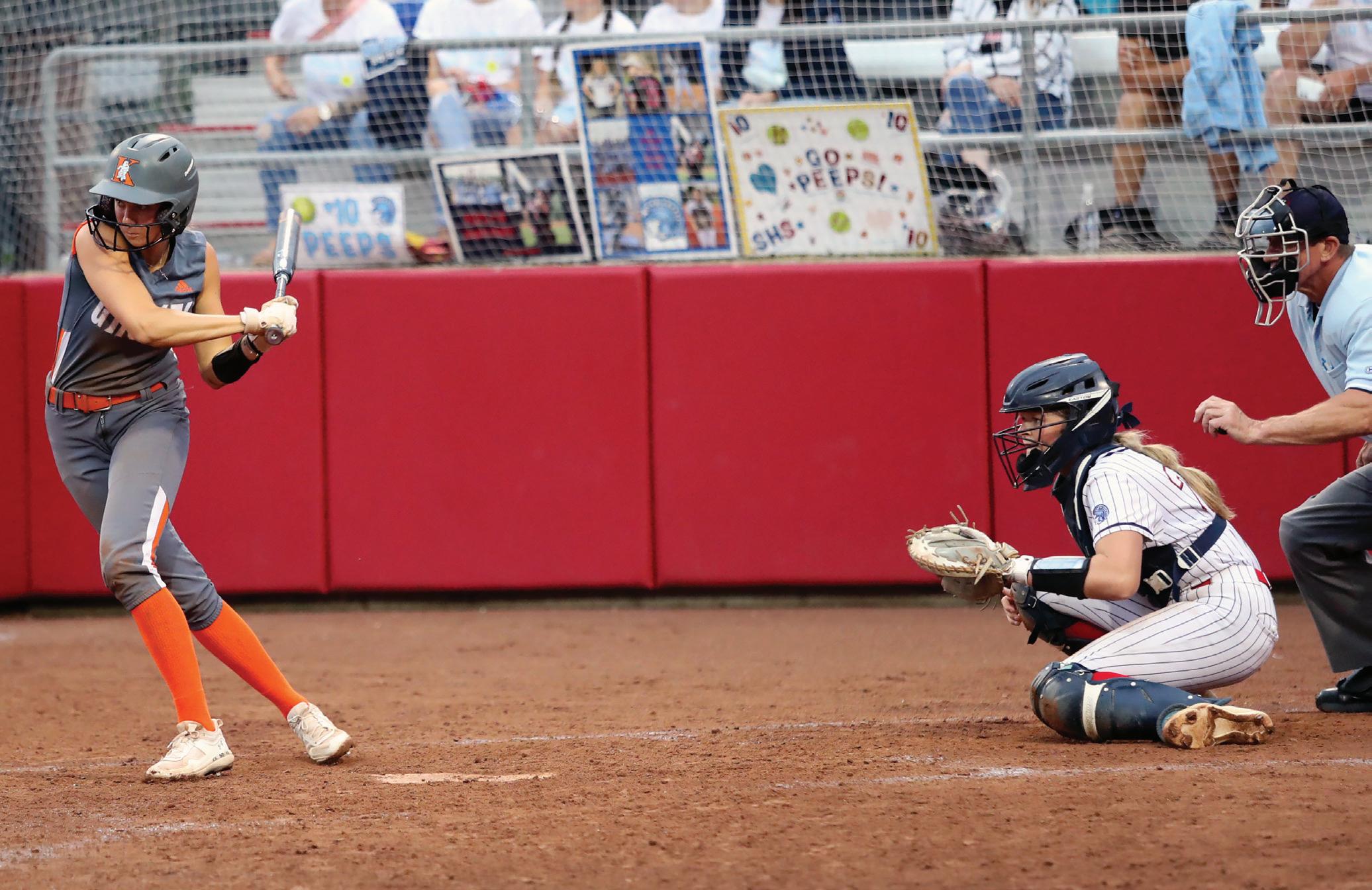
OUTSIDE THE BOX
An Inside Look at Illegally Batted Balls
By Brad Tittrington
The job of a plate umpire is incredibly difficult. Trying to judge more than 200 pitches in a seven-inning game can be both mentally and physically exhausting. As pitchers get bigger, faster and stronger, trying to decipher whether or not a ball in excess of 70 miles per hour nicks the strike zone can be taxing. But on top of judging pitches, plate umpires are also responsible for determining the legality of batted balls. Trying to do two things at once can be extremely challenging and it is what separates the good umpires
from the great ones.
There are multiple times in a game when plate umpires must make rulings on batted balls and determine if they are legal. The two most common occurrences are on bunted balls and with slap hitters. Bunted balls are generally easier to decipher as batters are generally stationary while trying to bunt the ball — the exception being when a batter is trying to drag bunt. The more difficult scenario is trying to determine if a slap hitter is legally in the batter’s box upon contact with the ball as the batter is moving both forward in the box (toward the
pitcher) as well as moving toward the plate. Trying to watch the movement of the ball and get a glance at the feet, which are moving, is a skill that takes a while to master. Even the best umpires in the world struggle with this call.
So how do plate umpires get this call right? Well, first, it is important to know the rules regarding illegally batted balls and understand there are some differences between the codes. Let’s examine the rules as they pertain to the feet first and then examine the rules regarding the bat hitting the ball a second time.
When it comes to the feet, three
SOFTBALL RULES, MECHANICS, PHILOSOPHY 52 | REFEREE May 2024 EDITOR: BRAD TITTRINGTON btittrington@referee.com
VISUAL IMAGE PHOTOGRAPHY
Plate umpires must focus on the pitch and subsequently get their eyes to the batter’s feet as the ball is contacted in order to properly rule on illegally batted balls. Roger Van Lanen, Suamico, Wis., stays set and watches the ball from the pitcher’s hand all the way to the plate in order to get a good view to accurately rule on this play.
of the codes agree on the rules (NFHS, USA Softball and USSSA). NCAA softball is the outlier with a different set of guidelines. For NFHS, USA Softball and USSSA, in order for a batter to be ruled out for an illegally batted ball, either foot must be touching the ground completely outside the line of the batter’s box or be touching the plate (NFHS 7-48; USA Softball 7-6F and G; USSSA 7-14G and H). In NCAA, it is an illegally batted ball if any part of the body is touching home plate or the ground outside the line of the batter’s box at the moment of contact (11.15.1).
The penalties between the codes are also drastically different. In NFHS, USA Softball and USSSA, the ball is immediately dead, the batter is ruled out and runners must return to their bases occupied at the time of the pitch. In NCAA, it is a delayed dead ball. The defensive coach shall choose either the result of the play or the standard effect for illegal contact, which is a strike on the batter and all base runners must return to the base legally occupied at the time of the pitch. If it is the third strike, the batter is declared out.
Play 1: No outs, runners on
first and second and a 2-2 count. B3 squares to bunt and contacts the ball while the heel of the foot is still in contact with the batter’s box but the toes are touching the plate (as shown in PlayPic A). The ball is bunted to F5, who throws to F4 at second base, beating the slide of R1. F4 throws to F3 at first base, beating the batter-runner. Ruling 1: In NFHS, USA Softball and USSSA, the ball is immediately dead upon contact as the batter was in contact with the plate at the moment of contact. The batter is ruled out and R1 and R2 are returned to first and second base, respectively. In NCAA, it is a delayed dead ball. The defensive coach can take the result of the play — a double play, and continue the inning with a runner on third base and two outs — or can elect to nullify the play, return the runners to first and second base and add a strike to B3’s count, resulting in B3’s out.
Play 2: With the bases loaded, two outs and a 2-2 count on the batter, the pitcher throws a pitch low and away. The batter, a slap hitter, runs up and reaches out to make contact with the ball. At the moment of contact, the batter’s left heel is still in contact with the batter’s box, but part of her
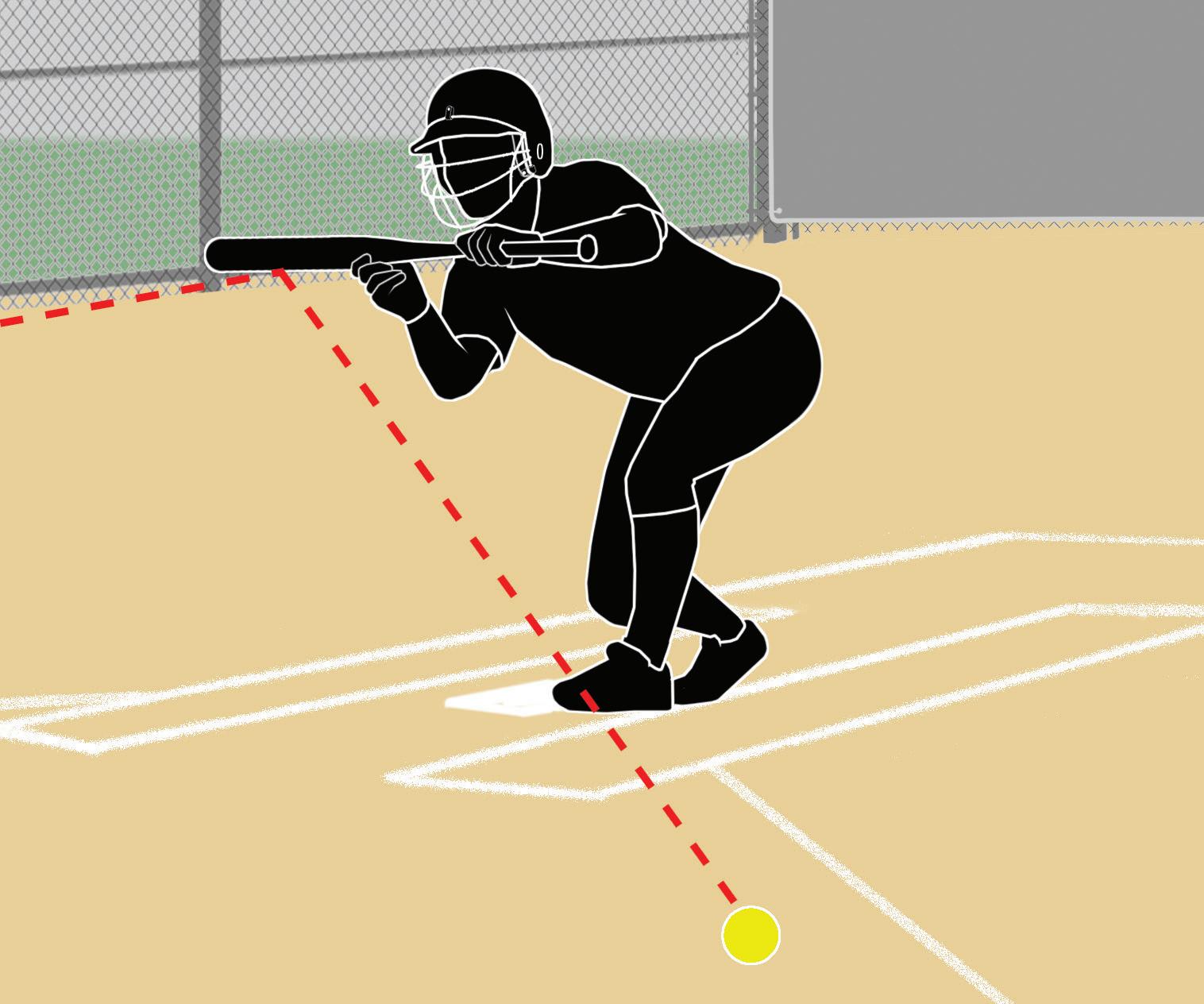
DID YOU KNOW?
The NFHS moved the pitching distance for high school varsity softball from 40 feet to 43 feet starting with the 2010-11 season. The rule change came about after nearly a decade of debate by the softball rules committee and after two states (Florida and Oregon) experimented with the rule and provided positive feedback. The reasoning for the change was to create a better balance between offense and defense and have more balls put into play. The NCAA implemented the rule in 1988.
QUICKTIP
Your job is not to be an equipment manager. The best advice is to leave bats alone. If you toss or kick a bat, you are now liable if it hits a player. Also, if you are handing a bat to a coach or player, there is the potential for another interaction where something may be said that you could have avoided by simply moving to your between-innings position. Let players and coaches handle bats, even if a bat is near the plate and a play is imminent there.
TOOLS
Hothands Insole Foot Warmers
Do you work in a cold climate and struggle to keep your feet warm? If so, Hothands Insole Foot Warmers are the perfect tool to help you get through those cold games. When your feet are cold, it can be hard to concentrate and move, leaving you susceptible to injury. Use these to provide a fast and portable heat source for your feet and toes. The warmers last up to nine hours and are air-activated and come in a package of two for $2.68.
Find these on Amazon, at your nearest retail store or online from your favorite officiating apparel retailer.
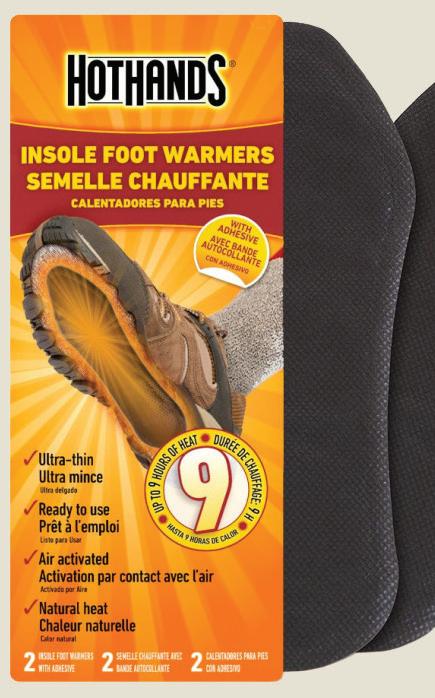

REFEREE May 2024 | 53
A
TEST YOURSELF
Each of the following includes a situation and possible answer(s). Decide which are correct for USA, NFHS, NCAA or USSSA rules and which might vary. Solutions: p. 81
1. With the bases loaded and two outs, B6 hits a home run. The defensive coach notifies the plate umpire the bat used by B6 is a non-approved bat. The home plate umpire checks the bat and notices there are no certification marks and agrees it is a non-approved bat.
a. Home run counts.
b. No runs score, B6 is declared out and the half-inning is over.
c. Offensive head coach is warned.
d. B6 is ejected.
e. Offensive head coach is ejected.
2. In the fourth inning, F4 and F6 change positions. The defensive coach does not notify the plate umpire. The next batter, B1, hits a ground ball to F4, who throws to F3 for the force out. The offensive coach notifies the plate umpire the defensive change was unreported before another pitch is thrown.
a. Play stands.
b. That is an unreported substitute. F4 and F6 are now officially in the game at their new positions.
c. The offensive coach has the option of taking the result of the play or returning B1 to bat and assuming the count she had before the groundout.
d. A team warning is issued to the defensive team.
e. F4 and F6 are ejected.
3. With an 0-2 count, B1 bunts down the first-base line. While running, B1 discards her bat into foul territory. The bat hits the ball that came to rest in foul territory before being touched by any players.
a. B1 is out for interference.
b. Foul ball. B1 remains at bat with an 0-2 count.
c. B1 is ruled out for bunting a third strike foul.
4. F1 doesn’t like the ball that is left from the previous half-inning and requests the plate umpire give her another ball for comparison.
a. The plate umpire should allow the pitcher to compare balls.
b. The plate umpire should request F1 to throw the ball in and then throw her another ball to use.
c. F1 must use the ball that was used in the previous half-inning.
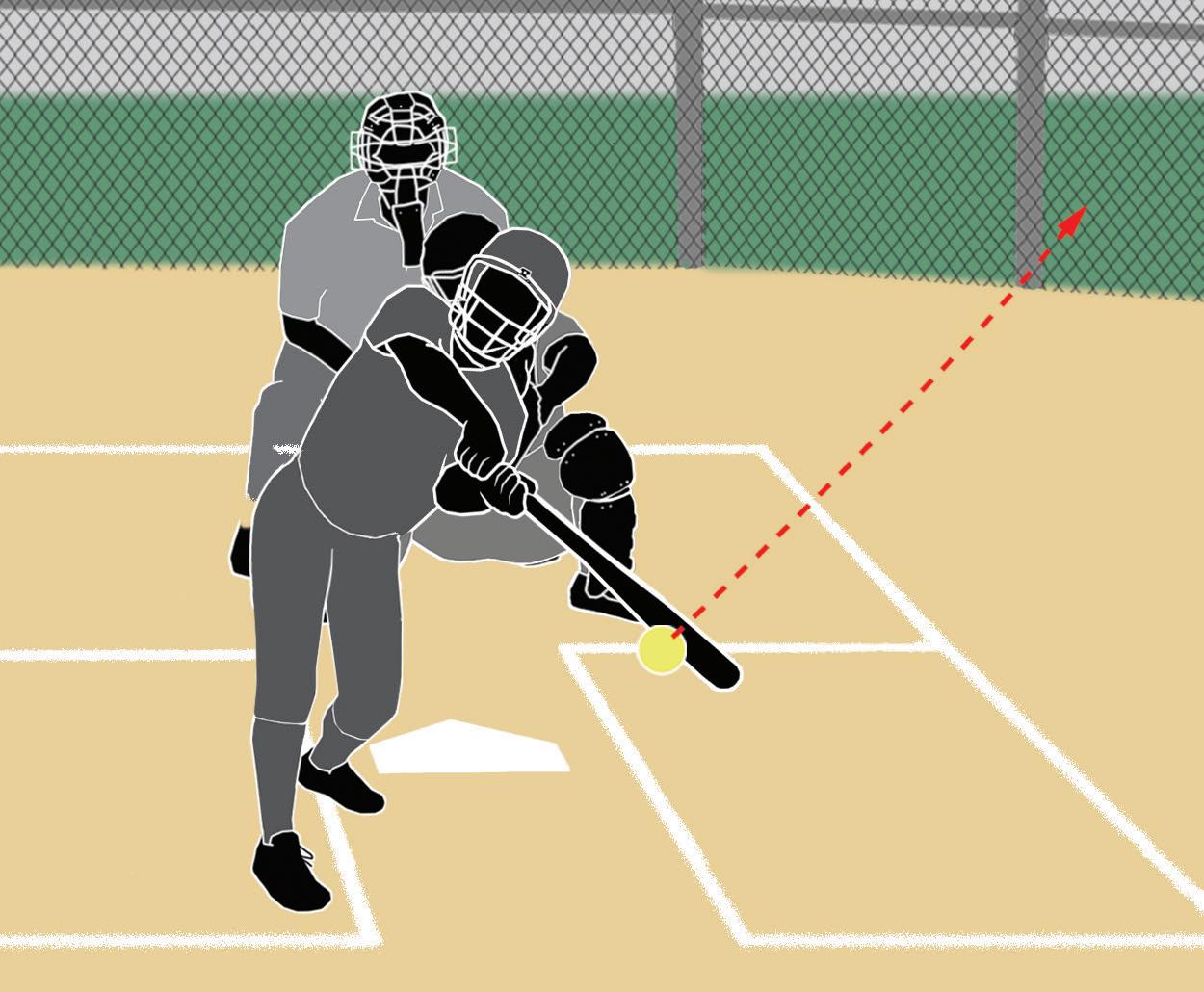
foot is out in front of the plate (as shown in PlayPic B). The batter hits the ball to left field and all runners advance safely one base. Ruling 2: In NFHS, USA Softball and USSSA, this is a legal play. The batter was not in contact with the plate at contact and a portion of the foot was still in contact with the batter’s box at the moment of contact. All play stands. In NCAA, this is an illegally batted ball as part of the foot is touching the ground outside the batter’s box at the moment of contact. It is a delayed dead ball. The defensive coach has the option of taking the result of the play or taking a strike on the batter, which would result in the third out. Since the result of the play was a base hit and a run scored, the coach is obviously going to take the out on the batter and nullify the run, ending the inning.
In all of these situations, umpires should let the play develop, digest everything they see and then make a ruling. Especially in NFHS, USA Softball and USSSA, umpires should not be in a hurry as they may accidentally kill the play and then realize the ball should have remained live. In NCAA, since it is a delayed dead ball, umpires should take their
time before giving any signal to make sure they are adjudicating the play properly, not accidentally killing the play and taking away the defense’s ability to get additional outs.
The other illegally batted ball scenario involves the batter hitting or bunting the ball and then the bat hitting the ball a second time. All four codes agree if the ball makes contact with the bat a second time and the bat is still in the batter’s hands (and the batter is still in contact with the batter’s box), it is a foul ball, regardless of whether the ball was on or over fair or foul territory. The only time it would result in an out would be if the umpire deemed the second contact by the batter was intentional. The one rule caveat to understand is in NCAA, a player may not have any portion of the body outside of the batter’s box when initially contacting the ball, but in determining whether contact with a batted or bunted ball a second time is illegal, the entire foot or body part must be completely outside the batter’s box to be illegal.
If the batter bunts or hits the ball and then releases the bat and there is subsequent contact with the ball
SOFTBALL 54 | REFEREE May 2024
B
by the bat, there are some factors the plate umpire needs to determine. The first thing to rule on is whether the bat hit the ball or the ball hit the bat. The rule of thumb is if the bat is stationary on the ground and the ball rolls into the bat, this is not an illegally batted ball and play continues. The bat in this instance becomes part of the ground. If it is over foul territory and the ball never becomes fair, it is simply a foul ball. If the bat is over fair territory and the ball remains fair, it is a fair ball. If the ball hits the bat over fair territory and the ball is first touched over foul territory, it is a foul ball.
The other scenario is the bat is still moving when it hits the ball. In this situation, it may or may not be an illegally batted ball. It all depends on where the contact occurs. If it is over foul territory and the umpire judges the ball never had a chance to become fair, it is simply a foul ball. If the contact occurs over fair territory, or over foul territory and the umpire judged it had a chance to become fair, the batter would be out and runners returned to their bases at the time of the pitch. The exception is in NCAA, if the bat hits the ball over foul territory, and it wasn’t intentional, it is always a foul ball, regardless if the ball had a chance to become fair.
The most important thing for umpires in these situations is to clearly see what happened, allow the play to develop, know the rule and then make the ruling. Never guess on these types of plays. Remember, the batter is legal until you see something is illegal. Never guess or assume the batter is out of the box unless you clearly see it. The speed of the game doesn’t always allow us to see everything and we don’t get the benefit of replay, except at some levels of college. We get one instance in real time to try to decipher everything. Be 100% certain when you do call it.
Brad Tittrington is an associate editor for Referee. He umpires D-I softball and officiates women’s college and high school basketball, college and high school volleyball and high school football.
The Time Between
T here has been a lot of talk over the past several years about the length of softball games. While some things that cause games to go long — lack of quality pitching, poor defense, etc. — are out of the control of umpires, there is one thing umpires can do in order to ensure the proper flow of the game. That one thing is enforcing the rules dealing with the time between pitches.
Umpires are sometimes hesitant to enforce the pitching rules, either due to a lack of confidence or just simply an unwillingness to call penalties when a timing violation occurs. Just like other rules in the book, umpires do not and should not have the luxury to pick and choose which rules to enforce on any given day. The timing violations are crystal clear in all codes and umpires should uphold and enforce these rules consistently.
In order to help umpires enforce these rules, codes have either changed the rules, the mechanics of calling these violations, created POEs or allowed schools to put a visible clock on the scoreboard or in other locations around the field to help keep games moving (NCAA).
First, let’s take a look at the rules when it comes to timing violations. With an NCAA rule change in 2024, all four codes now have the exact same timing restrictions. All four codes state the pitcher has 20 seconds to deliver a pitch after receiving the ball from the catcher or after the umpire calls, “Play.” Failure to do so results in a ball being awarded to the batter (NFHS 6-4-8; NCAA 10.18; USA Softball 6A-3O; USSSA 6-1K). The batter is also responsible for being in the batter’s box within 10 seconds of the pitcher receiving the ball or after the plate umpire calls, “Play.” Failure to do so results in a strike being called on the batter (NFHS 7-3-1; NCAA 11.2.1; USA Softball 7-3C; USSSA 7-8). NCAA rules also state the catcher must be in position within
the catcher’s box within 10 seconds or a ball is awarded to the batter (10.18, 11.2.1).
In NFHS, USA Softball and USSSA, the plate umpire has sole responsibility for keeping track of the time, keeping a count inside his or her head. It is important for the plate umpire to keep a count and be consistent on every pitch to make sure a team is not gaining any advantage.
In NCAA, jurisdiction of this rule depends on whether there are visible clocks within the field of play or if the umpires are keeping the time on the field. If there is no visible action clock, the responsibility will fall on the third-base umpire (U3) in the three-umpire system and the base umpire in the two-umpire system. That umpire should be equipped with an electronic timing device that can quickly be reset between innings and allows for vibration at both 10 seconds and 20 seconds. That umpire will then be responsible for indicating and communicating any timing violations committed by the pitcher or batter.
If there is a visible action clock behind the home run fence only, the responsibility will fall on the plate umpire to communicate and indicate any infractions as the base umpire(s) would not be able to see the clock. If there is a visible action clock located behind home plate, U3 or the base umpire in the twoumpire system would have the responsibility to indicate timing violations as the clock would not be in the plate umpire’s visual confines. Lastly, if there are multiple visible clocks both beyond the home run fence and behind the plate, U3 or the base umpire in the two-umpire system would again be responsible for indicating violations.
There are some scenarios and additional rules in some codes umpires need to be aware of to properly enforce this rule. In NCAA, when the action clock gets to five
REFEREE May 2024 | 55
SOFTBALL
CASEPLAYS
Ball Hits Bat on Ground
Play: B1 hits the ball down off the plate. B1 then drops the bat in fair territory in front of the plate, where it comes to rest and the batter had no intent to intentionally hit the ball a second time. The ball then falls to the ground, hits the bat and (a) rolls into foul territory where it is touched by F2, or (b) stays in fair territory where it is first touched by F1. Ruling: In all codes, it is a foul ball in (a) and a fair ball that remains live in (b). Once the bat is discarded and is laying motionless on the field, it is considered to be part of the field. In (a), since it is first touched in foul territory, it is simply a foul ball. In (b), since the ball remains in fair territory and is first touched in fair territory, it is a fair ball that remains live (NFHS 1-8-3, 7.4.13; NCAA 11.12 Eff.; USA Softball 7-6M Exc. 2; USSSA 7-14F Note, Feb. 2018 Interp.).
Obstruction or Interference?
Play: With R2 on second base, B2 hits a grounder between short and third base. F5 cuts in front of F6, fields the ball and throws it to first. The ball ends up shorthopping F3, allowing B2 to arrive at first safely. F3 fields the ball, but she is not on the bag when she secures possession. As R2 was running to third base on the batted ball, she bumps into F6, who was also trying to make a play on the ball. Both R2 and F6 fall to the ground. Ruling: In all codes, only one fielder may be protected in this case. The umpires should protect the fielder who has the best chance to make a play on the ball. Since F5 was closest to the ball and made the play, she is the fielder who should be protected. In this instance, since F6 is not protected, her contact with R2 would be ruled as obstruction, resulting in a delayed dead ball. The umpires must then determine which base R2 would have safely reached had the obstruction not occurred. In this instance, third base is most likely the base R2 would have attained since the ball remained on the infield. Assuming she got to third safely, there is no need to enforce any penalties. If she and was put out between second and third, it is a dead ball once she is put out and she would be awarded third (NFHS 8-4-3b, 8-8-3; NCAA 9.5.1.1, 12.17.2.1.5.4; USA Softball 8-5b, 8-8C; USSSA 8-13, 8-18I Note 4).
seconds left, neither the pitcher, catcher or batter may request time to avoid a violation. Umpires may still grant time to anyone if there is a specific reason to grant time other than to avoid a violation (2024 interp.). In the other three codes, umpires always have the discretion whether or notto grant time when it is requested. Remember, it is a privilege to get time, not a right.
Batters also must stay in the box and can’t simply leave the box while the count is going. If a batter leaves the box while the pitcher is in the pitching position and time is not granted by the umpire, the penalty depends on which code you are working. In NFHS play, if the pitch is delivered, it is ruled a strike, no matter the location (7-3-2 Eff. 2). In the other three codes, the pitch is declared a ball or strike, depending on the location (NCAA 11.2.2 Eff.;
USA Softball 7-3F Eff.2; USSSA 7-4B Eff.). In all codes, if the batter backs out of the box or holds up a hand to request time and this action causes the pitcher to stop or hesitate, “No pitch” is declared as both the pitcher and batter have now violated and the count begins anew.
The most important thing for umpires in dealing with the time between pitches is to know the rules for the particular code they are working. It is important to be consistent in enforcing the rule from the first pitch to the last pitch of the game. The timing should not change based on the inning or score. Teams should adjust to the rule and if violations are being called either against the pitcher or batter for taking too long, coaches will push them to move faster. It is the teams’ jobs to adjust to the rule, not the umpires’ jobs to adjust to the teams.

20 Seconds
All four codes now agree pitchers have 20 seconds to deliver the next pitch after receiving the ball from the catcher or after the plate umpire calls, “Play.” It is important for umpires to be consistent in enforcing this rule to keep games flowing and not allowing a team an unfair advantage.

56 | REFEREE May 2024
THE NEW SOFTBALL UMPIRES MANUAL











The official NFHS softball umpires manual produced by the editors of Referee! Loaded with dozens of mechanics scenarios and featuring Referee’s exclusive PlayPic® and MechaniGram® graphics, this new resource is a must have for high school softball umpires. Mechanics are broken down into one, two, and three-umpire systems as well as providing detailed coverage for all situations.
YOU’VE NEVER SEEN AN UMPIRES MANUAL LIKE THIS ONE! Print
MORE
MORE
MORE
• • •
PAGES
MECHANICS
INSTRUCTION
- $21.95 // Digital - $20.95 // Combo - $25.95 GET YOURS TODAY! STORE. /SOFTBALL 208 pages 5” x 8.25”
Don’t Bluff!
By Jay Rowan
It has been said, what you don’t know can’t hurt you. But, when it comes to umpiring or officiating of any sport, rules knowledge is very important. We can’t officiate a game without knowing the rules and hopefully having very good knowledge of the rules. So, if you don’t know the rules, it will definitely hurt your performance in a game.
For example, if you think the entire ball must pass over the plate for it to be a strike, you would be wrong. Any part of the ball passing over the plate is a strike. If you are misapplying that rule, you are in for a long game.
If your understanding about a misplayed grounder is that you are still making an initial play on a ball that has gone more than a step and a reach from a player’s initial position at first contact, your knowledge of the rule is not correct. If a player misplays a ball and it is two or three steps away from her initial play and there is unintentional contact by a runner advancing to the next base, if the umpire rules interference by the runner, it is definitely wrong and obstruction should have been called. Not knowing the rule could result in a loss for the team that has been hurt by the ruling. What you don’t know can hurt you and more importantly affect the outcome of the game.
If a runner is standing on third base and gets hit with the ball, it is good if you know what happens next. If the third baseman is in front of the base, we have one thing, and if she is behind the base, we have another ruling. It is very important if we know the difference because there is a difference. If the third baseman is in front of the base when the runner is hit with the batted ball, while standing on the base, the ball remains live and in play. If the third baseman is behind the base when the runner is hit with the batted ball, while standing on the base, the ball becomes dead. Hopefully you know the difference.
It is very important to understand the appeal rules. If you don’t know

these rules, problems will arise. For example, what happens if we have the bases loaded and two outs in the last of the seventh inning in a tie game and the batter hits the ball over the fence, but the runner on second base misses third base and it is appealed correctly? I asked this play to five umpires and four got it wrong. Not good. They thought it was a timing play and would be the third out of the inning, but since the runner on third base scored before the appeal play the run would count and the home team would win the game by one run. This is an incorrect ruling because this appeal would be on a force out. If the third out of the inning is a force out, no runs can score. Again, this wrong ruling would result in a team winning who did not deserve to. If you knew the rule, it would not hurt you.
Know the ground rules and understand they can’t supersede book rules. If you go into a game with a left-field fence approximately 175 feet away, you can’t allow the home team to determine a ball hit over the leftfield fence is going to be a double and not a home run. Because a ball hit over the fence is a home run by book rule.
A ground rule cannot overrule a book rule. If you don’t know that, it could lead to the wrong team winning the game.
If you think an illegal pitch is an immediate dead ball, you will be taking a possible run-scoring play away from the offense. This is not a good thing and the offensive team will certainly let you know. Obviously, the offensive coach should have the option of taking the result of the play or taking the penalty for the illegal pitch. It is their choice, not yours.
Based on these examples, it is obvious knowing the rules will give you a major advantage when you take the field. It could also prevent a possible protest for misinterpreting the rules. Teams deserve umpires who know the rules, which will lead to better umpiring. Don’t be that umpire who thinks you can get through a game by bluffing your way through it. Get into the rulebook and become an expert on the rules. Otherwise, what you don’t know will hurt you.
Jay Rowan, Pittston, Pa., has officiated for 35-plus years in softball, football and basketball and serves as a state rules interpreter in all three sports.
SOFTBALL 58 | REFEREE May 2024 HESTON QUAN
Umpires must be aware of the ground rules before they start each game. They also must know ground rules may not supersede a book rule. From left, California umpires Gregory Myers, West Covina, and Tony Pech, Arcadia, allow the home team coach to explain the ground rules, but they know they may have to step in if something said by the coach contradicts the rulebook.
2024 rule change














Everything you need to know about the new rules regarding pitchers’ feet. This guide breaks down what is legal and illegal, and outlines everything you need to know to take the field in 2024. Illustrations with Referee’s exclusive MechaniGrams® make for easy comprehension. This handy guide can be kept in your gym bag for easy access.



*NASO Member & Bulk Discounts Available. $395 * DIGITAL $595 * PRINT $795 COMBO
WHAT YOU NEED PITCHERS’
what available NOW! STORE. /SOFTball 5.5”x8.5” 16 pages BULK DISCOUNTS AVAILABLE STARTING AT JUST 10 COPIES FOR ORDERS OF 300 OR MORE, CALL 1-800-733-6100 FOR DEEPER PRICE BREAKS!
FOOTWORK RULES
GETTING IT RIGHT
INSPIRATION, MOTIVATION, ELEVATION
MLB’s Military Mission
By Brad Tittrington
Making split-second decisions under pressure. Wearing a uniform properly. Taking orders. Following rules.
These are all characteristics of successful umpires. But these same traits also describe another group of people — the brave men and women in the military.
Back in 2008, now retired Marine Major Mike Gervasoni attended an MLB umpire camp to brush up on his umpiring skills. What he heard

Sailors
Aug. 25, 2023.
in the classroom sessions gave him an idea. What MLB was looking for in future umpires was the same thing the military was looking for in its members. That led to Gervasoni approaching MLB Director of Umpire Development Rich Rieker and discussing an idea to help military veterans get into umpiring.
“It is a great opportunity for servicemen and servicewomen to use what they are learning in the military and translating that back into where they go,” Gervasoni said. “The nice thing about officiating is you can go anywhere and use the skills you are learning in the service. Everything is about enforcing rules.”
Those initial conversations back in 2008 spurred MLB to offer oneday clinics to servicemembers, most
recently at Naval Station Norfolk (Va.) last August. These one-day camps give servicemembers the opportunity to learn umpiring in a stress-free environment among their peers.
“Usually people who show up to the one-day camps are umpires aspiring to be MLB umpires,” Gervasoni said. “Those are not the military guys and gals. (Those camps) would be uncomfortable because they haven’t thought about it. But some of them take to it like a fish to water.”
At the Norfolk camp, one service member was given a scholarship to attend the month-long Umpire Prospect Development Camp in Vero Beach, Fla., in January.
“When you leave the service, you aren’t sure you will ever find anything that has as much meaning as that,” Gervasoni said. “What’s the next team to belong to? This is it.”
Currently, the MLB umpire staff has three veterans — Laz Diaz, Mark Carlson and Nick Mahrley — and Shane Livensparger is a member of the Georgia Air National Guard.
“These young men and women come back looking for a job,” Rieker said. “Why not take someone who has to deal with the situations under pressure, wear a uniform, take orders … that’s an umpire.”
“The pressure they have been under overseas or at home mirrors a lot of what we do,” MLB Umpire Development Supervisor Tyler Funneman said. “We ask professional umpires to go on the road for six to eight or nine months out of the year. We want someone who is disciplined and can handle being on the road that long.”
“Officials are tough to find these days and this is a good population for all officials to look to,” Gervasoni said. “They make great officials because they already have that mindset.”
Brad Tittrington is an associate editor for Referee. He umpires D-I softball and officiates women’s college and high school basketball, college and high school volleyball and high school football.
Elmira’s Elite
Three longtime officials were honored at the Section IV Wrestling Championships at Visions Veterans Memorial Arena in Binghamton, N.Y., in February.
Emerson Baugher and brothers
Mike and Mark Stephens — all hailing from Elmira, N.Y. — each received the 2024 Heritage Award from Section IV for their contributions to wrestling.
In a nearly 40-year career, Baugher refereed 36 Section IV Championship Finals and 10 New York State Championships. He has also officiated college wrestling across the NCAA Division I, II and III levels.
Mike Stephens officiated wrestling for 34 years, working 20 New York State qualifiers and four New York State Championships. He also serves on the executive board for the Section IV Wrestling Officials Association.
The late Mark Stephens officiated local, regional and national wrestling matches for over 30 years, including high school, college, USA Freestyle and Greco-Roman state championships. He was inducted into the National Wrestling Hall of Fame in 2013.
SOURCE: WETM-TV
A Young-er Generation
Former MLB umpire Larry Young has done his part to fight the nationwide officiating shortage. Now an MLB umpiring supervisor, Young has traveled the world conducting umpiring clinics, but also emphasizes recruiting closer to home. The Asbury, Iowa, resident held a free clinic for umpires ages 10 and up in nearby Dubuque last October.
“I wanted to throw it out there and see if there would be interest in a clinic, and there does seem to be a lot of interest,” Young told the Telegraph Herald (Dubuque).
“It’s huge to have someone with Larry’s pedigree who is willing to help us develop our umpires,” said Dubuque official Al Stoltz, who co-hosted the clinic.
SOURCE: TELEGRAPH HERALD
Have you heard an inspirational or motivational officiating story?
Send your ideas to GettingItRight@referee.com
PHOTO COURTESY OF TYLER FUNNEMAN
assigned to Naval Station Norfolk participated in an MLB Umpire Training Camp in Norfolk, Va., on
60 | REFEREE May 2024

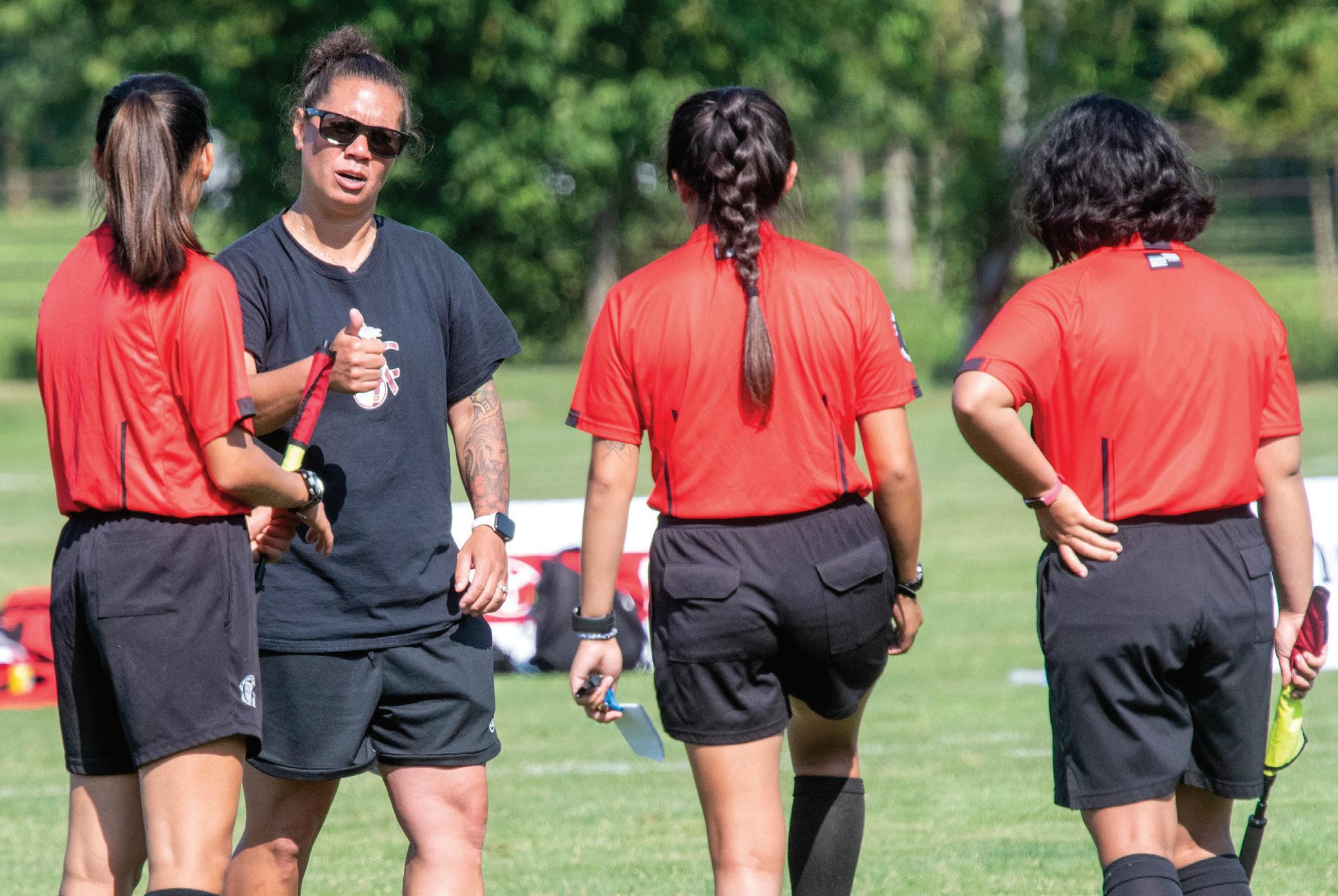
HEAR WE GO Communication That Connects With Today’s Coaches
By John Van de Vaarst
Officials who have worked soccer games for many years have, more than likely, recognized the relationship with coaches has changed over the past 10 years or more. In the past, the referee would just have to make a comment to the coach to adjust behavior and the game would progress normally. Phrases like “That is enough, coach,” “Settle down, coach,” or, “I heard you” would be sufficient. Some referees had the ability to use sarcasm to make a point with a quick “Coach,
start warming up your assistant, they are coming in soon.” This was a way to let the coach know they were about to be ejected if the behavior did not switch. Another way would be to respond to a comment by the coach in some manner that would create humor for others and “put the coach in their place.” Coach: “You are missing a good game!” Referee: “I can’t help it, this is the game I was assigned to. The good game is in the next town.” Reactions like this don’t work any longer in today’s society. Today many coaches, even at the youth level, are paid for
their services. Their career can be shortened by poor team performance (win-loss record) or the perception they cannot “get along” with referees. Their behavior becomes a detractor to the game. The referee must use strong people management skills when approaching a coach and responding or dealing with an emotional situation. The following are some tips on what to do when dealing with a coach.
Eye contact
The referee should make strong eye contact with the coach as soon
62 | REFEREE May 2024 COORDINATOR: JOHN VAN DE VAARST jvandevaarst@referee.com SOCCER RULES, MECHANICS, PHILOSOPHY
DALE GARVEY
Having the entire crew listen to a concerned coach can lead to clearer understanding since everyone is receiving the same message. Ingrid Van, Woodinville, Wash.; Sofia Trujillo, Woodinville, Wash.; Kaitlyn King, Seatac, Wash.
as they are close. Never look over the coach’s head at the fans to give an impression the referee is speaking to them and attempting to ignore the coach or show the coach is not important. Eye contact must be maintained throughout the conversation.
Voice inflection
The referee must keep a normal tone even if the coach has raised their voice to a level for the fans or players to hear. This may be an attempt at gamesmanship to get the fans into the game or motivate the team. It could also be pure frustration about how the game is progressing. Do not get into a shouting match with the coach. Referees must keep their emotions in check and remain calm. Then respond in a normal tone and attempt to defuse the situation.
Be professional
No matter how heated the coach attempts to make the conversation, the referee must always remain professional. The referee should never threaten the coach or make comments they might regret. Anything said by the referee might be reported to the league or administrator. This could lead to unwanted discipline, especially at the interscholastic and intercollegiate levels where the coach is being paid. Coaches need to be respected and the referee must remain professional.
Gesturing
Sometimes gestures are needed to explain a decision or a specific action. However, the referee should not use exaggerated gestures to make a point or try and engage the fans or bench personnel. This will only escalate the decision and definitely not help defusing it.
Brevity
The less said is often the better approach. A high-level official once said instead of debating, get the ball back into play. When the ball is moving the players and coaches become engaged in the game and dissent tends to dissipate. The referee should make their point clearly
with only the facts and not personal opinions while attempting to end the conversation as quickly as possible. A referee will never win a debate with the coach. One way of ending the conversation is merely saying, “Coach, I hear you and you have made your point. We may have to agree to disagree; now let’s move on with the game.”
Listening
Active listening is important while the coach is speaking. Pay attention and do not focus on what your response will be. Truly hear what the coach has to say. A head nod, non-sarcastic smile or some other means will let the coach know you are listening and demonstrates you are empathetic and respecting their comments. Never interrupt. Let the coach have “a day in court” and then respond accordingly.
Acknowledgement
When appropriate, acknowledge the coach’s point of view vocally. “I understand what you are saying and you saw the play differently than I did.” This clearly indicates to the coach you are listening and understanding what they are trying to say and their rationale for thinking the way they do. This could also be a good time to explain the rationale for the decision or why the decision was made, especially if it involves a caution or ejection.
Personal space
Every person has their own definition of personal space. Never enter the coach’s personal space and “get in their face.” This will only escalate the situation and create more problems. The coach could have a quick reaction and push the referee. That creates a much larger problem and unfortunately it was created by the referee entering the coach’s personal space. This goes both ways. The coach should not enter the referee’s personal space, either. If the coach is getting too close, take a step or two back to ensure there is always sufficient space between the two individuals.
BY THE NUMBERS
3,890 FIFA International Match Officials in 2024
496
Newly named to FIFA list in 2024
7
Number who have been on the FIFA list the longest (FIFA officials since 2002)
QUICKTIP
Be prepared. If your next match isn’t for a few days, keep your gear clean, organized and packed. You never know when a last-minute assignment might present itself. Being ready and able to sub in and look sharp doing it shows assigners you’re reliable and could lead to more opportunities or advancement.
SURVEY SAYS …
According to the 2023 NASO National Officiating Survey powered by Referee.com, the percentage of soccer officials who feel gender has been used against them when receiving match assignments:
51.51% of female officials
31.25% of other officials
13.30% of male officials
REFEREE May 2024 | 63
NATIONAL OFFICIATING
TEST YOURSELF
In each of the following, decide which answer or answers are correct for NFHS, NCAA or IFAB rules/Laws. Solutions: p. 81.
1. A1 has the ball and attempts to play it over B2 toward A3 who is in an offside position. B2 raises a hand to help the assistant referee make the offside decision. The ball hits B2 in the hand.
a. Indirect free kick for team B for offside.
b. Direct free kick for team A for hand ball offense.
c. Direct free kick for team B and caution B2.
2. Goalkeeper B1 catches the ball inside the penalty area and punts it out. The ball strikes A2 in the back and goes directly to A3, who is in an offside position. A3 scores a goal.
a. Allow the goal.
b. No goal and caution A3. Restart with an indirect free kick.
c. No goal and restart with an indirect free kick for offside.
3. B1 is cautioned prior to the match for making comments to the officiating crew. During the match B1 makes a reckless tackle and is cautioned.
a. B1 is to be sent off for the second caution.
b. B1 remains in the match since the first caution was before the match started.
c. The referee does not issue a caution for the tackle so B1 can remain in the match.
4. B1 commits a challenge within their own penalty area that denies an attacker an obvious goal-scoring opportunity (DOGSO) while attempting to play the ball.
a. Caution and penalty kick.
b. Caution for DOGSO and second caution for foul. Send off B1.
c. Eject B1 for the challenge since this was the more serious offense.
Don’t gang up
Always try to keep the conversation one-on-one. By using people management skills keep other coaches or bench personnel out of the conversation. Do whatever is possible to isolate the coach. The assistant referee or fourth official can help by stepping in and asking the others to move away while the referee is talking with the coach. It is just as important for the referee team to not gang up on the coach. The assistant referee and fourth official should keep their distance and focus on the players on the field and bench personnel to ensure nothing happens while the conversation is occurring.
Closure
The conversation must come to an end point. It cannot be left open leaving an opportunity for the coach to continue with the comments as the game progresses. Approach the coach, allow them to speak, listen carefully, respond in a professional manner and bring the conversation to a close. “Thank you, coach. I will keep an eye out in case that happens again.” “I understand your frustration, but it is time to move on
with the game.” “You have clearly made your point and I appreciate your professional attitude; now let’s move on.” Normally, this will end the discussion. However, it may be necessary to end the conversation by issuing the coach a caution when they cross the line of professional behavior.
Return to the field
It is a good approach to backpedal for a few steps when leaving the coach. This shows the referee is not turning their back on the coach and ignoring them. It also provides an opportunity for the referee to maintain eye contact and let the coach know they have listened and now it is time to resume play.
The referee should never view the coach as an adversary. Coaches are part of the game and need to be respected. Good people management skills will go a long way in keeping the relationship between the coach and the referee professional.
John Van de Vaarst, Ellicott City, Md., is a NISOA National Clinician, National Assessor and former State Level USSF Referee and Assessor. He is Referee’s soccer coordinator.
Forged By Failure
By Dan Rudloff
The development of a competent soccer referee is a long and winding road. No one, not even the most respected referees at the highest levels of the sport, began their careers as competent, nor did they elude failure along the way. No matter the level one aspires to, or eventually reaches, failure is a vital part of everyone’s experience. Luckily, failure is valuable in one’s development as a resilient, confident and skilled official, and it should be embraced.
Only the most resilient are able to persevere through the growing pains of becoming a competent official. Officiating is one of the few crafts where one’s mistakes
are made in full view of a biased, live audience. Half the crowd sees the game one way, and half sees it pretty much the opposite. To make matters worse, an official is expected to be perfect on the very first day. However, failure in some form is inevitable. One must be resilient to withstand the public scrutiny that occurs as the game is being played. Especially when the decisions must be instantaneous, and of course, the criticism is instantaneous as well.
To offset the built-in inevitability of failure, one needs to be seeking growth, the key to continuous improvement. A newer official may have been a terrific player, coach and/or observer of the game, but officiating is a completely different endeavor. The challenges
64 | REFEREE May 2024 SOCCER
ABOUT FACE
On a quick reversal the officiating crew must rapidly adjust to the unfolding action
1

5





3







1
4
B2 intercepts a corner kick and passes upfield.
4
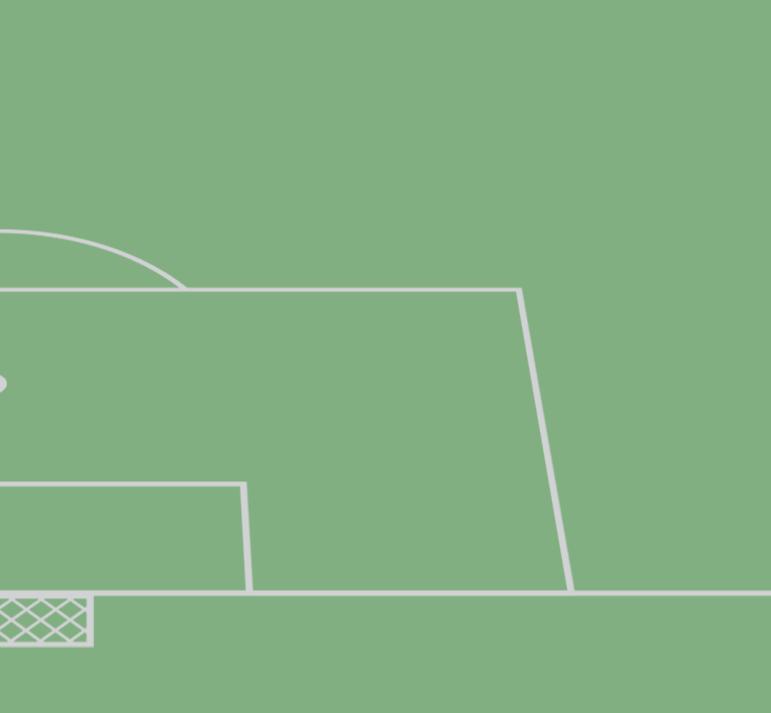
2 AR2 maintains position with the next-to-last defender and watches for infringements and to indicate decisions until the referee regains proper position.
The referee (R) moves to regain correct position, keeping the ball between them and the assistant referee (AR1) so the referee can see any signal from AR1. Priority should be given to getting back to the action as quickly as possible, potentially going straight up the field on the AR1 end. Eventually, the referee can move to regain the correct position along the diagonal path.
2

3 B3 receives the pass and moves forward.
5 AR1 sprints in position to the ball, which is ahead of the second-to-last defender. AR1 must be ready to assist the referee on any infractions since the referee is regaining position.
REFEREE May 2024 | 65
CASEPLAYS
Net Defenders
Play: A1 is on a diagonal run from the touchline toward the penalty area and is behind the defenders. Goalkeeper B2 begins to run out to defend the play. B3 and B4 on the opposite side of the field run toward the goal. B2 recklessly tackles A1 outside the penalty area. At the time of the tackle B3 and B4 are near the goal. Ruling: B1 is cautioned for the reckless tackle. DOGSO does not apply since there were two defenders near the goal (NFHS 12-9-1f10; NCAA 12.4.3.5; IFAB 12.3).
No Red Play: A1 receives a pass from A2 and is now on a breakaway. Goalkeeper B3 comes out of the penalty area and fouls A1. The referee stops play and issues a red card to B3 for DOGSO. Prior to the restart, the referee observes the assistant referee with the flag up. The referee checks with the assistant and learns A2 was offside when receiving the ball. Ruling: Rescind the red card and restart the game with an indirect free kick for team B. The referee can change a decision prior to the restart of play (NFHS 5-1-2; NCAA 5.6.1c; IFAB 5.2).
Two Violent Play: A1 is moving forward when B2 makes shoulder-toshoulder contact and pushes the ball away. B2 becomes frustrated and whips his leg at A1’s ankle and knocks A1 to the ground. A1 gets up frustrated, turns and punches B2 in the chest. Ruling: B2 is ejected for the swipe kick into the ankles since this can cause a serious injury (violent). A1 is ejected for violent conduct. For an NCAA game this would be violent behavior II (NFHS 12-9-2a; NCAA 12.7.4.7.2; IFAB 12.3).
Frustrated Shove Play: A1 has the ball and is moving forward. B2 properly tackles the ball and touches it back to a teammate. B2 continues motion toward the goal. Out of frustration A1 runs toward B2 and deliberately pushes her shoulder into B2’s back. Ruling: A1 is cautioned and the game is restarted with a direct free kick for team B at the point of the push (NFHS 12-9-1f10; NCAA 12.4.3.5; IFAB 12.3).

and failures should not be seen as impediments but as opportunities for one to grow and improve. Being open to feedback is essential as it should lead to personal improvement. Feedback should pave the way for new and better strategies. Striving for competency, then excellence, requires accepting whatever failure occurs and then dealing with it head on.
Having talent and game experience is important, but relying on talent alone will cap one’s ultimate level of success. Improvement beyond talent comes from hard work and dedication. Failure can help a developing official understand hard work and effort can replace weaknesses. Perseverance in practicing the craft is essential to achieving eventual goals. Lower-level, less-competitive games are opportunities to work on skills rather than “mailing it in.” Getting from here to there takes more than talent alone.
Instantaneous decision-making is
a critical component in becoming a competent soccer official. The most basic problem solving must often be done in the blink of an eye. The more one experiences a decisionmaking incident, whether right or wrong, the more instantaneous the decision becomes. Wrong decisions are replaced by correct ones over time. While experience is critical, the repetition of making decisions and honing the skill is equally important.
Sometimes, however, there are problems that develop more slowly during a match. Is the game getting out of control? Are the coaches becoming a problem? Is there a certain player or players who are acting out? These and other areas test one’s problem-solving skills. Failure in these instances should prompt analyzing one’s efficiency at the time and developing new or different strategies for the future. One must learn to recognize slowdeveloping issues that have just as much, if not more, of an eventual
66 | REFEREE May 2024
To get to the highest levels of officiating requires a career of learning — including from one’s own mistakes — and striving to do even better each time one takes to the pitch. Joe Dickerson, Los Gatos, Calif.
SOCCER
BILL GREENBLATT/UPI
impact on the game. And thus, finding and implementing strategies to deal with these situations and when to deal with them are critical.
Developing emotional intelligence is also a necessity. While everyone else may be losing their minds, officials need to keep theirs, which is one of the harder components to learn. Managing one’s emotions, handling one’s own stress, staying composed and being in charge of the contest while chaos might be erupting all around is not a lesson easily mastered.
Everyone will have their share of “nightmare games.” If the referee loses composure, the game is surely compromised. In addition to all the other duties of the referee, keeping one’s head in order to manage the game is paramount. No one begins with this skill; it must be developed over time with likely more than a few instances of failure. Trial by fire is often how officials learn what works and doesn’t work well.
One of the benefits of the officiating journey is the personal growth accumulated along the way. Officials learn to rely on their abilities and judgment in their civilian lives. They become more independent and self-reliant. They realize problems often come with solutions, but solutions are not always evident but must be problem-solved. This takes recognizing the problem, trial and error, and the development of new strategies.
Since most officials along the way are assigned all manner of games, their development isn’t “one size fits all.” There are beginner games, youth games, higher-level competitive games, high school games, adult games and college games, each providing their own idiosyncrasies and strategies. Learning what works in what setting takes time, experience and reflection. Failure begets change.
Developing officials need not fear failure but need to embrace and learn from it. When encountering failure, moving on with a renewed sense of purpose, a new strategy and a new perspective for the next game is essential. The good news is it can be done. More good news is each person’s journey is unique. What works for one does not necessarily work for all. No one ever rose to the highest level of officiating without failure, determination, resilience, hard work, independence, selfreliance and problem-solving.
The journey to becoming a competent official is chock full of failure. It’s the nature of the beast. Let failure be the motivation and inspiration to always keep developing.
Dan Rudloff, Chester, Pa., is a NISOA National Referee Emeritus and longtime high school soccer official who has officiated numerous high school state championships and NCAA playoff matches.








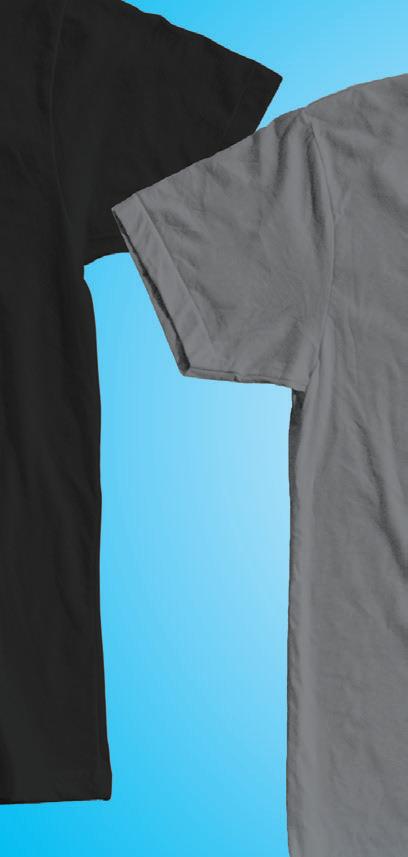



YOUR PRIDE WITH SHIRTS





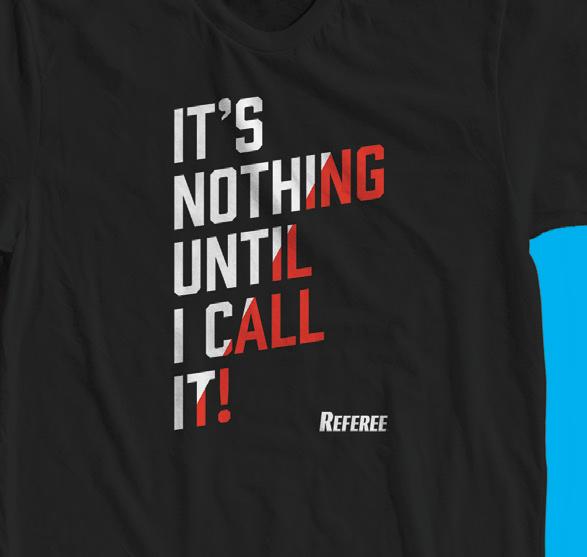


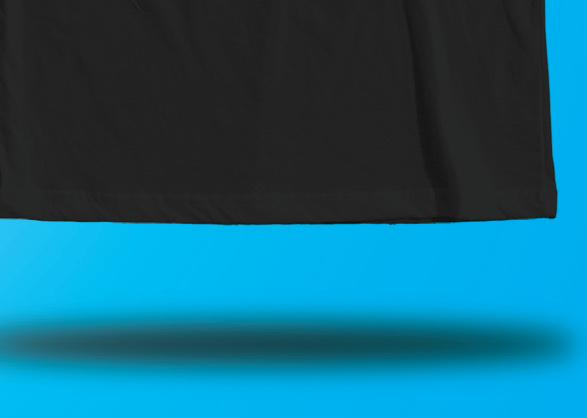







ONLY$19 EACH ORDER YOU SHIRT TODAY! STORE. /CLOTHING SUPPLIES LIMITED
WEAR

MULTIPLICATION LABEL
Plays That Have More Than One Aspect
By George Demetriou
Making a “one-dimensional” call is sometimes a challenge. One of the simplest such calls is determining if a runner is out of bounds. In other words, did he or did he not step on the sideline? While that may sound simple enough, a poorly marked field with crooked lines or spotty painting
may complicate the matter. However when all things are considered, ruling a runner touching out of bounds is one of the more basic calls an official must make.
When a scenario involving multiple aspects occurs, the judgment becomes more difficult, sometimes exponentially more difficult. As an introduction to this topic, here is
an anecdote from a well-respected local coach who was not known to complain about officials. The object of the coach’s comment was a laidback official who can be politely described as inexperienced. The play was a fumble by the coach’s team at the sideline in front of his team’s bench. The ball was awarded to the opponents and the coach inquired, DALE
FOOTBALL RULES, MECHANICS, PHILOSOPHY EDITOR: JEFFREY STERN jstern@referee.com 68 | REFEREE May 2024
GARVEY

Dave
play.
receiver get a foot down inbounds before he goes out of bounds? Will he survive contact with ground, thus completing the catch? What will be the spot of forward progress? Assuming a first down isn’t achieved, should the clock stop
bounds when he recovered the ball.” No reply was forthcoming; the official seemed dumbfounded with a “deer in the headlights” stare. Apparently, the official was totally focused on which team would get physical control of the ball, so he had overlooked the other aspect of the play — whether or not the recovery was made by an inbounds player. Worse yet, it’s possible the official did not understand the ball is out of bounds when it is touched by a player who is out of bounds.
Thus, we can refer to plays with “multiple aspects” as those where at least two rules are involved. In the preceding play, those rules were related to a fumble recovery and to players out of bounds. Before we delve into additional examples of plays with multiple aspects, let’s review the basic principles in calling such plays correctly. The first is recognizing the play involves multiple issues. If the official(s) fail to consider all aspects of the play, the ruling will only be correct through dumb luck. Secondly, the official must recognize and understand each rule and any related philosophy. Finally, the official must recognize the possibility not everything necessary to make the call was seen. If an official can apply all those principles, the play will get called correctly. Here are some examples.
THEY SAID IT

“The decision you make or may not make in (the Super Bowl) potentially will live with you the rest of your life. You have to accept it. You embrace the pressure, but you don’t hide from that.”
— CBS rules analyst and former NFL referee Gene Steratore
CBS SPORTS
SIDELINE
The More Things Change …
At some point during any season in any sport, a coach is going to accuse the officials of favoring the home team. Back in 1965, for instance, Los Angeles Rams coach Harland Svare did just that, and was slapped with a $1,000 fine. Enterprising sportswriters conducting research found that through the first seven weeks of the season, the Rams enjoyed the best home-field advantage when it came to penalty yardage — 142 to the visitors’ 189. In fact, of the 14 teams, eight of them were penalized more at home. In 2023, 12 visiting teams were penalized more than the home teams.
“Why is that their ball?” The official seemed perplexed by such a simple question and replied, “Because they recovered it.” “I saw that,” said the coach, “but his feet were out of
Batting at the sideline. A play similar to the aforementioned recovery at the sideline is the loose ball which is contacted and moves sharply away from or toward the sideline. The first aspect is obvious: Was the ball ever out of bounds? The second aspect is recognizing what caused the ball to move abruptly changing direction and/or velocity and determining if a foul occurred. That brings into play the distinction between a muff and a bat. A muff is the touching of a loose ball in an unsuccessful attempt to gain possession (NFHS 2-2; NCAA 2-11-2), while a bat is intentionally striking the ball with the arm or hand (NFHS 2-27; NCAA 2-11-3).
In making that decision, it is prudent to understand the motivation an astute player may have. The
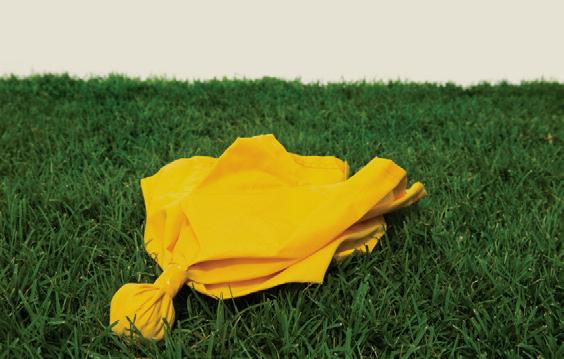
DID YOU KNOW?
The
fumble rule in 1989. Under the rule, most of which still exists today, when a fumble goes forward and out of bounds, the ball is brought back to the spot of the fumble for the next snap. Under the original rule, if the team A fumble went forward and out of bounds in team B’s end zone, team B was awarded a new series at the spot of the fumble. That part of the rule was changed in 1998 to the current rule, which gives team B a touchback in such an instance.
REFEREE May 2024 | 69
Johnson, Woodinville, Wash., has several decisions to make on this
Will the
or keep running? This play is a good example of one with multiple aspects.
NCAA introduced the forward
TEST YOURSELF
In each of the following you are given a situation and at least two possible answers. You are to decide which answer or answers are correct for NFHS and NCAA rules, which might vary. Note: In kicking situations, K is the kicking team, R the receiving team. Solutions: p. 81.
1. Fourth and 10 from team K’s 20 yardline. K1’s punt is tipped by R2 at team K’s 22 yardline. The ball rolls to team K’s 25 yardline, where K3 recovers it.
a. It’s team K’s ball at its own 25 yardline.
b. It’s team K’s ball at its own 21 yardline.
c. It’s team R’s ball at team K’s 25 yardline.
d. It’s team R’s ball at team K’s 21 yardline.
2. Second and 10 on team A’s 30 yardline. A1 runs to his 33 yardline, then retreats to his 27 yardline, from where he throws a forward pass. A2 catches the pass at team A’s 40 yardline and advances to his 45 yardline.
a. Legal play.
b. Foul; penalize five yards from the previous spot and loss of down.
c. Foul; penalize five yards from the spot of A1’s pass and loss of down.
d. Foul; the penalty is loss of down with no yardage assessed.
3. Team A is in shotgun formation with A1 six yards behind the snapper and in position to take a snap. As he is calling signals, A1 places one foot in front of the other and slowly rocks back and forth on his lead foot.
a. No problem as long as A1’s movement doesn’t simulate the start of a snap.
b. If A1 is still rocking when the ball is snapped, it’s illegal motion.
c. False start. The officials should prevent the snap and penalize team A.
4. NCAA only. In extra periods the score is tied, 10-10. The home team kicks a field goal to go ahead, 13-10. On the first play of the opponent’s possession, a fumble is returned for a score. What is the final score?
a. 13-10.
b. 15-10.
c. 19-10.
d. It depends whether the home team is successful on the try.
5. K1’s untouched free kick goes out of bounds. Team R chooses to take the ball at the out-of-bounds spot after enforcement of a five-yard penalty. Team R requests to have the ball spotted in the middle of the field.
a. The request is granted.
b. The request is denied.
offense had the ball, so if it cannot recover the ball, the next choice is to have it go out of bounds. The offense would then retain team possession. The opponent would want to get the ball, so if it cannot immediately recover it, the opponent doesn’t want the ball to go out of bounds; its only remaining chance lies in ensuring the ball remains inbounds. So when an official sees the ball moving in the optimal direction (either toward or away from the sideline) for the player who caused the contact, he has to make sure it wasn’t a bat possibly disguised as a muff. When in question, the ball is accidently touched rather than batted.
Defensive pass interference. Under NFHS rules, the multiple aspects are ruling on the catch while noting any interference. In NCAA play, a third aspect is determining if the pass was catchable.
The preceding examples are all plays where a single official may be expected to evaluate all the parameters and make a call. There are also plays with multiple aspects where it is expected communication among officials is necessary to make a correct call.
Forward progress on a catch. When an airborne player gains control of a forward pass and is contacted by an opponent before he returns to the ground, he is entitled to forward progress at the yardline at which he was contacted provided he eventually completes the catch. The progress spot must be obtained while the catch/no catch decision is made and all players involved must remain under continual observation in case any subsequent fouls occur. That’s a tall order for a single official. The proper procedure is to have an official on the other side of the field mark the progress spot while the nearer official focuses on the catch and any extracurricular activity. Some prep crews are not synchronized well enough for that teamwork, so the covering official must do all of the above. Regardless of how many officials get involved, the play as described clearly has multiple aspects. Offensive pass interference. Various acts result in offensive pass interference. The principles mentioned
above for defensive interference apply. Blocking downfield can be offensive interference. The covering official must determine which player initiated the contact. It is often difficult to ascertain if the offensive player was warding off contact and thus protecting himself or if he was initiating a pick play by blocking the defensive player. In the end, the answer to that question only matters if a legal forward pass crossed the neutral zone. The additional aspect of that play usually dictates a crewmate provide the latter information.
Intentional grounding. Perhaps the foul having the most aspects to consider is intentional grounding. In some cases, it comes down to whether or not the referee judges the pass was intentionally thrown incomplete. He can be guided by the absence of eligible offensive receivers in the area, the flight path of the ball, the ability and skill of the passer and the pressure of the defense. In many cases the referee cannot unilaterally determine the presence of an eligible receiver in the target area because focus is on what happens to the passer after the ball is released. Additionally, the referee must consider if contact by the defense on the passer impacted the flight of the ball or if the passer’s forward progress was stopped before the ball was thrown. Consequently, evaluating all the preceding aspects becomes a crew or multi-official task.
Additionally, there are other parameters to consider, effectively ensuring intentional grounding cannot be a one-official call. There are two ways the passer may intentionally throw the ball incomplete provided certain conditions are met. The passer must be the only player to possess the ball after the snap and if the passer has been outside the free-blocking zone or tackle box and the ball is thrown so that it crosses the neutral zone or the neutral zone extended. Immediately spiking the ball is legal provided the ball does not touch the ground before the pass. In NFHS only, the ball may not be muffed before the pass.
George Demetriou has been a football official since 1968. He lives in Colorado Springs, Colo.


70 | REFEREE May 2024 FOOTBALL
Pregame on the Field
By Judson Howard
You arrive at the venue, you dress and have a good pregame meeting. Are you now ready to work the game? Can the next thing you do be the coin toss and officiate the kickoff? No, your game preparation is not yet complete. What follows are the actions of the official you want to be.
• Social time is over. Consider the optics when conversing with crewmates. Enjoy yourself, but take care to be professional during your assignment.
Avoid prolonged conversations with anyone on the field other than officials. A simple handshake and greeting are appropriate, but do not give excess attention toward team personnel or others on the field. That is not a professional look. Such conduct shows you are not focused
on the upcoming game.
•Perform pregame tasks. Such duties are defined in mechanics manuals. They include meeting with timers and ball assistants. Head linesmen should check the chains. The appropriate officials should get the ball assistants’ names to address them by name during the game.
But after those interactions, you can do more to get you mentally prepared to work the contest. You want to look active on the field by doing things that simulate what you will be doing during the game to help you transition to game situations. Call them “pretend snaps.” That means observing teams as they warm up and do their pregame activities.
•Observe players. Referees can check out the quarterbacks to see if they are left- or right-handed. Watch kickers practice to see if they are left-
or right-footed. That may affect your initial pre-snap position for normal snaps and kicks.
Umpires can observe the linemen warm up to get used to watching for their legal and illegal actions.
Wing officials can stand on the sideline looking down the line when teams are practicing plays. That will get you ready for live line situations such as legal snaps, proper formations, motion, shifts, counting players, giving signals and getting spots. When receivers run sideline patterns, practice seeing if they catch the ball in or out of bounds. Find your key when teams line up.
•Prepare for serious injuries. Confirm a medical person is on site. Ask that person where he or she will be located should attention be needed to deal with an injured player.
See “Pregame” p.68

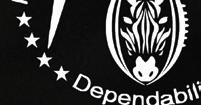


We are excited to announce that the Tom Beard Football Officials Clinic West – El Paso, in El Paso, Texas, is entering its 3rd year. We have extended the days, the amount of classroom time and on-field snaps. You will not want to miss this opportunity! Tom Beard’s Football Officials


WWW.TBFOC.ORG 240-350-6810
Clinic WEST-EL PASO El Paso, Texas May 23-25, 2024 3rd Annual
CASEPLAYS
Forward Progress
Play: Airborne A1 receives a pass one yard deep in team B’s end zone and is immediately contacted by B2 so that he is pushed back into the field of play. A1 lands on his feet at team B’s one yardline, runs and is downed at team B’s five yardline. A1 would have come down in the end zone if not for B2’s contact. Ruling: Touchdown in both codes. The ball is dead when A1 touches the ground in the field of play with both feet and his forward progress is in the end zone (NFHS 2-15-2, 4-22a, 2.15.2; NCAA 2-9-2, 4-1-3a, 5-1-3a, AR 5-1-3 I).
Both Teams Foul
Play: First and 10 for team A from its 20 yardline. Team A is illegally in motion at the snap. A1’s legal forward pass is intercepted by B2 at team A’s 40 yardline. During B2’s return to team A’s 10 yardline, B3 blocks below the waist at team A’s 30 yardline. Ruling: Although both teams committed live-ball fouls, the fouls do not automatically offset. The foul by B3 followed a change of team possession. If team B declines the penalty for team A’s foul (NFHS) or declines offsetting fouls (NCAA), team B will retain possession, but the 15-yard penalty for blocking below the waist may be accepted and would be enforced from the spot of the foul. If team B accepts the penalty for illegal motion, the fouls offset and the down will be replayed (NFHS 10-1-3, 10-2-1b; NCAA 10-1-4 Exc. 1).
Foul on Punt
Play: Fourth and five on team K’s 35 yardline. K1’s punt hits the ground at team R’s 20 yardline and is rolling when R2 illegally blocks below the waist at his 18 yardline. The kick stops moving and is blown dead on team R’s 10 yardline. Ruling: Post-scrimmage kick enforcement applies. The penalty is enforced half the distance from team R’s 10 yardline. It will be team R’s ball first and 10 from its five yardline (NFHS 2-16- 2h, 2-41-6, 10-4-3; NCAA 2-30-3, 9-1-6c, 10-2-2d-4).

PREGAME
continued from p.67
•Look for illegal equipment or unusual situations. Umpires should spot check for illegal or improperly worn equipment. Ask the snappers how they want their ball laces facing before snaps. Then you can spot the ball so snappers do not have to rotate it on the ground. Talk to the special team coaches to get numbering exceptions for kicks. Note those numbers on a card.
•Observe the kickers’ abilities. Deep officials can get under the goalposts as kickers practice. Then rule and signal if kicks are good or no good. Stand near punt receivers as they catch punts. Demonstrate to them what is a proper fair catch signal.
•Check the field. Upon arrival on the field, check for hazards or obstructions. Are the goalposts padded, is the field marked properly (pylons correctly placed, hashmarks, team areas marked, etc.)? Get game management to remedy any field issues, especially ones that may endanger players.
Monitor team behavior on the field to ensure there are no
unauthorized interactions between opposing team players. Most conferences define predesignated zones for teams to practice. You can remind them to stay in their area.
•Share information. Before the coin toss, the referee can share with crewmates what was learned when talking to coaches. For example, any special or trick plays a team may use. The other crewmembers can describe what they have observed, such as formations the teams use, kickers’ abilities, etc.
That should give you a list of what to do to look busy before a game to get ready for live game action and to avoid the optics of just standing around, talking and not preparing to work.
When the game starts after performing such activities, you have observed football play action and are prepared. You will now be able to transition more easily to get into the flow of the game, as opposed to getting into the game after a series of downs or two.
Judson Howard, Los Angeles, is a replay official in the Pac-12 Conference. He officiated more than 20 years, many at the NCAA Division I level.
FOOTBALL 72 | REFEREE May 2024
DALE GARVEY
Ron Beal, Redmond, Wash., inspects a player’s padding. Ensuring auxiliary padding is legal in that way is a form of risk management that should be a part of every official’s mindset before and during games.
When It’s All on the Line
By Jason Nickleby
In an NFL game last season, a quarterback was flushed out of the pocket and moved quickly toward the sideline. With one step to go before the white, contact was made. Flags flew. Was a flag for a late hit warranted?
Maybe. It is helpful to break a play down into chunks and evaluate them through those various lenses.
Progress ends when the runner is down by rule. A runner is down when forward movement is stopped, the runner is out of bounds or when a loose ball is declared out of bounds
(NFHS 2-15, 4-2-2a, b, k and l, 4-3-1, 4-3-3; NCAA 2-9-2, 4-1-3a, b and p, 4-21, 4-2-4, 5-1-3).
All of that seems pretty cut and dried. But officials know it is anything but. A hallmark of quality officiating is the ability to develop judgment that meshes art and science with finesse.
How should we assess plays at the sideline relative to forward progress and out-of-bounds status?
Starting with plays on the sideline, let’s focus on mechanics. Line of scrimmage officials need to allow the runner to proceed downfield (assuming we are outside the five yardline) and officiate blocks and the runner from behind. We may even need to take a step or two into the backfield to allow for a wider field of vision. Many officials feel it is best practice and shows good hustle when we stay even with runners. Unfortunately, that stacks us up at best and, at worst, puts us in a possible scenario where we are part of the subsequent tackle. If the snap starts inside team B’s five yardline, move immediately to the goalline and get as far off the sideline as possible to safely rule on plays at the pylon.
If the runner is fighting for yardage while in the field of play, or we are not sure if he is in the white, we will give the defense the benefit of the doubt relative to a late hit out of bounds. If we are calling fouls on that type of action, we are putting the defense in an impossible position of knowing when to let up and when to finish the play.
A runner stepping on the white doesn’t guarantee a foul either. If the runner just stepped on the line and contact is simultaneous or within reason, as seen in the PlayPic, we should pass on a foul. In situations where the runner seems to be giving himself up at the sideline, not attempting to gain additional yardage, and we are not sure if the runner is out of bounds, we should lean toward a foul. As with any forcible hit anywhere on the field, if we are 50-50 on a foul, we should err on the side of safety and drop a flag.
In addition to ruling on the legality of the contact, we also need to have an awareness of the forward progress spot relative to the plane of the sideline and the line-to-gain. That is another reason why it is important to stay back and stay wide so we can rule on progress that involves the line-to-gain. In all situations crossing the sideline, except for plays in the end zone, the forward progress spot will be the furthest point of the football as it crosses the sideline. We should close on that spot and turn
and face out of bounds while killing the clock. The last thing we should worry about is retrieving the football. Don’t rush to get a ball while ignoring dead-ball officiating responsibilities.
In situations where runners are stretching for yardage with the runner clearly in the field of play and forward progress still in doubt, we should have a patient whistle and afford the runner the opportunity to gain as much yardage as possible.
We may need to take the forward progress spot from our line of scrimmage partner via crossfield mechanics. That is especially true if the runner is driven back or pulled backward. If a pile is clearly moving forward, we can allow it to play out. When the pile slows down to a standstill or something close, we need to kill the play because nothing good will come from allowing the play to continue.
Jason Nickleby is coordinator of officiating services for the Minnesota State High School League. He is also a center judge in the Big Ten Conference.

REFEREE May 2024 | 73
Father-Daughter Duo Make Officiating History
By Leah Berard
Ben and Sarah Tanglao made history on Nov. 12, 2023, at Franklin High School in Somerset, N.J., when they became the first parent-child duo to officiate a state championship contest. At the New Jersey State Interscholastic Athletic Association (NJSIAA) state volleyball finals last year, the Tanglaos officiated the matchup between Immaculate Heart and Paul VI for the Non-Public A state trophy, with Ben as the first referee and Sarah the second referee.

Sarah called it the most amazing moment of her career in 20 years of sports officiating.
“Seeing my father opposite me, beaming with pride, will forever stay in my memory as one of the best days of my life,” she said.
Sarah started officiating in 2001 when she was 19. She first chose basketball, where her dad had much success, but then quickly changed course to follow in her father’s footsteps as a volleyball official. “I originally started officiating as a way to
still stay involved in sports, as I was an athlete in high school,” Sarah said. She currently officiates men’s and women’s college volleyball at the Division II and III levels, and hopes to work her way through the officiating ranks to receive Division I assignments. As her children are now older and more self-sufficient, she will have more time to dedicate to her craft.
Ben, Sarah’s biggest supporter, began his officiating career in 1999 after a friend of his wife, Carrie, convinced him to pick up a whistle and give basketball officiating a shot. “At first, I was just interested in making an extra income, but then I started to like it and became really good at it,” Ben said. The following year, he added high school volleyball to his résumé.
Over the next decade, Ben officiated men’s basketball in the Eastern College Athletic Conference and American Basketball Association (ABA) — a semi-professional men’s league and successor to the original ABA that was absorbed into the NBA in 1976 — before deciding to cut back on travel.
“I enjoyed and loved every assignment I did from junior college to the Division II level,” Ben said, “but the most memorable one was the championship game last year seeing Sarah on the other side of the court.” He said it is a memory he will never forget.
With three children who have all officiated — his two sons, Zachery and Benjamin John, have each had a taste of officiating basketball — Ben is excited to watch Sarah continue the legacy.
“Sarah has this talent and personality of dealing with players and coaches,” Ben said. “She became so good at it that players and coaches were always glad to see her officiate their game.”
Leah Berard, St. Paul, Minn., officiated international rugby and now officiates high school and college football.
Balancing Act

William Ast Gray County, Kan.
As is the case in most places, rural western Kansas is short on sports officials, and 19-yearold William Ast has answered the call. Ast has been officiating high school basketball four and sometimes five nights a week in addition to being a full-time student at Garden City Community College.
“I’ve loved officiating ever since elementary school and it’s always been something that I’ve wanted to do,” Ast told the Dodge City Daily Globe. “Plus, there’s such a shortage of officials right now, I thought it would be good to help out.
“It’s been fun. I’m enjoying it. I’ve met a lot of good people who helped me along the way and I enjoyed working with them. I recommend people sign up and become an official — they are much needed.”
SOURCE: DODGE CITY DAILY GLOBE
Tullamore Tribute

Michael Flanagan Tullamore, Ireland
When Michael Flanagan started officiating soccer, he was one of the only local referees in his hometown of Tullamore, Ireland. That was the beginning of a 50-year career as a referee for Flanagan, whose journey as a youth soccer official was honored this past January in an exhibition at Tullamore Library.
“What I found from all this was you start out with a kid at 9, the following year they’re 10, 11, 12,” Flanagan said at the opening of the exhibition. “You see them growing and not alone that, it’s a privilege to be with them and to be togged out and to be out there. You’re in heaven really.”
SOURCE: TULLAMORE TRIBUNE
Do you know a person or group who should be profiled?
Send info to us at profiles@referee.com
PHOTO COURTESY OF BEN TANGLAO; SANDY MYERS; TULLAMORE TRIBUNE
74 | REFEREE May 2024
PROFILES PERSONALITIES PLUS
Sarah Tanglao (left) and her father, Ben, became the first parent-child duo to officiate a state championship matchup during the 2023 NJSIAA state volleyball finals.





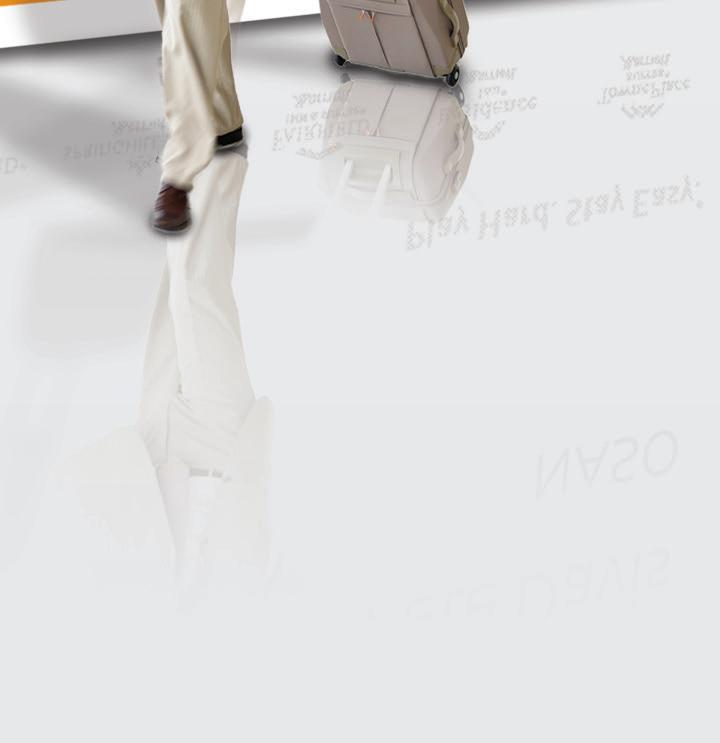

As an official, only NASO membership gets you into Marriott’s exclusive athletic discount program, which provides a discounted rate at Marriott and Starwood branded properties in the US and Canada. With the VIP card, NASO members are able to stay at those participating hotels for a room rate up to 25 percent lower than the regular price, based on availability.

UPGRADE YOUR REFEREE SUBSCRIPTION TO A FULL NASO MEMBERSHIP TODAY! Visit naso.org/join or call 1-800-733-6100 EXCLUSIVE ACCESS ONLY FOR NASO MEMBERS
YOU’RE GOING TO GET YELLED AT
You don’t have to be in this avocation long to realize sports is life with the volume turned up and competition brings about human emotion. Learn to ignore the obnoxious fans and learn to recognize the moment you need to turn to game management to handle a problem. There’s a big difference between an emotional, spontaneous reaction to a play or call and a calculated, personal, profane attack on the officials or the good of the game. Learn the difference and manage accordingly.
TRUTHS
MASTERING THE RULEBOOK DEFINITIONS GOES A LONG WAY
Just as a building can’t stand long without a proper foundation, a sports official doesn’t go far without a firm understanding of the definitions. Knowledge in that part of your rule code will go a long way toward instilling confidence in your adjudication of the rules and communication with players and coaches. Using rulebook language in a way participants can understand is an incredible asset for any official.
76 | REFEREE May 2024
2 -BY THE EDITORS OF REFEREE MAGAZINE -
TIMELESS
The following “Timeless Truths” are nuggets of wisdom for all sports officials. Enjoy. 1
MENTORING IS VITAL TO OFFICIATING
No matter where you are in your officiating career, there is always someone in your association or area with less and more experience than you. Lean on someone who has been there before to provide insights, give feedback and prepare you for what might be coming next. Likewise, reach out to someone who is in a position where you once were in your career and help them along.
NETWORKING AND POLITICS ARE INEVITABLE
Like it or not, officiating is a people business and human connection is part of what you signed up for. Expand your horizons and be willing to network. Be honest, be compassionate and be diplomatic when needed.
PLANNING IS REQUIRED
Time management and attention to detail are prerequisites for being in this avocation. You will learn to improve both the more you work. Preparing for traffic and weather ought to be part of your planning. Working with various stakeholders to keep contests and events on schedule goes a long way toward your success. Oh yeah, and there are always curveballs! You will get good at adjusting on the fly.
DEMEANOR AND ATTITUDE MAKE ALL THE DIFFERENCE
From the time you accept an assignment you are connected to it. With the prevalence of video recordings there is a good chance the event lasts forever in terms
of your association with it. Be courteous to assigners, supervisors, crewmates, administrators, players, coaches, trainers, photographers and fans. Carry yourself with proper demeanor and attitude. Take care of business when necessary. You never know when someone is watching or when word might get back to a coordinator or commissioner.
ASSIGNERS PLAY FAVORITES
We’re all human, including the people assigning the game or contest. They are going to have their favorites and there is nothing you can do about it beyond being dependable and having a good reputation. Control what you can control. Many assigners understand sometimes the best “ability” is availability. Help when you can. Show up on time. Work hard. The rest will work itself out.
EXPRESSING YOURSELF WILL BECOME EASIER WITH EXPERIENCE
Whether it’s explaining a rule or describing a judgment, work on clarity and conciseness. The great officials can convey a message with as few spoken words as possible to get a point across. In many sports, the timeframe to communicate a ruling to players, coaches and fans is not long before the next action. Repetition and experience will help.
“CREWNESS” DRIVES SUCCESS
There will be officiating partners you like, partners you hope you never work with again and partners you want beside you when all hell breaks loose. Sometimes each other is all you have out there in the heat of battle. Help each other. Lean on each other. Defend each other.
TIME CATCHES UP TO EVERYONE EVENTUALLY
As people say, Father Time is undefeated. Many sports are physically demanding for many officials. Pay attention to your diet and fitness and don’t let an injury linger without treatment. Many officials regret ignoring an ailment and it ends up costing them their season or their career. Your physique is one of the most important assets you have in officiating. Treat it that way!
FANDOM IS A SLIPPERY SLOPE
No matter the sport or level you officiate, you have a connection and commitment to the industry. Treat this endeavor as a calling and act accordingly. Inevitably you will begin to watch higher-level contests with an officiating eye, not just from a fan’s perspective. Respect what other officials go through and communicate with the broader community if possible, or when necessary. Don’t let any school or team affiliation jeopardize your officiating status.
LONG AFTER YOU RETIRE, YOU WILL WISH YOU WERE OFFICIATING
No one officiates forever, including you. Savor each moment while you can. It may not be the rules study or the preparation or the game management demands put upon us that you will miss, but chances are you will long for the officiating connections and the spirit of competition once you are retired. It’s an honor to explore this avocation. Enjoy!
REFEREE May 2024 | 77
3 10 11 12 4 5 6 7 8 9

SOUND ADVICE
Developing a Thick Skin Against Verbal Abuse
By the Referee editors
At some point during orientation classes for rookie officials, a wise old trainer will tell the newbies, “You’re going to get yelled at. Be prepared for it. Get over it.” Or words to that effect.
A small percentage of the rookies will think to themselves, “I can take it. How bad can it be?” But the vast majority will think to themselves,
“Geez, I don’t want anybody screaming at me. I’ll be doing the best I can. How do I learn to deal with that?”
The first thing newer officials should learn is, no matter how correct their call may be, one side will agree with the decision. The other will think the official is sight-impaired, biased, mentally deficient or insufficiently versed in the rules. Perhaps all at the same time. That’s the nature of the business.
While there are many traits needed to become a good official, developing a thick skin ranks near the top of the list. While possessing a thorough knowledge of rules and mechanics is crucial to being effective, officials won’t get the most out of their ability if they’re thinskinned.
According to the dictionary, being thin-skinned is “readily or unduly susceptible to criticism or
ALL SPORTS FOR ALL SPORTS, ALL LEVELS 78 | REFEREE May 2024 EDITOR: JEFFREY STERN jstern@referee.com
HESTON QUAN
Mychal Creer, View Park, Calif., knows not to take this coach’s negative comments personally. Ignoring criticism allows officials to sustain concentration and maintain confidence in themselves.
insult.” If that describes you, you don’t need anyone to tell you it likely affects your performance while officiating. Officials who pay more attention to the criticism they hear from the stands and sidelines rather than focusing on what’s happening between the lines will find their ability to officiate severely hindered.
While you may not be able to discern specific comments hurled at you by an angry crowd, you can tell they’re not bon mots. But you have to understand the jabs aren’t directed at you personally, it’s your position that’s being disparaged.
So, how do you handle the doubters
What is the best way to handle the criticism? Ignore it? Give it right back? A person who had a foolproof answer for that question could be making millions by making instructional videos and delivering speeches at conventions.
Many officials have attempted to banter with fans. You’ve likely heard about officials who answer taunts with, “If you think it’s so easy, come on out here and try it yourself.” Rather than turning down the heat, that usually increases it.
One referee, a local legend of sorts, hopped into the bleachers, sat next to a leather-lunged spectator, watched a few seconds of the game and said, “By golly, you’re right. You really can see the game better from here.” The sarcasm failed miserably and the abuse only increased.
Fans who use extreme profanity or threatening or racist remarks must be dealt with, but not directly. That’s a job for the game manager. If no game manager is available, the coach whose team the fan supports should be asked to handle the situation.
Coaches must be treated differently than fans since they are a part of the game. Questions posed in a calm and reasoned manner should be answered. When reason goes out the window and ranting ensues, the rules provide remedies. Officials who choose not to employ them are inviting more invective.
Move on from mistakes
It seems reasonable to think that the more games you officiate, the better you’ll be able to handle criticism. But is that really true? Just because you’ve worked games for several years doesn’t make you immune to abuse or more skilled at soaking it up. Many officials who have 10-15 years under their belt still have trouble handling criticism.
How can an official go from absorbing the punishment to having the ability to shrug off criticism?
Tirades usually follow missed calls. If you know you kicked one, you might give the coach a slightly longer leash to air a complaint. You may choose to admit the error; coaches are sometimes so stunned to hear an official confess to a blunder they see no need to pile on.
At any rate, don’t dwell on your mistake. If you don’t let it go, one error turns into more and the level of criticism rises along with it.
There will be times you’re unsure about a ruling and you may have to consult a partner. Remember you’re free to change your mind about a call, but it should never appear you were talked into that change. And if you do change your mind, do it in a strong, decisive manner. You will still catch significant heat, but doing the right thing often comes at a price.
Attempts at coercion
There are times when your judgment beyond ball or strike, foul or no foul, pass or fumble will be aggressively challenged. You may have to decide whether or not to terminate or halt a game due to weather issues. That decision may be beneficial to one team or disadvantageous to the opponent. A hue and cry will go up in an effort to encourage a stoppage or demand play continue. Similarly, a seemingly injured athlete will be hesitant to leave the game.
When player safety is involved, no amount of dissonance should sway you. If you’re going to err in those situations, err on the side of caution.
THEY SAID IT
“As in any occupation, some (referees) are better at it than others and even the best are only human. Keep your commentary for the ride home — that is why God invented cars — and remember: It is quite possible that you were wrong and they were right.”
— Mary McNamara, L.A. Times columnist, in a piece titled, “Why Youth Sports Drive Parents Crazy and 10 More Lessons From a Mom Who’s Been Through It”
QUICKTIP
Each new game is a learning opportunity. Don’t just go in, work the game and leave; get something out of it. If you are unsure of a ruling, for example, take mental notes of what happened, then dive into the rulebook at the first opportunity to get a better grip on the ruling. If there are several plays you were unsure of or your partner had some plays you have questions about, talk about the plays with partners after the game. And use technology to get other officials’ opinions as well. Texting or emailing a situation to your officiating circles can give you the answers you need.
SURVEY SAYS ...
Does your primary sport have issues with multiple lines or coloring of multi-use playing surfaces that make it difficult on officials?
Yes: 46%
No: 54%

REFEREE May 2024 | 79
SOURCE: SURVEY OF 163 REFEREE READERS
Meant to Be a Mentor?
Having a great mentor doesn’t automatically put someone on the rocket ship to officiating success. But most great officials will tell you someone had a hand in their development and growth. Those who have seen how powerful mentoring can be may choose to take on the challenge themselves. If that’s you, here are some things to consider.
Adaptability
Technology has become an important educational tool in all sports at all levels. Whether it’s using an app in your pregame, setting up an online study group or clipping and sharing game video, mentors look for ways to incorporate technology and use it to their advantage. As games change, so do rules, mechanics and philosophies that go along with them. Mentors stay on top of those changes (and at times even influence the change).
Approachability
Mentees have to feel comfortable talking to their mentor. A mentoring relationship is not just about the business, it’s personal. Mentors build trust early on in order to establish confidence in the relationship. They know they need to initiate conversation that makes a potential mentee feel comfortable. Sometimes it’s as simple as recognizing and reaching out to officials who have recently been added to a league they work to say, “Congratulations,” or, “I’m here for you.”
Availability
Mentors pick up their phones and return text messages and emails in a timely fashion. They may not always have the time to talk the moment they are contacted, but they always make time sooner rather than later. It’s important for those they mentor not to feel like a nuisance. Mentors make the effort to foster the relationship.
Communication
Mentors know how to manage the uncomfortable conversations that will inevitably take place. They may need

to tell an official to lose weight or they messed up a rule. Mentors handle those situations with a tough love approach. They are honest, fair and always keep the best interest of the ones they mentor at the forefront of their interactions with them.
Character
Mentors are good people. They carry themselves in a way that makes others excited to work with them. They do not engage in gossip. Mentors have a way of putting the best face on even in the toughest situations.
Consistency
The best mentors are “do as I do” kind of people. They practice what they preach and believe in what they are doing. Their actions are a direct reflection of the lessons they teach. If a mentor tells a mentee to update his or her availability daily, the mentor is constantly making sure his or her own is up to date. If a mentor tells the mentee to lose 10 pounds, he or she has worked hard to maintain his or her own physique.
Credibility
Mentors are able to help others achieve their goals because they have experienced successes of their own. They’ve put in the time to master their
craft and have somewhat of a resume to show for it. That doesn’t mean mentors have to be at the end of their careers. However, the more games, tournaments and experiences they have, the more knowledge they have to pass down.
Humility
Mentors aren’t in it for the glory. They don’t make it about themselves. They find deep satisfaction in helping others succeed.
Positivity
A true mentor makes a positive impact in the lives of those they mentor. They have an uplifting attitude. When mentees are dealing with tough situations, a mentor puts a positive spin on it rather than engage in talk that brings themselves or others down.
A mentor’s job is to help develop the next generation — of great officials as well as great mentors, too. Mentors know they may very well end up working a game or two with their mentee. If they have helped their mentee and given them keys for success, they know their game is going to go a lot more smoothly. Their example keeps the game on a positive trajectory and ultimately creates the mentors of tomorrow. Are you up to the challenge?
DALE GARVEY
ALL SPORTS 80 | REFEREE May 2024
When instructing at a camp, Steve Keating, Mountlake Terrace, Wash., comes in contact with any number of potential mentees. His willingness to serve as a mentor helps grow the corps of skilled umpires available to work games in his area.
Prep for the Unusual
By Jeffrey Stern
There’s no way to prepare for absolutely everything that could occur during a contest. But here’s a review of the most common of the uncommon and suggestions for how to react.
Accusations. Comments like, “Call it both ways,” and questions about why the foul totals aren’t even are indirectly hinting at your integrity. You have to stop that type of behavior.
But what if they directly accuse you of cheating? If a coach calls you a cheater, don’t stand for it. Use every tool the rules allow to address the accusation.
If charges are made during or after a game by a coach, notify your appropriate league office or supervisor and document the comments in your game report.
Crew/partner issues. You can’t always choose with whom you work. Sometimes you will be paired with an official whose dedication, knowledge, enthusiasm or competence are not the same as yours. For that game, you have to grin and bear it.
What about after the game? One of the last things an assigner wants is a late evening phone call from an official who wonders what he or she did to deserve that lemon of a partner.
Keep it in the back of your mind for the next time you speak to the assigner about an unrelated issue. Be respectful and state your concerns. You might luck out and the assigner will say, “By the way, thanks for working with Billy Bob last month. I know his better days are behind him, but I was desperate for warm bodies that night.”
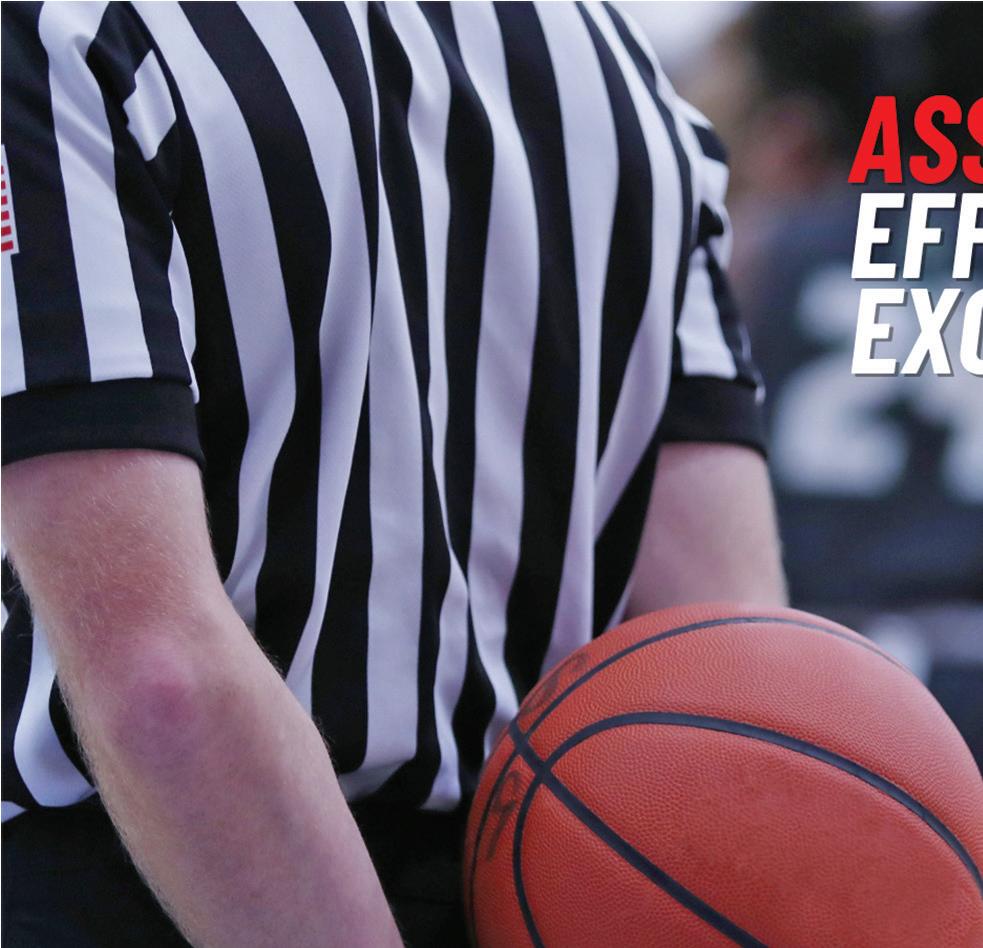
Fan misbehavior. Officials have been told ad nauseum to ignore comments directed at them by spectators. But what if a team or individual players are the targets?
Racist, sexist or threatening chants, cheers, banners or comments should be addressed by game management.
If objects are thrown onto the playing surface, the game should be stopped and the court, field or ice cleared of debris. Request a public address announcement that the behavior must cease. But if the appeal goes unheeded and player safety is compromised, it isn’t inappropriate to send the teams to their locker rooms or benches until order is restored.
Jeffrey Stern is Referee’s senior editor. He officiated high school and college football and umpired high school baseball.
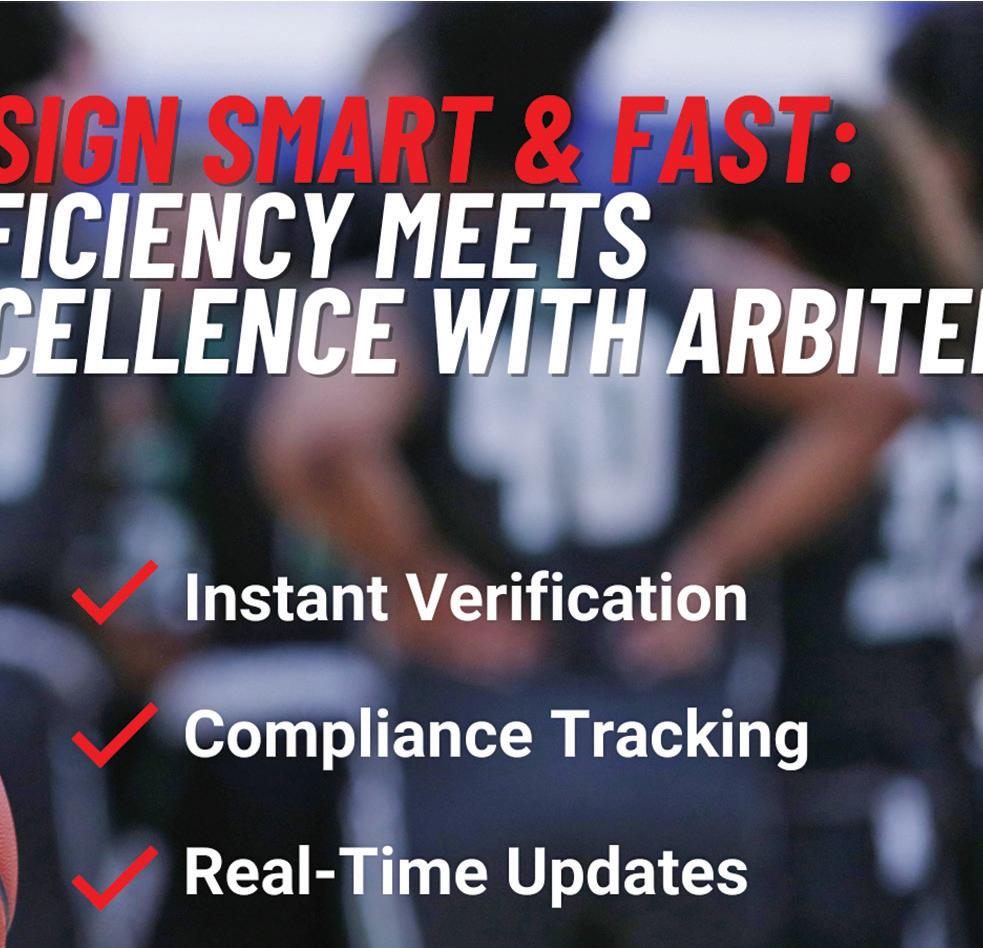

REFEREE May 2024 | 81
FOR THE RECORD
AWARDS, ROSTERS, NOTABLES
HIGH SCHOOL
•These officials were assigned by the Maine Principals’ Association to work 2023 fall sports championships:

Field Hockey — Class A: Michele Dwyer, Rebecca Fletcher, Patrick Lucas. Class B: Maureen Curran Swanson, Lauri-Beth Rankin, Crystal St. Onge. Class C: Melissa Bragdon, Cindy Place, Delaney Wood.
Football — Class A: Dominic Babine, Chris Bessey, Stacy Bradburn, Mike Floridino, Ben Garrett, Jeff Gilbert, Chris Goding, Will Lynch, Patrick Mulcahey, Walter Phillips, Darcy Robinson, Phil Smith. Class B: Mike Cook, Laura Donahue, Peter Fontaine, Dick Lacasse, Rick Lear, Dexter Pinkham, Chad Reynolds, Tim Rice, Chris Simmons, Smith, Doug Stockbridge, Ralph Vintinner, Doug Wilcox. Class C: Rick Bates, Peter Bingham, Dennis Dacus, Ryan Gero, Bob Harvey Webster, Joe Mertzel, Kevin Orr, Norm Pelletier, Brian Richardson, Matt
Strout. Class D: Phillip Alley, Patrick Breton, Mark Cooper, Connor Dayton, Cyle Dendy, Brian Ferland, Kevin Hachey, John Heald, Jarrett Hill, Mark Hoover, Tim Kenney, Dan Labrie, Brian LeClair. 8-Man
Large: Cary Briggs, Brandon Carney, Ralph Damren, Chris DeRusha, Jared Forrest, Joe Gallant, Pat House, Debbie Langillie, Bill Leary, Brian MacDonald, Erv Morrison, Andrew Neff, Rob Neil. 8-Man
Small: Cook, Steve Delcourt, Bob Fontaine, Forrest, Gallant, Langillie, MacDonald, Kevin McKailk, Scott Morrill,
Neff, John O’Neil, Derek Perkins, Mike Wilson.
Boys’ soccer — Class A: Jay Baines, Ken Brillant, Jeff Howes, Mike Pullen. Class B: Chris Girardin, Daniel McEachin, Patrick O’Reilly, Chris Roy. Class C: Jason Pelletier, Andrew Porada, Dom Rossignol, Jon Woodcock. Class D: Allen Drew, Don Plourde, Charles Soule, Steve Thibodeau. 8-Person Boys: Steve Boyce, Chris LeClerc, Fred Libby, Bob Wassick
Girls’ soccer — Class A: Elthon Ayurambi, Alex Chalken, Aruna Kenyi, Russ McGregor. Class B: Brad Ala, Jude Mulcahey, Kosta Nedelkovic, Stephen Peats. Class C: Todd Albert, Jordan Clavet, Dillion Drew, Erica Lambert. Class D: Jacob Gerrie, Ryan Guerrette, Larry LaRochelle, Pyta Lomeri. 8-Person Girls: Dave Astie, Libby, Brad Lunt, Pedro Rodriguez.
Girls’ volleyball — Class A: Gerry Billings, Brian Hewitt, Michael Roux, Michael Scott. Class B: Sarah Bingham, Jim Brown, Richard Bryant, Jason Knight. Class C: Don Beal, Stu Marcoon, Gave Renault, Basil Woodward.
•These officials were assigned by the Georgia High School Association to work 2023 fall sports championships: Football — Theron Adams, DeWayne Aiau, Alford Arnold, Chris Barnes, Ryan Barrow, Don Becton, Maurice Bellamy, Byron Berryhill, Anthony Breaux, Jacobi Brown, Quincy Brownlee, Andy Christopher, Ken Clampitt, Robert Cunningham, Jerrold Douglas, Todd Downes, James Files,

Richard Frierson, Thomas Graham, Ricky Griffin, Keith Hammond, Robert Hampton, Khenji Harris, Greg Hendrickson, Brian Holmes, Dylan Hulsey, Jason James, Paul Johnson, Rodney Kinnie, Theodore Lamar, Terrell Lawson, Cameron Mason, Todd McCutcheon, Saul Menendez, Greg Mills, Jacob Moore, Rakeem Munford, Nicholas O’Donnell, Cedric Patterson, Keith Patterson, David Reynolds, John Richard, Foy Shemwell, Shawn Schumacher, Alan Skinner, Tom Skinner, Antwoine Stewart, Freddie Stewart Jr., Raymond Stubblefield, George Thomas, Rob Underwood, Mike White, Darryl Whitfield, Ashton Wilkerson, Terry Winguard, Jay Worley.
Girls’ flag football — Duncan Blankenship, Stephanie Calhoun, Caroline Caplinger, Frierson, Brandon Janko, Kory Jone, Brian Kelly, John Key, Lee Maulding, Jason Rohletter, Sheldon Smith, Haven Thomas.
Football video review officials — Clyde Allen, Adam Causey, Danny Everett, Clifton Puckett, Spencer Smith, Mark Staton, Joe Sturniolo. Volleyball — Stephanie
to work 2023 fall sports championships:
Football — Davis Alden, James Bratton, Joe Deaton, Joe Doak, Kurt Engle, Ron Erickson, Tony Garber, Sean Geer, David Julson, Mak Keetly, Todd Limoges, Sam Mamalis, Bryon Mowry, Owen Mullinax, Ben Partlow, Nate Pead, Carsten Phillippi, Terry Pyer, Eric Quinney, Richard Ramos, Gordon Shinkle, Tyler Spear, Tony Thorpe, Jeff Wass, Tom Wells
AWARDS & HONORS
•In February, the NFHS announced the recipients of its 2024 Citations. Jay Lemelin, a longtime football and basketball official from Billings, Mont., was honored with the NFHS Officials Association Citation. Lemelin has been officiating high school football since 1983 and added basketball to his officiating resume in 1990.
•As part of a partnership between the NFL and NFHS to help increase recognition and participation of high school football officials, the first-ever NFL High School Football Officials “Crew of the Year” was selected in January. The crew, nominated by the Cleveland Browns, includes six Ohio officials: referee Mark Riley, Westerville; umpire Jake Smith, Centerburg; head linesman Nate Filkins, New Albany; line judge John Clay, Gahanna; back judge Trevor Lotz, Columbus; and center judge Kurt Schooley, Hilliard.
OBITUARIES
• George (Jerry) Stone, 82, of Richmond, Va., died Dec. 4, 2023. He officiated basketball for 45 years, softball for 40 years and volleyball for 15. He worked 20 state basketball championships, 12 softball championships, and two volleyball championships. Stone was also an NCAA basketball official at the Division I, II and III levels, including the ACC and CAA. In April 2023, Stone was inducted into the Virginia High School Hall of Fame. Designate
Abraham, Michael Aoa, Jim Barrow, Susan Johnson, Eduardo Kianes, Gary Landon, Jose Lopez, April Ludwig, Khiah Lynch, Stephanie McDonald, Sean Muhammad, Stan Oden, Steve Parham, Jennifer Phiel, Danny Rager, Scott Rismiller, Billy Shipley, Brian Silitto, Alaina Smith-Walker, Paul Stevens, Patricia Taylor, Keith Wages, Damon Walker, Harold Weber, Dwayne Wilson. Fast-pitch softball — Raymont Chapman, Lynn Church, Lee Folsom, Lee Gray, Robbie Guest, Powell Hazzard, Shane Head, Henry Hill, Matt Hudson, James McHugh, Russell Nast, Reggie Pettus, Chris Phillips, Jill Poole, Dusty Purdue, Kenny Rogers, Schumacher, Ricky Sexton, Rana Smith, Michael Stewart, Jason Taylor, Barry Trammell, Heath Walker, Steve Wenner.
•These officials were assigned by the Wyoming High School Activities Association
Do you have any rosters, assignments or awards that warrant mention?
82 | REFEREE May 2024
POSTSEASON ASSIGNMENTS
NASO as a beneficiary of your retirement plan or life insurance policy. LEARN MORE AT NASO.ORG/LEGACY OR CALL 800-733-6100
Send info to us at ForTheRecord@referee.com
ROSTERS
2024 MLB Spring Training Invitee Umpires
MLB selected the following umpires to work Cactus League and Grapefruit League games during 2024 spring training.
David Arrieta
John Bacon
Brock Ballou
Matt Brown
Paul Clemons
Tom Hanahan
Steven Jaschinski
James Jean
Edwin Jimenez
2024 UFL
Emil Jimenez
Austin Jones
Tyler Jones
Dexter Kelley
Alex MacKay
Chris Marco
Dan Merzel
Jacob Metz
Jonathan Parra
The 2024 officiating crews for the United Football League (UFL), the merger of the USFL and XFL. Order is referee, umpire, down judge, line judge, field judge, side judge, back judge.
Adam Savoie, Colleyville, Texas
Daniel Gautreaux, Scott, La.
John Braun, Ogden, Utah
Darren Deckard, Inglewood, Calif.
Nicole Randolph, Farmington Hills, Mich.
Raymond Daniel, Temple Hills, Md.
Peter Buchanan, Fairfax, Va.
Bryan Banks, Champaign, Ill.
Amanda Sauer, Pittsburgh
Stephen Ray, Frisco, Texas
Brian Perry, Houston
Josh Aragon, Rocklin, Calif.
Ryan Flynn, Arlington, Mass.
Brett Toney, Collierville, Tenn.
Stuart Mullins, Salem, Va.
Dan Scanlan, Springfield, Pa.
Kole Knueppel, Milwaukee
Nick Theriot, Maurice, La.
LaShell Nelson, Irving, Texas
Milton Britton, Boston
Jacques Hooper, McDonough, Ga.
Derek Anderson, Bellville, Texas
Cat Conti, Agoura Hills, Calif.
Chad Green, Columbia, Mo.
Marcus Allen, Lewis Center, Ohio
Kendall Smith, Harrison Township, Mich.
Justin Larrew, Olivette, Mo.
Jake Kemp, Rockford, Mich.
Jason Autrey, Holt, Fla.
Jen Pawol
Charlie Ramos
Jeremy Riggs
Derek Thomas
Nate Tomlinson
Brian Walsh
Ron Turner, Monroe, La.
Andy Warner, Gilbert, Ariz.
Monique Washington, Ellerslie, Ga.
Glen Fucik, Richmond, Texas
Phillip Hicks, Van Buren Township, Mich.
Joe Johnston, Missoula, Mont.
Chris Coyte, Santa Ana, Calif.
Ian Malepeai, Boise, Idaho
Robert Richeson, Wichita, Kan.
Jim Wharrie, Aliso Viejo, Calif.
Joe Martinez, Albuquerque, N.M.
Wes Booker, Maumelle, Ark.
Justin Nelson, Layton, Utah
Jeff Heaser, Gallatin, Tenn.
William Thomas, Reading, Pa.
Cravonne Barrett, Lancaster, Calif.
Jeremiah Harris, Frisco, Texas
Michael Kennedy, Chesapeake, Va.
Gabriel DeLeon, Phoenix
Donnie Aultman, West Monroe, La.
Michael Vandervelde, Mandeville, La.
Krystle Apellaniz, Oviedo, Fla.
Rod Ammari, Fullerton, Calif.
Josiah Ford, Parker, Texas
John Morton, Southlake, Texas
Raymond Tate, Lewisville, Texas
David Ross, Mesa, Ariz.
Francisco Villar, Los Angeles
Chris Snead, Lubbock, Texas
Kristopher Loving, Noblesville, Ind.
Steve Matarante, Manahawkin, N.J.
Karina Tovar, West Covina, Calif.
Michael Griffith, North Canton, Ohio
Fred Dimpfel, Baltimore
Scott Walker, Mount Pleasant, S.C.
Tutashinda Salaam, Denver
Sergio DeHoyos, Chicago
Quentin Givens, Los Angeles
Eric Hartman, West Palm Beach, Fla.
Conor Clougherty, Raleigh, N.C.
Justin Staehr, Fargo, N.D.
Replay Officials:
Jordan Craddock, Wilsonville, Ala.
Russell Giglio, Philadelphia
Brian Jones, Horseshoe Bay, Texas
Yvette Matchette, Houston
Eric Oliver, Florissant, Mo.
Tom Ritter, Hendersonville, Tenn.
Crathman Stephens, Lathrup Village, Mich.
Chad Wakefield, Weatherford, Texas
REFEREE May 2024 | 83
Ignore Liability Matters at Your Own Risk
By Rick Woelfel
In officiating, we ignore issues related to liability at our own peril.
That was the word from Jina Doyle, senior vice president for client services at American Specialty Insurance and Risk Services Inc., NASO’s insurance provider, at the 2023 Sports Officiating Summit in Riverside, Calif. She spoke at a breakout session that explored legal and liability issues.
“Unfortunately, we all have liability,” she said. “We all have liability in everything that we do.”
An official can theoretically do everything “by the book” and do their job 100% correctly and still be the target of legal action.
Doyle cited four general categories of potential liability that officials should be aware of and that are covered by NASO’s insurance policy:
1.Bodily injury. “That’s where we see most of the claims within NASO,” Doyle said. “Somebody is injured and they bring suit against everybody, and they include the official because the official allegedly failed to do XYZ.”
2.Property damage, which refers to alleged damage that one may cause as a result of being in a facility. “Let’s say you’re in the officials’ room between games, and at the end of that competition there’s damage to that facility,” Doyle said. “And they say, ‘Hey Don, I think that was your fault.’ And the protection that you have under the general liability policy provides coverage for that type of allegation against you as an official.”
3.Personal advertising/injury relates to claims brought against an official for comments the official might have made verbally or on
social media. For officials, the most applicable part of that is libel and slander, according to Doyle.
4.Alleged errors of commission or omission that allegedly damage the aggrieved party. “One of the most important components of the policy that is very unique to NASO is the errors and omissions coverage,” Doyle said. “This is the coverage that protects you as an individual when you’re officiating, and also as an assigner for somebody saying, ‘You didn’t assign me because of XYZ.’”
It’s tempting for an official to think, “I know and enforce the rules, I follow our local association and state association protocols. There is no way anyone would ever think about suing me.”
That mindset is wishful thinking at best, dangerous at worst. No one is exempt from a potential lawsuit. An official can theoretically do everything “by the book” and do their job 100% correctly and still be the target of legal action.
That’s why it’s important to have general liability coverage, Doyle said.
Even with coverage, officials are wise to take steps to minimize their chances of being a target.
Don Collins, an attorney and the former executive director of the San Francisco Section of the California Interscholastic Federation, also spoke during the session. He said officials need to be aware of their broad spectrum of responsibilities, and they must follow certain duties they won’t find written in their rulebooks or manuals.
“There is a construed set of duties,” Collins said. “By construed, we mean they’re not written anywhere. Some of your duties are not written. And unfortunately for you, they also evolve. They’re based upon what is reasonable and, truthfully, what was reasonable in 1923 is not necessarily the same thing that’s reasonable in 2023.” Rick Woelfel, Philadelphia, officiated high school softball.
What’s Worth Saving?
In today’s digital world, storing important papers is more manageable than during the quill pen era, to be sure. For sports officials and their associations, knowing what to save — and for how long — can spell the difference between success and failure in the legal arena. Here are some general guidelines:
Contracts – All such documents should be retained for at least 10 years after the last game or event. Contracts that are renewed, such as ongoing agreements with state high school athletics associations and other governing bodies, need to be retained indefinitely.
Incident Reports – As to incident and game reports, both officials and associations need to keep these indefinitely. Sports injuries sustained by underage student-athletes can be the subject of litigation for more than a decade after the actual injury.
Financial and Tax Information
– The rule for tax returns and the data used to prepare those returns will vary depending on a number of factors. Both individual officials and associations are best served by retaining copies of tax returns, supporting data and documents received from or sent to tax authorities indefinitely. Audits and assessments do have statutory limitations but exceptions and special circumstances abound in this area.
Association Documents – Any certificates of formation, corporate charters or other papers filed with either the state or local government or any taxing authority need to be saved permanently. Likewise for any correspondence received from any government agency. Meeting minutes, bylaws and resolutions also should be retained in perpetuity.
Insurance Papers – Records relating to claims or treatment need to be kept until finally resolved. Insurance policies should be retained indefinitely by both officials and associations.
Correspondence – Keep all correspondence sent and received in a permanent file indefinitely.
SOURCE: REFEREE LAW COLUMN BY ATTORNEY ALAN GOLDBERGER
Go to www.naso.org and click on member benefits for more on MICP. PRESENTED BY 84 | REFEREE May 2024
LAW ISSUES AFFECTING OFFICIALS
CLASSIFIEDS
CAMPS/CLINICS/ SCHOOLS
ATTENTION
ASSOCIATION LEADERS!
Are you holding a camp or a clinic? Do you know of a camp or a clinic coming up? Referee can help get the word out! Call our sales department at 262-6328855 for more information.
LEADERSHIP RESOURCES
Association Advantage Membership to Association Advantage provides officials, associations and their leaders the tools to conduct wellrun meetings, education resources for officiating training and access to years of association management articles. Member associations
also receive 12 issues of Referee magazine, monthly Advisor newsletters, Click e-newsletters, massive discounts on training materials and optional insurance coverage exclusive to membership. For additional membership information, contact Ken Koester at 262-632-5448 or visit the Association Advantage website at nasoadvantage.com.
EQUIPMENT/APPAREL
Purchase Officials Supplies — Everything for Life Inside the Lines. Call 800-767-2233 or visit our website purchaseofficials. com for the best products and prices in the market.
Ump-Attire.com — The #1 website for officials’ sporting goods. Now serving
QUIZ ANSWERS
BASKETBALL
1 — All – b (NFHS 4-40-4; NCAAM 4-35.3.a, Appendix III Section 2.5; NCAAW 10-5.3.a, Appendix II Section 2.5)
2 — All – a (NFHS 4-40-3; NCAAM 4-35.3.b; NCAAW 10-5.3.b)
3 — NFHS – d (4-40-5); NCAAM/W – e (NCAAM 4-35.2.c, Appendix III Section 2.6; NCAAW 10-5.3.c, Appendix II Section 2.6)
4 — NFHS – d (4-40-5); NCAAM/W – e (NCAAM 4-35.2.c, Appendix III Section 2.6; NCAAW 10-5.3.c, Appendix II Section 2.6)
5 — All – e (NFHS 5-1-1; NCAAM/W 5-1.2.a)
FOOTBALL
1 — Both – c (NFHS 2-28, 6-2-6; NCAA 6-3-1b)
2 — NFHS – a (7-5-1); NCAA – c (7-3-2e)
3 — Both – a (NFHS 7-1-7a; NCAA 7-1-2b)
4 — NCAA – c (3-1-3e, 8-3-2a)
5 — Both – b (NFHS 4-3-2, 6-29b; NCAA 6-2-1)
VOLLEYBALL
1 — All – b (NFHS 9-8-1f-3; NCAA 4.2.3.3; USAV 8.4.2e)
2 — NFHS – a, c (3-2-1, 3-2-3); NCAA – c (3.1.2, 3.1.3); USAV – d (3.1)
3 — All – a (NFHS 9-5-1b, 9-56b; NCAA 12.1.2.4, 14.5.1; USAV 13.1.3, 13.3.6)
4 — All – f (NFHS 4-2-1e; NCAA 7.1.1; USAV 1/23 Interp.)
SOFTBALL
1 — NFHS, USSSA – b, d, e (NFHS 1-5-1d, 2-4-2b, 7-4-2
Pen.; USSSA 2-10, 3 – Bat NonApproved, 7-14A Eff.); NCAA, USA Softball – b, d (NCAA 3.3.1.4, 3.4.1.3 Eff.; USA Softball 1 – Illegal Bat, 3-1A, 7-6C Eff.)
2 — NFHS, USA Softball – a (NFHS 3-1-6, 3-3-2; USA Softball 4-6A, R/S 51); NCAA – b, c (8.1.2.11 Eff., 8.3.3.5.1 Eff.); USSSA – a, d (5-5 Pen.)
3 — All – c (NFHS 7-4-9, 7-4-13; NCAA 11.7.2.3, 11.12.1; USA Softball 1-Foul Ball, 7-6I, R/S 10;
free returns to go along with more brands, product reviews, same-day shipping and world-class service.
Smitty Outlet Store
Visit the NEW Smitty Outlet Store featuring discontinued, factory seconds and individual slightly defective items at great prices. Go to smittyoutletstore.com to shop now!
TRAINING RESOURCES
Referee Training Center
— The largest library of officiating training materials in the world. Rules study, mechanics updates and materials on important topics can all be found in one location 24 hours a day, seven days a week, with sample chapters and video samples. Discover it all at store.referee.com.

FLASHBACK MAY


40 YEARS AGO … 1984
•Former NL umpire Ed Vargo rejoins the league as an umpire supervisor. Vargo, whose storied career included umpiring in eight no-hitters, retired after the 1983 season.

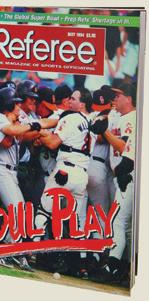
30 YEARS AGO …
1994
USSSA 3-Bunt, Attempted, 3-Foul Ball, 7-14C, 7-14F)
4 — All – b (NFHS 6-5; NCAA 10.12.2; USA Softball R/S 2; USSSA Fast Pitch Clarification and Interpretation Feb. 2018)
BASEBALL
1 — NFHS, pro – e (NFHS 1-3; pro interp.); NCAA – a (1-12 Pen., Appendix G)
2 — NFHS – c (8-2-6j); NCAA, pro – b (NCAA 5-13b; pro 5.09c)
3 — NFHS – c (7-3-5c); NCAA, pro – d (NCAA 6-2d; pro 6.03a4 Cmt.)
SOCCER
1 — All – a (NFHS 11-1-4, NCAA 11.2.1; IFAB 11.1)
2 — All – c (NFHS 11-2-1-3; NCAA 11.1.4b; IFAB 11.1)
3 — All – a (NFHS 12-9-2c; NCAA 12.7.4.6; IFAB 12.3)
4 — All – a (NFHS 12-9-1f15; NCAA 12.7.4.4.3; IFAB 12.3)
MISSION
Referee is a magazine written from an officiating perspective, blending editorial credibility and business viability. It educates, challenges and inspires officials at the youth, recreational, high school, collegiate and professional levels in all sports, with an emphasis on baseball, basketball, football, soccer, softball and volleyball. Referee is the journal of record for officiating and takes informed positions on selected issues. The magazine provides a forum for its readers, facilitates the flow of information, raises public consciousness about officials’ roles and serves as a catalyst for improved officiating worldwide.

•Former basketball official J. Dallas Shirley, 80, dies of respiratory failure. A member of the NBA’s first officiating staff in 1946, Shirley worked more than 2,000 games in his 33-year career, including numerous NIT and NCAA tournament assignments and international contests. In 1980, Shirley became the ninth referee enshrined in the Naismith Memorial Basketball Hall of Fame.

20 YEARS AGO … 2004
•The NCAA Championships and Competition Cabinet approves a plan to introduce instant replay to Big Ten conference football games. Coaches were not permitted to issue challenges; instead, a technical adviser assigned to each game was the only person able to request a replay and render a judgment.


10 YEARS AGO …
2014
•Soccer’s governing body in Cyprus postpones all matches after a bombing damages the car of Leontios Trattos, a top referee in the country. No one was hurt by the explosive device, which was placed on the hood of Trattos’ car.
REFEREE May 2024 | 85
Good Cop, Bad Cop
Baseball cops. That’s what a dear friend calls umpires.
When I took the plunge five years ago and returned to umpiring after being chased away by parents as a teenage umpire in the lawless ’90s, that friend was incredulous I was willingly choosing to join the dark side and become a baseball cop who takes all the fun out of the game. Half a decade later, I feel baseball cop is a fitting description for an umpire.
It all depends on what kind of baseball cop you choose to be.
Let’s put things into Police Academy terms. We all remember that movie franchise, right? Of course we do.

It all depends on what kind of baseball cop you choose to be.
We’re umpires. We’re old. On one side of the plate, you have Steve Guttenberg’s Carey Mahoney, a freewheeling prankster who plays by his own rules. In the other box, you have Eugene Tackleberry, played by the late David Graf as a hard-nosed, intimidating officer who follows the law to the very last letter. Both had the same training and passed the same tests to become police officers, but they took decidedly different approaches.
While I’m not about to suggest umpires start cracking jokes between innings, I believe being behind the plate in the age of umpire hate and streaming apps like GameChanger has put umpires under more scrutiny than ever, and it’s in our best interest to be more Mahoney than Tackleberry, particularly at the youth level.
What I mean by that is to channel Mahoney’s friendly, easygoing nature
toward coaches and players by being approachable. Even though umpires aren’t there to make friends, there’s nothing that says you can’t be smiling while you’re not making friends. For coaches, approachable doesn’t equal being a pushover who lets games get out of hand. It takes a little work but it is possible to strictly enforce the rules and defuse tense situations while keeping things cordial. The key (as it is in most umpire situations) is looking professional and having such a deep knowledge of the rulebook that a furious coach can be set straight with casual confidence and not a moment of hesitation.
When it comes to players, approachability along with a sense of compassion can go a long way toward parents thinking twice before complaining about your work and posting a video to Instagram with a snarky caption. All it takes is a simple gesture like saying hello to the players as you take the field or picking up a catcher’s helmet while he gathers himself after making a tough play.
Then compassion comes into play because as umpires, we see things coaches and parents don’t. It wasn’t until I got back into umpiring that I fully realized how embarrassing of a sport baseball can be. On a soccer field or basketball court, a less-skilled athlete has room to hide from the ball, but on a diamond, everyone gets a chance to stand in the spotlight with coaches and parents all yelling while a giant on the mound is waiting to take the batter’s head off.
Say what you will about the latest generation of kids being softer than ever, but they’re also growing up with more pressure than any of us had. Everything they’ve ever done on a field has been recorded while their parents are moving on from the “everyone-gets-a-trophy” spirit to expecting their kids to win for no other reason than paying a lot of money for their child to play baseball entitles them to victory.
Lost in the shuffle of this competitive madness are those endof-the-lineup kids. Their coaches will
tune them out because it’s easier to wait for them to quit than try to build them up and their parents can often be oblivious to the fact their child’s struggles at the plate run deeper than a failure to keep their elbow up. I had one of these kids last summer. In his first at-bat, he was drilled in the ribs so hard his soul nearly left his 50-pound body. Once he regained the ability to breathe, the tears started flowing and it took everything he had to stay in the game to the annoyance of his coaches who were openly joking about how getting him out of the game would increase their chances of winning.
In his next at-bat, I saw his bottom lip quivering behind the facemask of his helmet as he stood tentatively outside the box. He said, “I’m scared,” with such genuine fear. I knew I had to say something and not be Tackleberry and order him into the box. I held my hand up to the pitcher and said, “Hey, buddy. It’s OK to be scared.”
The kid stepped in and despite bailing on five pitches in a row, he worked a full count. On the payoff pitch, he summoned the courage to stick his bat out and the ball found it like a magnet. His hit was a perfectly placed 45-foot chip shot that landed on the infield grass out of reach of everyone. When the kid safely reached the bag, he was levitating and unleashed a “Let’s go!” as if he just punched his team’s ticket to Williamsport. Over the course of 60 feet, he transformed from a frightened kid into a ballplayer.
I saw that kid a few weeks later. As he confidently stepped into the box, he asked if I remembered him and I said, “You’re the kid who got that big hit, right?”
He laughed and promptly roped a clean single to left field.
Todd Munson, Los Angeles, is an umpire in the Los Angeles Rec and Parks League, Encino, Malibu and West Los Angeles Little Leagues, and the San Fernando Valley Private School League.
Do you have a personal officiating story to tell?
LAST CALL A PERSONAL STORY BY XXX 86 | REFEREE May 2024 SHUTTERSTOCK A PERSONAL STORY BY TODD MUNSON
queries to lastcall@referee.com
Send your story or














IT’S OFFICIAL may 2024







Ted Barrett to Receive Gold Whistle Award
Few better examples come to mind when one thinks of “a good official, but an even better person” than retired MLB umpire Ted Barrett. His leadership and care on an off the field are noteworthy. And so, Barrett is a fitting 2024 selection for officiating’s highest honor — the Gold Whistle Award.
The award will be presented by NASO at the conclusion of the Sports Officiating Summit in Atlanta during the annual Celebrate Officiating Gala Sponsored by Fox 40 on July 30.
“I am humbled and honored to join the long list of outstanding individuals who have received this prestigious award,” Barrett said. “I look forward to accepting the award and celebrating all of officiating at the upcoming NASO Sports Officiating Summit.”
The award is presented to an individual or group that has made significant contributions to the betterment of officiating, demonstrated a high degree of integrity and ethics — qualities that are held in high regard by the industry — ha s a consistent record of presenting officiating in a positive light, ha s exhibited a “service above self” attitude,


ha s provided public service to officiating and ha s had a motivating effect on others and/or strong community involvement.
Barrett was hired full-time onto the MLB staff in 1999 and was appointed crew chief in
2013. During his onfield career Barrett was assigned five Wild Card games, 10 Division Series, nine League Championship Series, two All-Star Games (2007, 2018) and five World Series (2007, 2011, 2014, 2018, 2021). He retired from umpiring
NATIONAL ASSOCIATION OF SPORTS OFFICIALS
1

IT’S




following the 2022 season. Off the field, Barrett was ordained as a minister in 2007 and earned his d octorate in t heology, with an emphasis in p astoral m inistry, from Trinity College and Seminary in 2013. He is the co-founder of Calling for Christ, a Christian ministry of MLB and MiLB umpires committed to teaching and sustaining umpires on and off the field. Barrett also serves on the board of Unlimited Potential Inc., a professional baseball ministry which has allowed him the opportunity to teach umpiring in Mexico, Germany and Cuba.




Closer to home, Barrett was an instructor at MLB’s inaugural Umpire Camps that were held at MLB’s Urban Youth Academy in Compton, Calif., in 2006 and was an instructor at MLB’s Umpire Camp for Marines in San Diego in 2009.


“For decades, Ted was the consummate professional and the embodiment of a crew chief as a Major League Baseball umpire,” said NASO President Bill Topp. “But much more than that, Ted continues to





be an inspirational leader for countless umpires, officials, and others in need of personal and spiritual guidance and support. His sphere of influence is immeasurable. We are fortunate to have people like Ted Barrett in our officiating industry and NASO is proud to honor him as our Gold Whistle Award recipient.”

NASO BOARD OF DIRECTORS
Robert Smith, Waterloo, Iowa, Chair
Lisa Jones, Chandler, Ariz., Vice Chair
Bill Topp, Racine, Wis., President
Dana Pappas, Lebanon, Ind., Secretary
*Bill Carollo, Shorewood, Wis., Treasurer
Sandra Serafini, Yachats, Ore.
Ron Torbert, Hanover, Md.
Mark Uyl, DeWitt, Mich.
Rob Wigod, Los Alamitos, Calif.
*Non-voting members
• Advocate
and engage in programs to recruit and retain officials.
• Create alliances with organizations that benefit from healthy officiating programs.
• Enhance the image of officials.
© 2024 NASO/Referee Enterprises, Inc. All rights reserved. It’s Official is published by the National Association of Sports Officials and Referee Enterprises, Inc.
Gold Whistle Award Recipients
In chronological order, here are the previous Gold Whistle Award recipients:



2
NATIONAL ASSOCIATION Editor: Julie
Sports Editor: Brent
Graphic Designer: Dustin Brown Contributors: Don Collins,
Alan
Joe
Tim
Brad
OFFICIAL - may 2024
Sternberg
Killackey
George Demetriou,
Goldberger,
Jarosz, Patrick Rosenow,
Sloan, Brad Star, Jeffrey Stern,
Tittrington, Scott Tittrington, Bill Topp
*Ron Foxcroft, Hamilton, Ontario, Special Adviser
*Barry Mano, Racine, Wis., Special Adviser
Dean Blandino, Santa Monica, Calif.
Paul LaRosa, Hendersonville, N.C.
Pati Rolf, Pewaukee, Wis.
NASO MISSION STATEMENT The mission of NASO is to:
• Serve members by providing benefits and services.
• Improve officiating performance through educational programs.
opportunities for officials
Find NASO @ facebook.com/NASOofficiating
1988: Art McNally 1989: Ed Myer 1990: Pete Pavia 1991: Larry Barnett 1992: Jim Tunney 1993: Steve Palermo 1994: Ron Asselstine 1995: Ed Hightower 1996: Bernie Saggau 1997: Ted Butcher 1998: Durwood Merrill 1999: Tommy Nunez 2000: Tom Dooley 2001: Paul Stewart 2002: Larry Young 2003: Bob Delaney 2004: Bob McElwee 2005: John W. Keys 2006: Blow the Whistle on Cancer Campaign 2007: Jerry Markbreit 2008: Marcy Weston 2009: Mills Lane 2010: Emily Alexander 2011: Esse Baharmast 2012: Terry Gregson 2013: Bill LeMonnier 2014: Joe Crawford 2015: Marcia Alterman 2016: Ron Foxcroft 2017: Ralph Swearngin 2018: Bill Carollo 2019: Tom Lopes 2020-21: UMPS CARE 2022: Joan Powell 2023: Violet Palmer











Summit Program to Tackle Retention in Atlanta

For the first time since 2011, the Sports Officiating Summit is headed back to Atlanta. The event will be held at the Renaissance Atlanta Waverly Hotel & Convention Center and will run July 28-30, 2024.
This year’s theme, “Sustain Officials. Retain Officials.” expands upon the shortage and recruitment themes of recent years and turns the page to retention. Many organizations have devoted incredible resources to the recruitment of new officials, now the discussion turns to retaining and succession planning for the currently active ones. Speakers will include national, state and local association leaders, active officials and many notable, invited guests from around the officiating industry.
Some of the highlight sessions of the 2024 Summit program include: Sustain Officials. Retain Officials. — It’s all about retention! This year’s event will kick off with discussion about how to effectively sustain the working official in order to retain our ranks. The 2024 Summit program will be off to a thought-provoking and motivating start.
Innovation by Invitation — Fast-paced and tech-based on the big stage. Speakers introduce, enlighten and enforce what is key about the innovation they have brought to market. Watch as dreams are fleshed out in detail at this session that can only be seen at the Summit.

Workshops: Sustaining & Retaining — Let’s get to work! Narrowly focused topics will be compiled into a vivid, dramatic picture of how to sustain and retain sports officials and the masterpiece revealed will have never been clearer.




Critical Issues in Officiating: MICP Live! — All real-life situations, all broken down by sports officiating legal and liability experts. NASO’s member-only benefit — the Member Information & Consultation Program — comes alive, as experts wrestle with today’s most challenging issues.
You Make the Call — A quick-hitting array of plays, on huge screens, presented by the supervisors/coordinators who lived through them. The perfect mix of education and entertainment. In this age of ubiquitous video-sharing, this will certainly stand out because the videos shown will be accompanied by insightful commentary.
Women in Officiating — There have never been more women in the officiating industry, but there’s a long way to go. Find out the best ways to recruit and retain female officials. This eye-opening panel session is sure to deliver valuable and long-overdue insights into this important and growing segment of the officiating community.
Referee Voices — The concept is simple: speakers under the lights, each telling a story, giving an insight, sharing a moment. Dramatic and heartrending. Not to be missed and only presented
at the Summit. Referee Voices is always unforgettable.
“We are excited about this year’s educational programming, focusing on supporting and retaining sports officials,” said NASO President Bill Topp. “Our industry spends so much time and resources on recruiting new officials — and we should — but we sometimes forget the equally important task of keeping the officials we have. The data supports the notion that improving retention numbers will help ease the nationwide shortage and improve the quality of officials. Our speakers, moderators, panelists and workshop leaders are ready to present thought-provoking ideas and lead healthy discussions on this critical issue.”
As is tradition, the annual Celebrate Officiating Gala sponsored by Fox 40 will conclude the 2024 Sports Officiating Summit. The annual banquet dinner event is the premier celebration of all the incredible works and outstanding accomplishments of the individuals and groups that make up the sports officiating community. For more information and to register for this year’s Sports Officiating Summit, visit sportsofficiatingsummit.com.
3 OF SPORTS OFFICIALS












ODA Comes Together for Annual Winter Meeting

Officiating leaders from throughout the country gathered Feb. 19-20 for the latest meeting of the Officiating Development Alliance (ODA), hosted by the NHL at its New York offices.
Attendees included Joe Fletcher, chief refereeing officer for soccer’s Professional Referee Organization; Darren Hackwood, vice president of officiating for the CFL; Erik Jaeke, director of officials for the National Intramural-Recreation Sports Association; Matt McKendry, director of umpire administration for MLB; Dana Pappas, director of officiating services for the NFHS; Joan Powell, coordinator of women’s volleyball officiating for the W5 Conference Consortium; Chris Rastatter, NCAA national coordinator of men’s basketball


officiating; Bill Topp, NASO president; Mark Uyl, executive director for the Michigan High School Athletic Association; Andrew Walker, officiating department director of education and training for the U.S. Tennis Association; and Stephen Walkom, NHL executive vice president and director of officiating.
Guests included Dave Gardi, NFL senior vice president of football operations; Raquel Wagner, MLB senior manager of umpire operations; and Gary Zielinski, NBA director of amateur officiating development.
“The ODA continues to be one of the best meetings of the year for sharing ideas and helping each other with solutions,” Topp said.
Topics of discussion included officiating pipelines, gambling
National Survey Says … Income Increase Not a Factor to Officiate for Many
It’s important for sports officials to be fairly compensated for calling games and money played a role in 38% of officials joining the avocation, but for the majority (68%), an increase in income wasn’t a reason for officiating.
Conducted during the spring and summer of 2023, the National Officiating Survey was completed by more than 35,000 sports officials from all levels and all sports. The data is available for research, study and analysis to anyone interested in the sports officiating industry at naso.org/survey.


policies, the use of data to drive decisions, replay and its impact, the next uses of technology in sports, and conflicts of interest.
“Spending time with colleagues at ODA meetings serves to not only provide an opportunity to share ideas openly and honestly but to understand how much we all have in common,” Walker said. “While our rules and structures might be different, we all share similar challenges. The ability to come together and talk through our successes and learning experiences is incredibly valuable.
“I leave each ODA meeting with a renewed sense of energy and vision.”
The next ODA meeting will take place July 31 in Atlanta in conjunction with the 2024 NASO Officiating Summit.

4 IT’S OFFICIAL - may 2024 NATIONAL ASSOCIATION










7 Things to Do While in Atlanta for the NASO Summit
The Renaissance Atlanta Waverly Hotel & Convention Center is home to the 2024 Sports Officiating Summit, presented by NASO. The event will be held July 28-30. Attendees will experience three days filled with educational and inspirational sessions from renowned names in the officiating industry.









The Waverly is located in the Cumberland community of Atlanta, just across the interstate from Truist Park, home of the Atlanta Braves, and is about 10 miles northwest of downtown Atlanta. The area surrounding Truist is booming with dining, entertainment and cultural attractions to explore, all within walking distance of the Summit.
Here are seven things to do while in the area:
1. Experience local dining and nightlife. There’s no shortage of dining options in Cumberland. The Waverly offers Tosca Blu bar and lounge, while C. Ellet’s Steakhouse and Stoney River Steakhouse are both within walking distance. If you’re looking for a drink after a long day, the Park Bench bar and ASW Distillery are nearby watering holes.
2. Shop for gifts. The Waverly is nestled within Cumberland’s expansive shopping district. Be sure to visit the one-of-akind shops at Cobb Galleria Centre or the fashion options at Cumberland Mall.
3. Explore the Battery. The Braves aren’t in town during the Summit, but these days
Truist Park is buzzing regardless of whether its team is home. Check out Truist Park’s Battery, a dedicated entertainment district surrounding the ballpark, offering dining, shopping, games, live music and more.
4. Take in a show. Experience some live theatre or film at a local Atlanta venue. The Cobb Energy Performing Arts Centre, just a 10-minute walk from the Waverly, is home to the Atlanta Opera and Atlanta Ballet.
5. Go for a hike. If you’re an outdoorsman, you’ll want to visit the Chattahoochee River National Recreation Area, located just northeast of Waverly. Cochran Shoals is the most popular unit of the park, featuring a three-mile trail apt for walking, jogging and biking.
6. Hit the links. Waverly is driving distance from several golf courses, including Fox Creek Golf Course, City Club Marietta and Cross Creek Golf Club.
7. Visit the Georgia Aquarium. While a bit of a drive from the Summit, it would be worth visiting one of the largest aquariums in the world.
For details about the NASO Summit, visit sportsofficiatingsummit.com or call NASO at 800-733-6100.

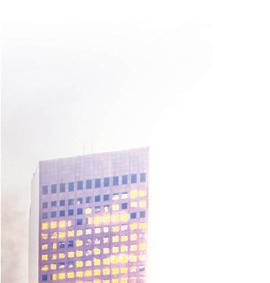











Atlanta will be the center of the officiating universe as nearly 500 of the brightest officiating administrators, supervisors, leaders and officials come together to share ideas, network and explore solutions to the critical issues facing the industry.
5 OF SPORTS OFFICIALS sportsofficiatingsummit.com atlanta georgia 07/28-07/30 2024 REGISTer now! TO LEARN MORE GO TO









NASO continues to be the leading voice for sports officials across the country. As a byproduct of that, various media, educational, government and news outlets will contact NASO for comments on matters that affect sports officials and lean on NASO for important projects across the sports officiating landscape. Officiating leaders connected to NASO are also often featured. Here are recent examples of NASO impact:
Local News Live: NASO Talks Sportsmanship
Local News Live, a division of Gray
Television
Washington News Bureau, invited NASO President Bill Topp to discuss all manner of sports officiating matters nationwide. The syndicated media group produces live breaking news, political and in-depth investigations on a broad range of topics across 114 local markets in the United States.
Anchor Debra Alfarone sat down with Topp to better inform the audience about sportsmanship, sports officiating shortages, training and education in the academic space for potential officials.
NCAA Leans on NASO for Officials Appreciation Week
The NCAA’s annual Officials Appreciation Week took place for winter sports the final week of January and highlighted the fact that the commitment

in the News

of sports officials to safe, fair and competitive contests is a critical part of the studentathlete experience.






The NCAA has implemented the NASO messaging of Say Yes to Officiating and NCAA President Charlie Baker wrote in a post on X, formerly known as Twitter, “Officiating is the heartbeat of college sports! Challenges exist aging officials & waning interest. But change is here! Explore initiatives like RefReps, Player to Ref, and more. Let’s shape the future of sports officiating together!”
Indiana Combats Shortages
The Fort Wayne, Ind -based Journal Gazette leaned on NASO for a story on officiating shortages and the approach of many organizations in the state of Indiana to combat the officiating shortages they are currently experiencing.
The publication cited the 2023 National Officiating Survey p owered by Referee. com and stated that sports officials need “mental toughness, strong people skills, knowledge of the rules and a thick skin.”
The group also highlighted a partnership with RefReps, a company offering online officiating courses that include interactive training technology. Nearly 4,000 students across 40 different states have been exposed to the benefits of sports officiating via the intro courses crafted by RefReps.
A partnership between the organization and NASO has provided these students with guides and publications produced by Referee and NASO to prepare them for what to expect in their first year of officiating, how to navigate the sports officiating industry and the best advice to succeed in this potential avocation.
Violet Palmer into Women’s Basketball HOF
Former NASO board member and 2023 Gold Whistle Award recipient, Violet Palmer, was named to the Women’s Basketball Hall of Fame and will be inducted April 27 as a member of the Class of 2024. The induction ceremony will be held at the Tennessee Theatre in Knoxville.
Palmer served on the NASO board of directors from 200508 and is currently in her 15th season as the c oordinator of women’s basketball officials for the college basketball conference consortium that currently includes the Pac12, West Coast, Western Athletic, Big Sky and Big West conferences. Prior to her coordinator roles, Palmer was assigned five NCAA women’s Final Fours and two NCAA women’s championship games. She made history as one of the first two women hired to officiate in the NBA and worked nearly 20 years in the league.
6 IT’S OFFICIAL - may 2024 NATIONAL ASSOCIATION










Are You Giving Your Members What They Want?

Are you fulfilling the expectations of your association members?
Are you providing them with what they need to be successful officials in their respective sports? There are a variety of reasons members become involved in a specific officials association. Here are seven your group can learn from.
1. Quality
In this quality-conscious age, the degree to which you’re able to sustain high standards of product quality and customer service will strongly influence your ability to grow. A great officials association provides members with examples of “doing things right” and gives them the chance to learn and grow.
2. Recommendations
Trying to solve a thorny problem? Trying to set the stage for a new project? Officials associations can often point members in the direction of solutions and strategies. They can often provide officials mentoring with or without a formal program.
3. Camps/Clinics
One of the greatest pleasures of association membership is participation in annual or bi-annual camps/ clinics — thought-provoking educational sessions led by successful peers, as well as


regionally and nationally recognized experts. If your association doesn’t provide a camp or clinic, consider adding one.
4. Unity Officials are never alone when they join an association. Membership gives officials the opportunity to speak with a single voice on matters of importance to the officiating industry, including education, sportsmanship and recruitment.
5. Vision
A wise sage once said that the characteristic of a true leader is the ability to mobilize toward the future. A quality association helps officials visualize the opportunities that lie ahead and find the tools necessary to turn opportunities into sound plans. Associations can help members climb the ladder.
ASSOCIATION ADVANTAGE
Running a local officials association is demanding. You volunteer your time and effort to make it the best you can. But there’s no reason you have to do it alone. NASO Association Advantage exists to help you face any challenge and elevate your association in the process. Whatever challenges you have — training, insurance, legal issues, meeting help, bylaws and organization, membership issues and more — WE HAVE A SOLUTION TO MEET YOUR NEEDS.
PLATINUM & PLATINUM SHIELD
Association Advantage Platinum is the premier resource for maximizing the performance of your group, providing leadership and administrative resources to help you elevate your organization with a focus on training,


FROM OUR DATABASE

6. Education

An increasing number of associations provide a variety of educational materials and public service programs to educate new and veteran officials. Today’s youth will become the leaders of the industry in the years ahead; association membership helps bring leadership to fruition.
7. Zest
There’s something special about celebrating successes and triumphs with likeminded people, achieving recognition for the good work you’ve done, and feeling satisfaction of true accomplishment. Those are the true rewards. Officials association membership helps officials make the most of their triumphs and provides direction to achieve more.
assigning, legal issues and best practices specific to local officials association management.
TITANIUM & TITANIUM SHIELD
The Titanium solution is ideal for officials associations that want to maximize their organization’s performance while fully protecting both their organization and individual members.
DIAMOND
The most comprehensive solution for officials associations that want to fully protect both their organization and individual members, as well as provide full training and testing solutions with an emphasis on video. Association Advantage Diamond is the ultimate answer to every challenge your association faces.
To learn more, go to NASO.org/Advantage or call us at 262-632-5448
7 OF SPORTS OFFICIALS












Legislation Moves Forward in Pennsylvania, Ohio and Washington

Every year, a variety of states pursue legislation to protect sports officials. To address the shortage of officials and combat the decline of sporting behavior in recent years, legislators are making real efforts to show support to the men and women who are adjudicating the rules. While many of the proposed bills die in committee, a few states have passed laws in recent years. Arkansas, Hawaii and Texas passed legislation in 2023.
Most recently, Pennsylvania, Ohio and Washington have all taken a step forward with proposed legislation by passing it in one side of their state’s legislature.
Pennsylvania Senate Bill 842, known as the Respect the Whistle Act, passed the Pennsylvania Senate Oct. 25, 2023, with overwhelming bipartisan support of 48-2. The legislation would amend Title 18 of the Pennsylvania




Consolidated Statutes by adding a section that defines harassment of a sports official.
NASO worked with State Senator Jimmy Dillon, the bill’s primary sponsor, and his staff to promote the effort and educate sports officials in the state about the bill and the benefits for themselves and the industry. The Pennsylvania Interscholastic Athletic Association (PIAA) also supported the awareness effort.
The bill has moved to the House of Representatives for consideration alongside with its House companion Bill 297. It is currently in the House Judiciary Committee.
Ohio House Bill 139, which would increase assault penalties in the state if the victim is a sports official, passed last Nov. 29 with representatives voting 70-6 in favor of the bill. Leaders from the Ohio High School Athletic Association testified in support of the bill earlier in 2023. The bill is currently in the Senate Judiciary Committee.

A similar bill, focusing on protecting officials, passed the House in 2021 but died in a Senate committee.
Washington House Bill 2079 called for protecting officials through improving school safety by extending and increasing penalties for interference by, or intimidation by threat of, force or violence at schools and athletic activities. The bill passed the House with a 97-0 vote with one representative excused.
The Washington Officials Association, the Washington

To address the shortage of officials and combat the decline of sporting behavior in recent years, legislators are making real efforts to show support to the men and women who are adjudicating the rules.

Interscholastic Athletic Association and NASO provided support for the bill, along with individual officials. NASO President Bill Topp gave written testimony which in part stated, “I can’t guarantee you that legislation will stop bad behavior in its tracks. It won’t. And I can’t prove to you that sports officials assault legislation will reduce assaults in your state. What I can guarantee you is that the support for sports officials has never been more needed. We are under attack and if we don’t turn the sports atmosphere around soon, sports at the amateur level are in jeopardy. Please support this legislation.”
Unfortunately HB 2079 was sent to the Early Learning & K-12 Education Senate Committee following its passing and the committee refused to have a hearing on the bill. The positive news is that the stakeholders who pushed for legislation are committed to pursuing it again in the next session
8 IT’S OFFICIAL - may 2024 NATIONAL ASSOCIATION
SAYYESTOOFFICIATING.COM
& retention
The free resource for recruitment












sports section


STAY PRESENT
By Bob Delaney (with Todd Rose)
Distraction is defined as a “thing that prevents someone from giving full attention to something else”.
During my years as NBA v ice p resident of referee o perations and d irector of o fficials , I read a book titled , The End of Average It was a book I devoured in a couple of days. I wanted to meet the author, Todd Rose. At the time , Rose was a Harvard p rofessor who was consulting around the world. I asked one of my staff members to see if he could get past the “gatekeepers” and within a day I was on the phone with the p rofessor. I started a fastpace d elevator pitch explaining who I was and requesting his neuroscience knowledge in helping referees improve. He cut me short and said with a laugh , “Bob, I was in the Utah (Jazz) arena the night you ejected Jerry Sloan . I’m all in.”
Our friendship began and continues to this day.
Rose helped the NBA referee staff understand how to be in the present and not allow the past to cloud decision making. Sport officials know that “letting go” of that questionable call, so one incorrect call does not become another and another, is vital.
Rose and I reviewed game film and we discussed the



unnecessary signals referees use at times and how that keeps them in the past and not focused on the present.
Shifts take place in every profession and for those more “veteran” we can recall the days when physical conditioning was not at the level it is today. Now, while part of the fitness push was for appearance , there was also an understanding that with higher fitness levels come less fatigue and with less fatigue ,
“Now, this performance cost may not matter when we are splitting attention between watching television and scrolling social media B ut the equation changes dramatically when it occurs in high focus , high responsibility positions like officiating. These positions demand both the rapid processing of complex sequential information and a constant focus on the task at hand. Here, the ability to stay ‘ present ’ can mean the
Successful officials usually have learned how to be comfortable in the uncomfortable and stay present during game action.
better decision - making.
Successful officials usually have learned how to be comfortable in the uncomfortable and stay present during game action.
Rose explained this at an even deeper level : “One of the most important insights of cognitive neuroscience is the fact that our brains cannot multitask. This may seem counterintuitive, given that multitasking seems to be a way of life today, but the truth is that we can only pay attention to one thing at a time and every time we ‘ task switch’ it comes at the cost of increased reaction times and decreased performance.
difference between success and failure.
“Whether signaling a blocked shot with two hands together (indicating ‘ no foul, good block ’ ) or pointing to the floor (indicating the pivot foot did not move), the problem is the same: the act of signaling a non-call pulls attention away from processing action in the here and now, effectively freezing the mind on the past, which means the referee is not ready for the next action , ” Rose said.
Today more and more technologies are available to the offic iating community W hile some leagues have referees or umpires verbally
OF SPORTS OFFICIALS NATIONAL ASSOCIATION OF SPORTS OFFICIALS
9

IT’S OFFICIAL - may 2024




explain ing decisions , the majority of an officiating crew’s communication is with signals. Signals are outlined in officiating manuals and are designed to clearly communicate with all those participating and watching. Mixed signals given to our minds may prevent the full attention needed to the play action before us.




that caring for you allows you to be the best you can be and that , in turn , makes the officiating team the best it can be.
Stay p resent!






Change comes through awareness and 21st Century s port o fficials need to have a higher understanding for m ental c onditioning/rehearsal, m ind h ealth, resiliency and s elf - care.
Mental c onditioning is much like physical conditioning in that it can be increased and made stronger through education and training. There needs to be a process that directs thoughts, attitudes and beliefs in an attempt to accomplish peak performance.
Mental r ehearsal is the use of imagery versus actual actions in an attempt to accomplish peak performance. It is not about performing one specific outcome ; it is about accomplishing multiple positive outcomes.
Mind h ealth is a term we use versus m ental h ealth because m ental h ealth conjures up the thought of m ental i llness. We think of m ind h ealth as another form of fitness — a n overall wellness of thoughts, attitudes, behaviors allowing for a balanced approach.
Resiliency refers to the capacitie s /abilities to adapt to stressful situations and/or cope with difficult situations. Some may say bounce back or bounce forward.
Self-care does not mean selfish . I t is the understanding
Bob Delaney, a former NBA referee, NBA Referee Operations executive and NASO board member, is currently the SEC special advisor of officiating development/performance and an author. Todd Rose, former professor and director of the Mind, Brain, and Education program at Harvard University, is a bestselling author and currently the CEO of Populace.
BASKETBALL
Where’s the Ball?
The following has been excerpted from High School Basketball Definitions: The Key to Understanding the Rules , which is available at store. referee.com .
Knowing the legally defined frontcourt and backcourt is crucial for understanding the ball location (status) and making accurate rulings regarding backcourt violations. A ball in contact with a player or with the court is in the backcourt if either the ball or the player (any player if the ball is touching more than one) is touching the backcourt. A ball in contact with a player or with the court is in the frontcourt if neither the ball nor the player is touching the backcourt. Also, during a dribble from backcourt to frontcourt, the ball is in the frontcourt when the ball and both feet of the dribbler touch the court entirely in the frontcourt.
Let’s break that down a little
bit further. If a ballhandler for team A is in contact with the ball and has one foot on each side of the division line, by definition, the ball location is in the backcourt and the player has backcourt status. That ball location does not become the frontcourt until neither the ball nor the player is touching the backcourt. In order for that to happen, the player and the ball must not be touching the backcourt in any fashion. In other words, the player and the ball must clear the nearer edge of the division line to his or her team’s own basket.


A handy cheat phrase to make sure a player and the ball have transitioned from backcourt to frontcourt status is “three points.” If all three points (the ball and both of the player’s feet) are in the frontcourt, the ball and player have obtained frontcourt status. If any of the points remains in the backcourt, the ball and player still have backcourt status.
Play: A4 is dribbling the ball up the floor. A4 ends the dribble with one foot on each side of the division line. A4 then uses the foot on the backcourt side of the division line as a pivot foot, and pivots so that both feet are now on the backcourt side of the division line. Ruling: Legal play. As long as one of A4’s feet never crossed the division line into the frontcourt, A4 and the ball maintain backcourt status. A4 can pivot as often as desired and the non-pivot foot can cross the division line repeatedly without violating.
Conversely, if the ball and player are in the frontcourt and either the ball or player makes any contact with the division line, the ball and player now have backcourt
10 NATIONAL ASSOCIATION




status, as the nearer edge of the division line to his or her team’s own basket has been penetrated. If all of the additional elements for a backcourt violation are present, then a backcourt violation should be ruled.


Play: A1 is holding the ball in the frontcourt. A1 passes the ball to A2, who is in the frontcourt near the division line. As A2 prepares to start a dribble, A2 establishes the left foot as the pivot foot and steps backward with the right foot, making contact with the division line. Ruling: Backcourt violation. As soon as A2 makes contact with the division line, both A2 and the ball now have backcourt status.
BASEBALL
No Sore Throats
By the Referee editors
Perhaps nothing is scarier as a plate umpire than seeing a pitch bounce in the dirt, hop up over the catcher’s shoulder, and having it catch you in the neck or throat. Yes, getting hit by a ball while working the dish is never fun, but when you take one off the shoe, the chest protector or the mask, it is rarely life-threatening.
However, contact with the throat presents a unique set of problems, especially if the ball catches your windpipe. Besides it simply hurting and being uncomfortable, there is the very real possibility of breathing problems if the windpipe is somehow damaged.
Some umpires say you don’t need a throat guard when working the plate because the mask extension, or “rake,”






is long enough to cover the throat. While this is generally true for balls that come in straight, it is not true for balls that are deflected at an angle. Balls that bounce first in the dirt, foul balls from low pitches and deflections off the catcher (or even the batter) are all very real possibilities.
First, understand a basic principle of throat guards for umpires. The throat guard will reduce, but not eliminate, the natural gap between your guard and chest protector that occurs while you are in your umpire stance.
The main objectives of the throat guard are to minimize that gap and to deflect the force of an errant ball away from your throat and to your chest protector. And, like any other piece of protective equipment, for it to be effective, it must be worn properly.
Why You’re Wearing It Wrong
The problem with throat guards is umpires make two critical mistakes. These mistakes either make the guard ineffective, or worse, cause injury:
1. Attaching the throat guard to the wrong bar.
2. Not choosing one that’s long enough.
Here’s how to fix these two issues.
Attach to the Correct Bar
You want to attach your throat guard to the bar one up from the bottom.
There are two reasons why the bar one up from the bottom is better (apart from the fact that it looks better and flops around less):
1. There is a bigger gap if you put it on the bottom bar because umpire mask


extensions jut outward by nature to allow movement of the head.



2. If you get hit while the throat guard is on the bottom part, the slack from the attachments could slide up the outer bars and collapse inward. This could cause the top of the throat guard to hit your throat with the full impact of the baseball behind it.
Make Sure It’s Long Enough
When the throat guard gets hit by a ball, you want it to be long enough so the throat guard hits your chest protector, not your throat.
Generally, a 6-inch throat guard has a better chance of doing that than a 4-inch throat guard. However, a 4-inch throat guard might suffice depending on your stance.
You can test this by trying the following:
• Put your throat guard on your mask.
• Wear your chest protector.
• Find a mirror or have someone help you.
• Get in your stance.
• Move the throat guard inward.
If the throat guard misses your chest protector and touches your throat, it is not long enough.
If it hits your chest protector, your throat guard can protect you. You are good to go .
SOFTBALL
Time’s Up
By the Referee e ditors
One of our jobs is to keep the game flowing. This is especially true when it comes to conferences. Too often, we
11 OF SPORTS OFFICIALS

IT’S OFFICIAL - may 2024




allow coaches to take too much time to deliver the message and we don’t get the game restarted again in a timely fashion. This is part of the game we can control and keeping on top of this helps to keep games from dragging. It also makes sure one team does not gain an advantage by slowing down the other team’s momentum.

All offensive and defensive conferences must be recorded and it is our duty to track them. Write down the team, the inning and who was involved. Either use the backside of the lineup card to track each team’s conference or design your own template and print out cards to take with you on the field. For high school and travel ball, the lineup card is probably your best option. For collegiate play, where there are different rules, it is best to print out your own conference tracker to make sure you are accurate in your recording — especially since the penalty for taking an additional conference when not allowed is an ejection.
When it comes to tracking conferences, be consistent yet appropriate with the time allowed for a conference. Take out your card, write down the information, brush off the plate and then focus your attention on breaking up the conference. The amount of time it takes to write all the information down, brush off the plate and then walk to the pitcher’s circle or coach’s box is enough time for the coach to deliver the message. Most coaches will not break up the conference until you go out to them. Do not expect them to just end the conference because you finished brushing the plate off. Do not allow one team much more time than the other team.
Defensive conferences are





usually longer than offensive conferences. Game situations can determine the amount of time allowed for a conference. If the conference is not ending after a reasonable amount of time, break it up. For a defensive conference, walk purposefully to the pitcher’s circle (or wherever the huddle is) and ask: “Are you about ready?” Do not leave until the conference breaks up and do not return to the plate without the catcher. For an offensive conference, walk purposefully to where the huddle is and ask: “Are you about ready?” Do not leave until the conference breaks up and do not return to the plate without the batter. Remember, sometimes coaches are there to disrupt the pitcher’s rhythm or slow down an offensive team that has rattled off a lot of hits in a row. Coaches will take as long as you give them in these instances.




getting a “free” conference. When it comes to injuries, allow the coach and training staff ample time to make sure the player is healthy enough to continue. Do not rush this process.


Do not charge either team with a conference if performing your umpire duties causes the initial delay of the game. When you are ready to resume play and teams are still conferencing, advise them that it is time to play ball. If they do not respond immediately, then ask if they would like a conference (if they have one remaining).
If one team requests a conference, the other team may meet and is not charged a conference as long as that team is ready to go when the initial team requesting a conference is finished.
If a possible injury occurs on offense or defense and the coach wants to check on the player, go with the coach. Hover close so you can hear what is being said, but stay far enough way so it doesn’t feel like you are intruding. If the talk turns to game strategy, ask the coach if he or she wants a conference. If the coach does not want a conference, instruct the team to play ball. If a defensive player requests time to fix or replace equipment, go to the dugout with her and monitor the situation. If an illegal pitch has been called and you are asked to tell the pitcher what made the pitch illegal and the coach is present, an umpire must stay until the discussion is over and the coach leaves the field. This prevents the defensive team from talking strategy and
Be proactive. Do not allow a team to violate the conference rule. Tell them, “Stop!” or “Wait!” Come between them and their target. Do what is necessary to prevent a violation of the conference rule. Preventive umpiring will save you a lot of headaches.
SOCCER
POSTGAME WRAP
By Grier Cooper
The referee team walked away from a game unscathed, or did they? Postgame selfanalysis can be the key to understanding crew or individual successes or failures during a game. Postgame debriefing helps the referee team to better prepare for the next assignment. It’s a time to look in the mirror and be honest about actions and
12 NATIONAL ASSOCIATION



decisions made during the game.


Every member of the referee team should want to be active in the discussion and look forward to doing so. All referee team members should have something to discuss, be prepared to offer comments and provide suggestions for “doing it better.”




upon arrival all the way through departure?


Finally, review individual and crew demeanor :

• Did we demonstrate poise and proper control especially during critical moments?
• Did we display teamwork throughout the game?
• Did we hustle throughout or were there lapse periods?




Some postgame talking points could include:
• Did we follow the pregame plan?
• Did we ensure player safety?
• Did we know, understand, interpret and apply the rules of this game?
• Did we use proper mechanics and work as one unit?
• Did we adhere to the fairness principles?
• Did we use correct signals and the ones agreed to during pregame?
• Did we anticipate play and react accordingly to game situations?
• Did we handle unusual events (card situations, fighting, goalkeeper violations, etc.)?
• Did we demonstrate decisiveness or were we timid during a critical time of the game?
The referee team should go over physical actions:
• Did we demonstrate being physically fit?
• Did we anticipate and move in advance into proper positioning?
• Did the a ssistant referees follow all balls to goalline?
• Did the referee sprint during reversals and counterattacks?
• Were we properly attired and did we look professional
• Did we act in a dignified and civil manner with players, coaches and bench personnel especially during times when coaches were dissenting or creating problems?
• Did we display good nonverbal skills when dealing with players, coaches or bench personnel?
• Did we communicate professionally, effectively, and objectively when talking to players, coaches, bench personnel or other game officials?
Dedication to the game and achieving excellence, a referee team’s performance requires the team to review and learn at every opportunity. Looking beyond the current match, the team should discuss “what’s next” for the crew.
Discuss as a crew:
• Based on the results of this game, are we ready for higherlevel , more competitive games?
• Is the entire team or any individual member of the crew ready to perform at a postseason level?
• Are any of the members of the team “maxed out” at the current level of games?
• What stories will be told about our actions during this game by players, coaches and even other officials?
It is hard to be honest with each other sometimes, especially if working with an
unfamiliar crew. However, if there is a referee who feels they should be working higher-level games and really does not have the skill set, the postgame debriefing is an opportunity to discuss the shortfalls and why the referee remains at the same level. Also, this is a time to discuss how the referee could improve by utilizing different skills and abilities. Making incorrect or indecisive calls on a regular basis creates frustration for the players and leads to dissent from the coaches. Talking to each other in a safe place will go a long way in improving performance.

Every referee needs to review and then review again each game that is officiated. You owe it to yourself, the game, players, patrons, referee partners and the leagues or institutions that hired you. After the final whistle, the referee team should be proud of their role each game and sleep well at night when thinking about the performance.
Grier Cooper, Phoenix, is a former NISOA National Referee Program Administrator and National Assessor.
ASK US
FOOTBALL
Illegal Snap
Play: Fourth and 10 from team K’s 20 yardline. Snapper K1 initially moves the ball forward, then attempts to snap it. After the backward motion of the snap begins but before K1 releases the ball, noseguard R2 reaches across the neutral zone and knocks the ball out
13 OF SPORTS OFFICIALS





of K1’s grasp. R3 recovers the loose ball. Ruling: Under both codes, when K1 initially moves the ball forward, it is an illegal snap and the ball remains dead. Anything that subsequently occurs is ignored unless it is a personal foul (NFHS 2-40; NCAA 2-23, 7-1-3a-2).

Blocking the Kicker
Play: After K1’s free kick and while the untouched kick is in flight downfield, R2 blocks holder K3 at team K’s free-kick line. The block is above the waist and from the front. Ruling: R2 has committed an illegal block. The kicker (NFHS only, or holder) of a free kick may not be blocked before he has advanced five yards beyond his free-kick line or the kick has touched the ground or any other player. The penalty is 15 yards (NFHS 9-3-4 Pen.; 9-1-16c).
BASKETBALL
Legal Guarding Position
Play : A1 starts a drive from outside the three-point line, beats defender B1 and continues toward the basket. Opponent B2 begins to move to help defend A1 about five feet in front of the basket. B2 moves into a position in front of and facing A1 while having both feet on the floor, and then A1 (a) takes one final step and goes airborne, or (b) immediately jumps to become airborne. While airborne, A1 makes contact with B2’s torso, releases the ball on the try, and the contact knocks B2 to the floor. Who shall be charged with the foul? Ruling : In NFHS and NCAAW, when the opponent with the ball is airborne, the defender must obtain legal guarding position





before the opponent left the playing court. In both (a) and (b), defender B2 obtained legal guarding position before A1 became airborne, so the result is a player-control (NFHS) or offensive (NCAAW) foul on A1 (NFHS 4-23-2, 4-23-4b; NCAAW 10-4.4). In NCAAM, when the opponent with the ball is airborne, the defender must have obtained legal guarding position before the opponent places the last foot on the playing court prior to becoming airborne. In (a), B2 obtained legal guarding position before A1 placed their last foot on the playing court prior to becoming airborne, so the result is a playercontrol foul on A1. In (b), B2 obtained guarding position after A1 placed their last foot on the playing court prior to becoming airborne, so the result is a blocking foul on B2 (4-17.4).




helmet is removed from play (NFHS 1-5-6; NCAA 1-15 Pen.; pro 3.08 Cmt.).
All Undone

Play: With the bases loaded and one out, B5 hits a line drive to the right-field fence. R3 and R2 both score, but R1 is thrown out at home. B5 safely arrives at third but missed first base. The defense properly appeals B5 missing first base. Ruling: No runs will be scored. No runs can score when the batter-runner is the third out and does not reach first safely (NFHS 9-1-1 Exc. d; NCAA 5-6c Exc. 1; pro 5.08a Exc 1).

BASEBALL
No Touch
Play: With one out and R1 on first base, F4 allows a fair fly ball to drop untouched to the ground. Ruling: The ball stays live and no one is yet out (NFHS 8-4-1c1; NCAA 7-11q Note 1; pro 5.09a12 AR).
One Short
Play: The visiting team has only eight players show up for a game. Ruling: The game cannot begin until the team has at least nine players (NFHS 4-4-1f; NCAA 5-12g; pro 7.03b).
Humpty Dumpty
Play: B1 enters the batter’s box with a helmet that is cracked. Ruling: B1 is instructed to secure a legal helmet and the damaged
SOFTBALL
Catch and Carry
Play: With one out and R2 on second base, B3 hits a fly ball down the right-field line. The ball continues to hook as F9 leaps from liveball territory, makes the catch and then lands in dead-ball territory. R2 was standing on second base attempting to tag up when R9 makes the catch. Ruling: In all codes, that is a catch and carry. The ball is dead, the batter-runner is declared out and R2 is awarded third base (NFHS 2-9, 8-4-3h and Pen.; NCAA 9.2, 9.4 and Eff.; USA Softball 1-Catch/No Catch, 8-5J and Eff.; USSSA 3-Catch, 8-14D-5).
Batter-Runner Interference
Play: With one out and R3 on third, B3 hits a ground ball to F6. F6’s throw to F3 retires B3. F3 steps off first base and takes a step toward home plate in fair territory to make a throw home as R3 tries to score. As F3 releases the throw, B3 collides with her, causing the throw to sail
14 NATIONAL ASSOCIATION
IT’S OFFICIAL - may 2024








offline. F2 catches the ball, but the tag on R3 is late. Ruling: In all codes, that is interference by a retired runner and the ball is dead at the time of the interference. B3 is out on the initial play and R3 is ruled out due to B3’s interference with F3 (NFHS 8-6-16c Pen.; NCAA 12.17.3.1 Eff.; USA Softball 8-7P Eff.; USSSA Softball 8-18H Note 2).
Leaving Early


(NFHS 12-1-f7; NCAA 12.4.3.5; IFAB 12.3).
Scissor Trouble






Play : With two outs and an 0-2 count on the batter, R1 tries to steal, but leaves early. The pitch is ruled a strike by the home plate umpire. Ruling: In NFHS, USA Softball and USSSA, the ball is dead at the moment R1 leaves early and no pitch is declared. R1 is ruled out for leaving early and the same batter will come up to start the next inning (NFHS 8-6-18 Pen.; USA Softball 8-7S Eff.; USSSA 8-18K). In NCAA, leaving early is a delayed dead ball and the defensive coach has the option of taking the result of the play, which would be a strikeout on the batter, or “No pitch” is declared and the offending runner is out (12.14.2 Eff.).
SOCCER
Bad Throw-in
Play: Team A is awarded a throw-in. A1 takes a proper throw-in and realizes that B2 will reach the ball prior to one of A1’s teammates and provide a promising attack for team B. A1 runs to the ball and kicks it away. Ruling: The referee stops play and awards an indirect free kick for team B at the point where A1 touched the ball before it was played by another player. A1 is cautioned for stopping a promising attack
Play: Defender B1 is marking inside the penalty area when A2 crosses the ball toward A3 who is directly in front of B1. B1 makes a scissors kick to clear the ball from the penalty area. A3 has to move back quickly to avoid being struck in the face by B1’s cleats. Ruling: The referee should stop play and award an indirect free kick for team A at the point the scissors kick occurred. B1 created a dangerous situation by lifting the leg near A3’s face. If the incident occurred less than 10 yards from the goal, the wall may set up on the goalline between the goal posts (NFHS 12-6; NCAA 12.2.9.1; IFAB 12.2).
Field Size


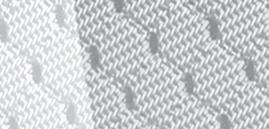













Play: During the pregame field inspection, the referee crew determines the field dimensions are 108 yards long and 68 yards wide. Ruling: For a match played under NCAA rules, this is an illegal field. The minimum length should be 115 yards and the minimum width 70 yards. The match could be played if the visiting team was notified in writing of the dimensions prior to the match and still agreed to play. If not, the match is not to be played and the referee is to submit a report to the governing sports authority. For matches played under NFHS rules, the match would be allowed. The NFHS rulebook indicates that the highly recommended field dimensions are 110 yards long and 65 yards wide. This is not a mandate. IFAB would allow the match since the Laws of the Game have minimum and maximum standards. The

15 OF SPORTS OFFICIALS
Easy & Convenient Auto Renewal Go to www.naso.org Click on join/renew Log into your account Check the automatic renewal box Enter payment information Hit the renew button Never Let Your Insurance Lapse!





minimum size of a field is 100 yards long and 50 yards wide. The maximum is 120 yards long and 90 yards wide.
VOLLEYBALL

Vertical Plane
Play: Player A1 is near the net, attempting to save an errant pass from the libero. The entire ball crosses the vertical plane beneath the net. A1 manages to return the ball to team A’s side and then A2 attacks the ball which lands inbounds on team B’s court. The first referee signals loss of rally and awards a point to team A . Ruling: Incorrect ruling in all codes. A player may return a ball that has penetrated the vertical plane of the net over or below the net only if the ball has not





completely crossed the vertical plane of the net when the contact is made. In this case, this is a violation and team B should be awarded the loss of rally/point (NFHS 9-4-4a; NCAA 15.1.3.1; USAV 10.1.1.1).

Uniforms
Play: Team A is wearing multi-colored white uniform tops with a solid black stripe that goes down the side panels along with solid yellow shorts. The libero for team A is wearing solid yellow shorts with a multi-colored black uniform top with solid white stripes that goes down the side panels. The first referee rules team A’s uniforms illegal because none of the players on team A are wearing a solid-colored uniform top. Ruling: Incorrect. Solid-colored uniform tops are not required.



The libero’s top contrasted from that of his/her teammates (NFHS 4-2-1a & 4-2; NCAA 7.1.1.1 & 7.1.1.2; USAV 4.3.1).
Collective Block

Play: During a rally, A1, A2 and A3 all jump as part of an attempted collective block. A1 and A2 are front-row players and A3 is a back-row player. There is a completed attack by B4. The ball completely misses the block and a defensive save is made by the team A libero. The first referee allows the play to continue. Ruling: Correct procedure in all codes. Since the ball was never contacted by any player who was part of the attempted collective block, no violation has occurred and play should continue (NFHS 9-5-1c-3; NCAA 14.6.1.3; USAV 14.1.4).

The National Association of Sports Officials (NASO) is a nonprofit, educational association providing services and benefits for sports officials. It is run by officials, for officials. If you know a good candidate for membership, please send us his or her name and address. We will forward an invitation to join. For more information contact 262-632-5448 or naso.org/membership.
Chief
Cliff
DVSport Software Inc.
Eagle Tax Res
Fox 40 International
Fox40Shop.com
Gamekeepers
Georgia Athletic Officials Association
Georgia High School Association
Gulf Coast Conference
Honig’s
Hudl
IAABO Inc.
Illinois High School Association
Indiana High School Athletic Association
Iowa High School Athletic Association
Kansas State High School Activities Association
Kentucky High School Athletic Association
Louisiana High School Athletic Association
Louisiana High School Officials Association
Major League Baseball
MIBT Media
Michigan High School Athletic Association
Mid-American Conference
Minnesota State High School League
Missouri State High School Activities Association
Missouri Valley Football Conference
National Association of Intercollegiate Athletics
NBA
NCAA
Nevada Interscholastic Activities Association
New Mexico Officials Association
N.Y. State Public High School Athletic Association
NFHS
NFL Foundation
NFL Officiating Department
NFL Referees Association
NHL
NHL Officials Association
Officiating Collective
Ohio High School Athletic Association
Oklahoma Secondary School Activities Association
Oregon Athletic Officials Association
Oregon School Activities Association
Pac-12 Conference
Pac-12 Football Officials Association
Professional Association of Volleyball Officials
Professional Referee Organization
Purchase Officials Supplies
QwikRef Inc.
Referee Enterprises Inc.
RefReps
Reveal Media
South Dakota High School Activities Association
Southern California Intercollegiate Athletic Conference
Southeastern Conference
Sports Officials Care
Sun Belt Conference
Texas Association of Sports Officials
Texas High School Basketball Officials Association
U.S. Center for Safe Sport
Ultimate Fighting Championship
Ump-attire.com
UMPS CARE Charities
United States Polo Association
United States Tennis Association
University Interscholastic League - Texas
USA Cheer/STUNT the Sport
USA Hockey
USA Softball
USA Volleyball
US Youth Soccer
Vokkero by Adeunis
Washington Interscholastic Activities Association
Washington Officials Association
West Coast Conference
W.Va. Secondary Schools Activities Commission
Wisconsin Interscholastic Athletic Association
16 IT’S OFFICIAL - may 2024
Your Company Can Help Improve the Quality of Officiating Become an NASO Education Partner Today! NASO EDUCATION PARTNER PROGRAM MEMBERS: Alabama High School Athletic Association American Specialty Insurance & Risk Services Inc. ArbiterSports Arizona Interscholastic Association Atlantic Coast Conference Big 12 Conference Big East Conference Big Sky Conference Big Ten Conference
West Conference
Basketball Officials Association
Interscholastic Federation
Section
Football League
Sport
Big
California
California
CIF-Southern
Canadian
Capelli
Zebra Enterprises
Keen Athletic College Football Officiating LLC
Officiating Consortium
High School Activities Association
Club Elite
- Collegiate Commissioners Association
Collegiate
Colorado
Court
D-II









































































































































































































































































































































































































































































































































